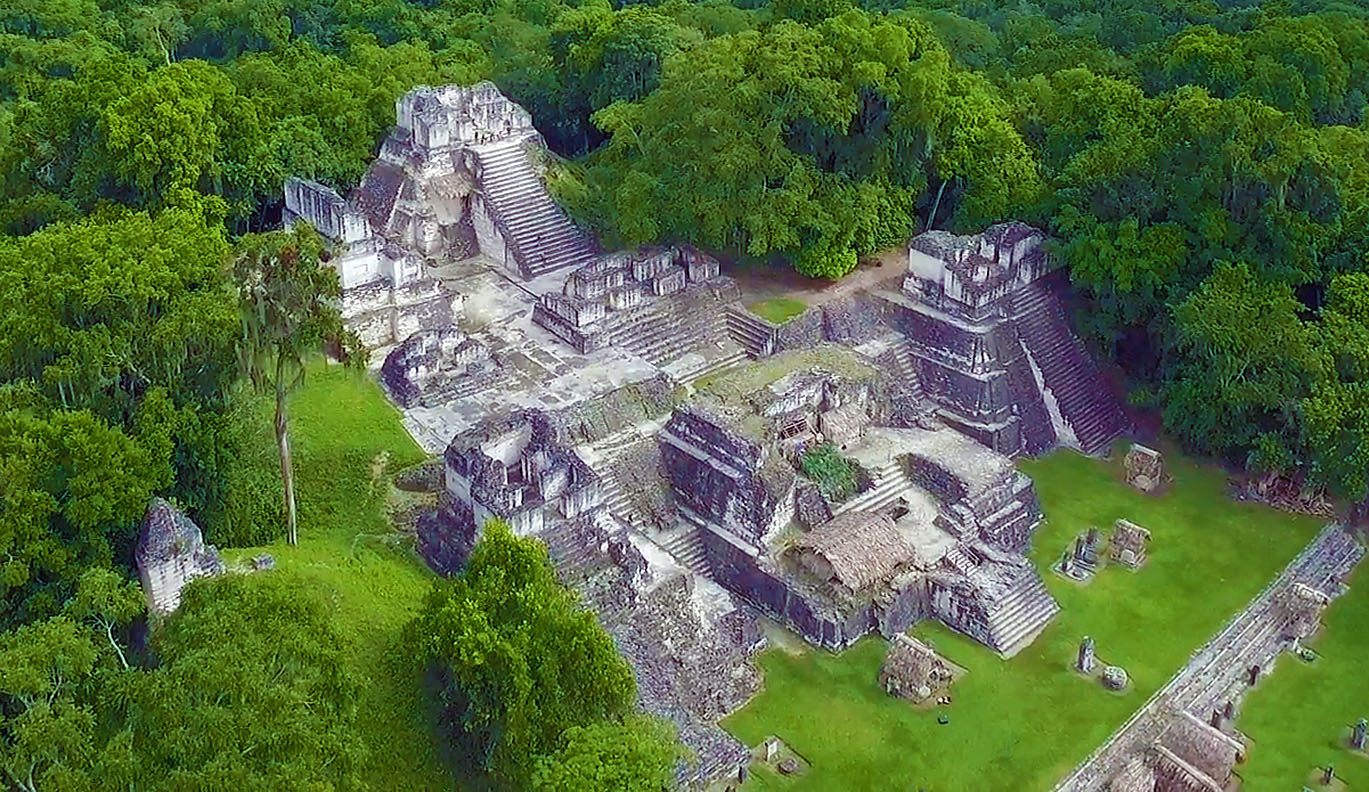It is volume 30 (29 28 27 26 25 24 23 22 21 20 19 18 17 16 15 14 13 12 11 10 9 8 7 6 5 4 3 2 1 0)
This is a part of a raw and uneven journal of digging into the writing systems from all over the world, so I recommend you to read the summary of this work instead.
Is it possible that mayan and chinese hieroglyphics have common roots? Both went in columns, only mayan used two characters, chinese used one, but if we look at how chinese hieroglyphs are consisting of several symple ones, there are hardly ever more than two "columns" in those hieroglyps, one half is ideographic, the other is phonographic. Did mayans by any chance write them like that? Are some mayan hiegroglyphs more likely to stand at the right or the left position of the column?
I'm sorry for the noob questions, I know that they're not recognized relative, but let's find something common about them. All chinese hieroglyphs are one syllable long, even if they have dyphthongs. Mayan also consist of several elements, but they read each element directly, not mashing them all to one syllable, as chinese do: 五 is go, and 語 is go (but it is japanese, in chinese 五 is wǔ and 語 is yǔ)
Did they have some more relaxed way to write hieroglyphs? but where would they have only few codices where I didn't notice anything cursive-like, but maybe on some mountains some mayan graffiti only specialists know about..
I research writing systems in general, looking for their inner structure, so it will take me some time to master mayan writing system. I studied some hieroglyphics between these letters, I'll study it some more.
Do you by any chance have some bilingual texts? I was looking for them and this is the closest to it I could find.

(these are two letters I sent to a couple of mayan researchers, instead of jumping onto them with "my thang" I explore their understanding with questions, for that Brian Tracy from the finale of the previous volume taught to ask, so I did, changing my ways to achieve different results (so far my communication with academic medium was rather unsatisfactory, but then I didn't apply as much of effort other applicants have to contribute, believing in being special, I expect some good fairy to appear from those ranks, let's not be naive or profane)
plural form of codex is codices (i~e, ks~ts (ц~x? uvw-xyz уфх-цчш. it is funny and I wonder if russians preserved the position of W in the omega's position? υφχψω)
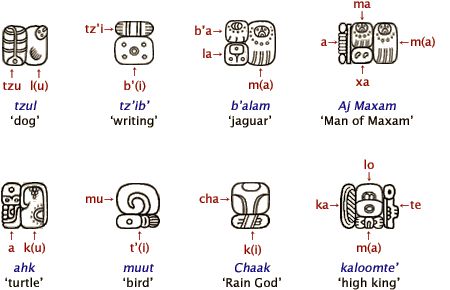
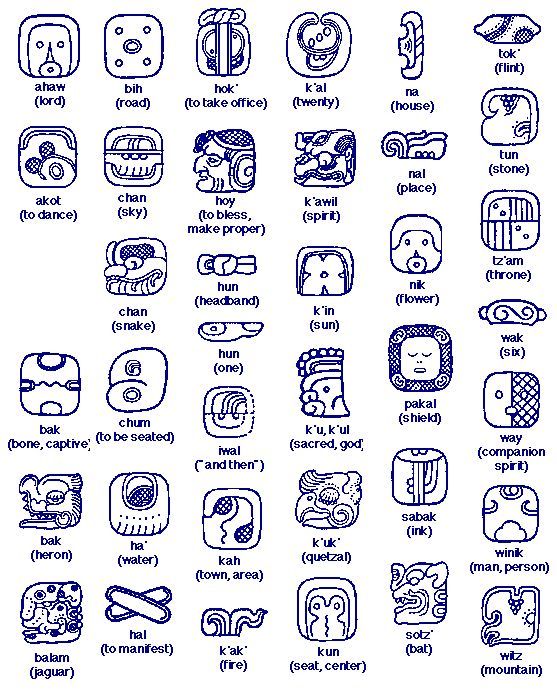
notice the similarity between ba and ma
Notice the different way to write balam
(it seems they had both phonetic and
hieroglyphic ways to write words)
We all know and love mayan writing system, but how about atztek:
and they never had to be decyphered, their writing system was preserved:
The Codex Mendoza is an Aztec codex, believed to have been created around the year 1541.[1] It contains a history of both the Aztec rulers and their conquests as well as a description of the daily life of pre-conquest Aztec society. The codex is written using traditional Aztec pictograms with a translation and explanation of the text provided in Spanish. It is named after Don Antonio de Mendoza (1495-1552), the viceroy of New Spain, who supervised its creation and who was a leading patron of native artists.
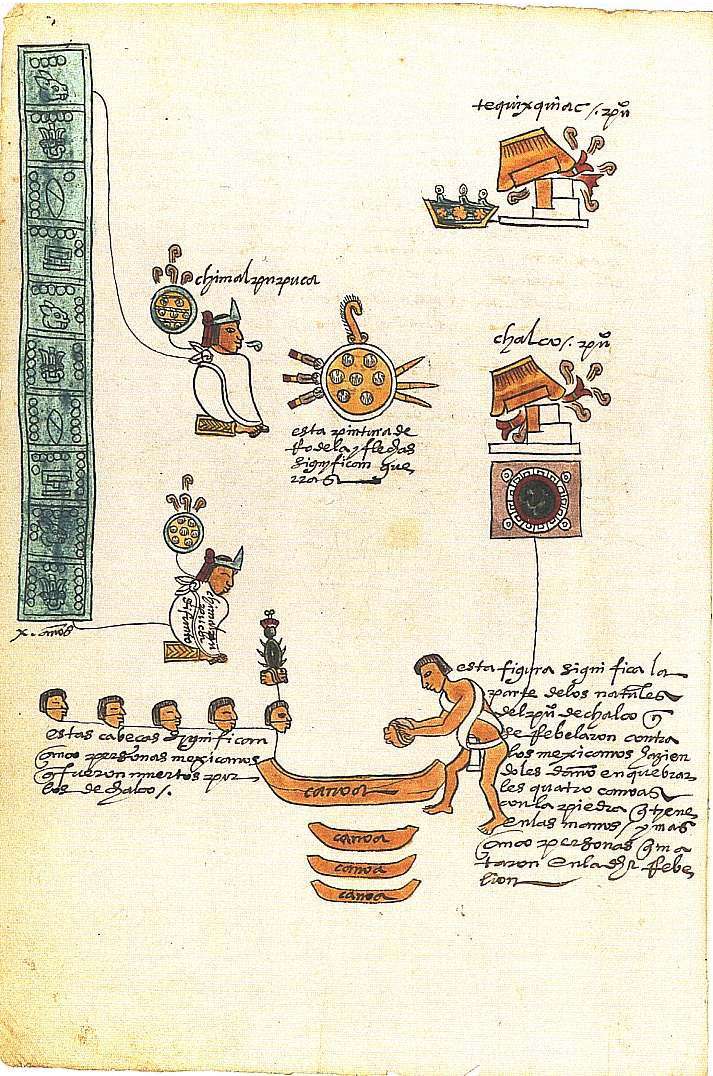
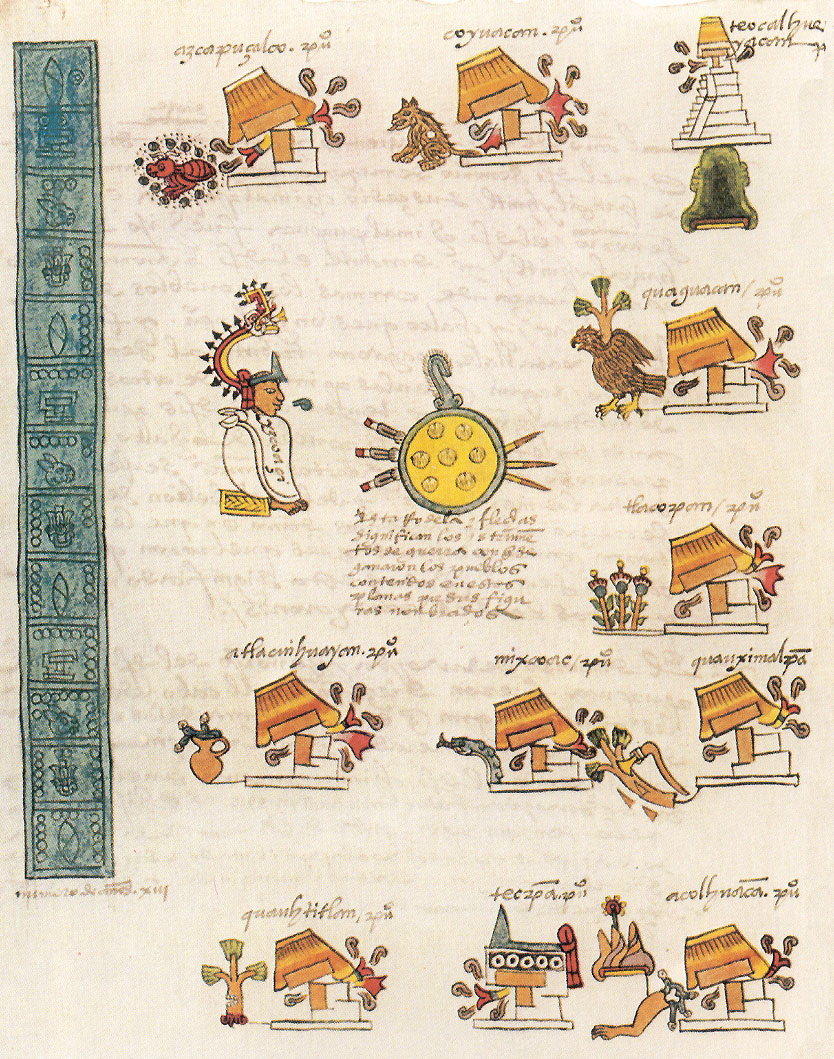
but then again is it translation or just explanation of what we see? The cartouches on the left are not translated for sure. Some contradictory reports this paragraph gives me:
Aztec was pictographic and ideographic proto-writing, augmented by phonetic rebuses. It also contained syllabic signs and logograms. There was no alphabet, but puns also contributed to recording sounds of the Aztec language. While some scholars have understood the system not to be considered a complete writing system, this is disputed by others. The existence of logograms and syllabic signs is being documented and a phonetic aspect of the writing system has emerged,[1] even though many of the syllabic characters have been documented since at least 1888 by Nuttall.[3] There are conventional signs for syllables and logograms which act as word signs or for their rebus content.[3]
ideographic, but some signs are syllables, fuckingreat
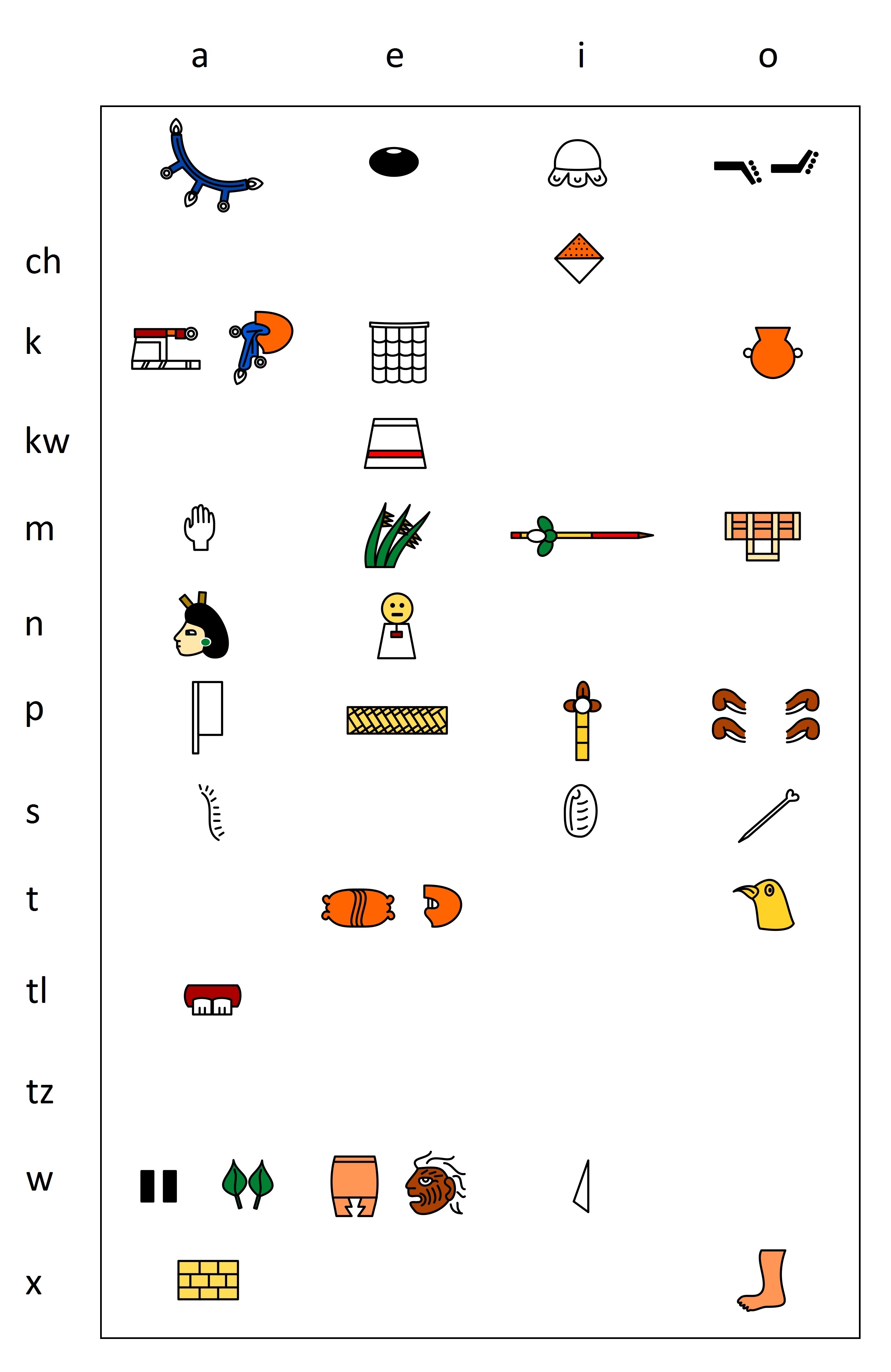
but them did they need decyphering?
The Reverend Damago Soto of Concordia, Vera Cruz, Mexico, was a minister who supposedly discovered the key to interpreting Aztec writings.[1][2]
do they still need some decyphering?
here, I was looking for some bilingual text, here's one:

Conquistador Nuño Beltrán de Guzmán as depicted in Codex Telleriano Remensis "año de onze casas y de 1529 se partio nuño de guzman para jalisco yendo a sujeptar aquella tierra finjen que sale la culebra del cielo diziendo que les venia travajo a los naturales yendo los cristianos alla" (Year of 11 House [Mahtlactli Calli] and of 1529, Nuño de Guzman left for Jalisco to subjugate that land; they feign that a snake came out of the sky saying that hard times were coming for the natives with the Christians going over there.)(Filio 44R)
Now I can see how they interpreted it like this, but then is it protowriting or writing? That diagram is probably protowriting alright, but since they had syllabary, their codices are not less writings than this:

notice, that most of it is ideographic, few signs are genuinely hieroglyphic, but it is only because we can read hieroglyphs, otherwise we wouldn't know any better.
So in the context of this egyptian one look at that aztek page above it and tell me if you don't see any elements of writing. The lines going from one subject to the other may tell the way people are bothered (the kings (the guys on thrones) would probably not be bothered by the european, but europeans bother the niggers, and niggers bother the white bone of the aristocrats. It's funny, that the european is painted more brown than the kings (conquerers naturally spent more times in the sun than the palace dwellers.
The more abstract symbols the same way linked to the subjects are definitely some additional information given in the form of writing very similar to mayan.
Even if those signs are tamgas, those tamgas name the groups of people different by some abstract characteristics later able to be used by other groups to refer to those abstract concepts, which is the birth of the writing system. And thus tamgas being considered proto-writing, could be the basis of the writing? And because kings were deified, does it mean that every god is a historic entity? Gott is Tott is natural conclusion since Г and T are so alike (but I was thinking of ᚴ and ᛐ, the single stroke, k~l? k~lc? k~gn? ng? IMKNL the IMŊL? Ŋow! Now I understand, now I know? but why no and know are homonyms? развязаться ~ развязать узялок (который был на память) узел значит не открывать?
I was thinking of ぬ but め looks like a knot, but so does あ, and how would I notice how much め[me] reminds あ[a] and thus let's look for some [su] reminding those two. And I can only see nu: ぬ
and nu is lingual Aa Me Nu? n~u, which is great, but m adn e.. and I see, m~E (a returns A when switched 90 degrees clockwise, and M and E take 3 such turns, when N only takes 2, which correlates the shapes of N and M, and ni standing for 2 and mi standing for 3 makes me go hm.. were hiragana female and katakana male syllabary? Because such finds tell me that the official history of the kana is some bullshit, it tells nothing, when the alternative returns so many, and I see the abugidaic element in that thing: I see the common element in na nu ne: なぬね and I see that the element is の[no] and only に[ni] doesn't have it, but に is ニ the 二, so it's, as numbers usually are, separated from the letters, and looking for those other element of the abugidaic elements, I immediately see え in ね, and now I recorded all this and I loot at the other two, and I see that な starts the way あ does, but why would あ also have that の to it (and strokes most probably matter in this region) is it because it's more related to な than I think? because a is actually ã, which the word one indicates.
but there's no う in ぬ, instead ぬ is double の, is it related to greek n looking like ν or is it.. あ's lower part? and for whatever reason I was thinking of お, which from the first sight looked like あ with a dot, but not anymore, but then お does look like あ with a dot.
め is me, so the other kana symbols don't follow this idea, so what is it about? Just find two more, and I may have the prototype of the abugida, with most of the kana symbols being added later. As a hypothesis. Let's entertain it one step further:
– k s t n h m y r w
a あア かカ さサ たタ なナ はハ まマ やヤ らラ わワ
i いイ きキ しシ ちチ にニ ひヒ みミ ※ りリ ゐヰ
u うウ くク すス つツ ぬヌ ふフ むム ゆユ るル ※ んン (n) ゛ ゜
e えエ けケ せセ てテ ねネ へヘ めメ ※ れレ ゑヱ
o おオ こコ そソ とト のノ ほホ もモ よヨ ろロ をヲ 、, ・。
らるろ have some similarity, if we ignore り and れ, but then り may stand in thise group too. having the right part of リ that very r the ر. and as that n the の stands at the rightmost corner, here リ is also read right to left having that simple stroke as i, but then I should meet that ɪ in toher other syllables of the i-row, and.. い can be ɪɪ, as russian и is. and I always saw い as cognate of и, so they only lay in line as the same invention differently used in different nations. に could have it,
Let's compare this ammount with vertical lines of other lines: e: け[ke]
is し the coomon dennominator of させそ? leaving す off the board? did they use そ instead? was it aeio, as when we had it a to to。
is つ[цu] of ち[чi]? but not the others? do て and と share the same element, only rotated the other way, and was it telling that this wa it is not that playful, not going ц or ч, but staying t of te and to?
then is た having that very element, whith the cross of the a? was a brought by europeans? other christians? Ⰰ? ᚐ?
but こ is co, and is it the same C as つ? I think some ai may test this hypothesis, too big for me so far.
old south arabic 𐩡[l] is directly runic ᛚ[l] (consider that it would be reversed, if the runic text also went right to left, which sometimes happened:..and though I know I saw runes going right to left and reversing their elements from one side to the other, which would make l and t pretty much the same things (they're similar, but come on)
.jpg)
this is here to show how norsk boustrophedon went, like in.. rongorongo (wrongo?)
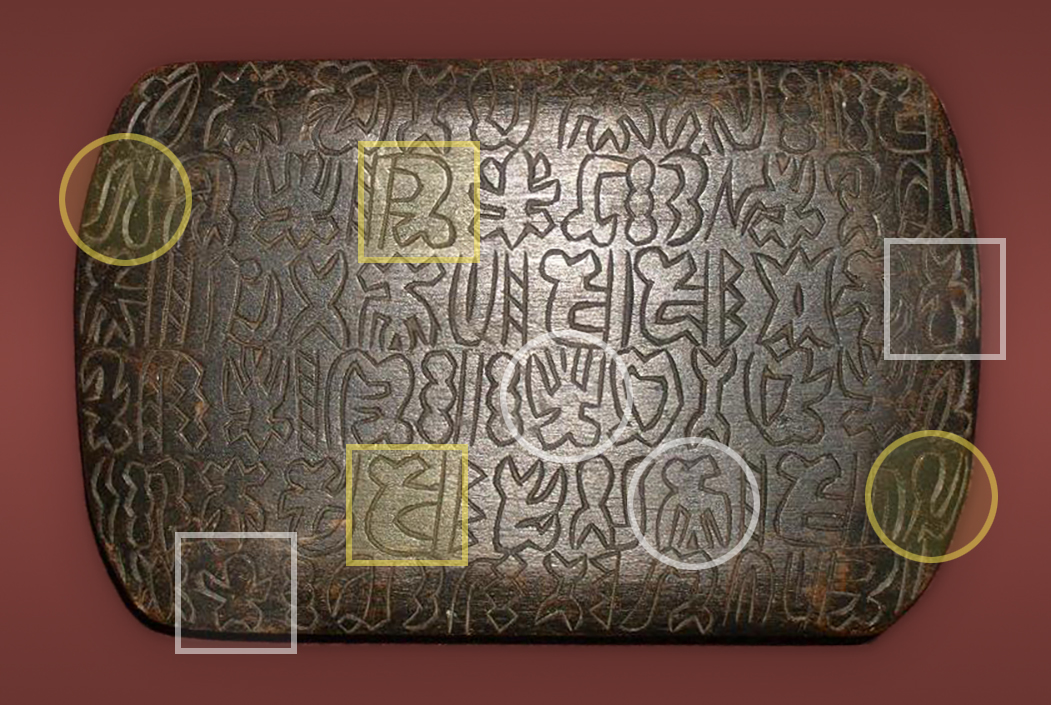
And if norsk people were mariner, they naturally could borrow writing system from a culture similar to the one we call rongorongo, but then comparison could be possible, but rongorongo looks like something I never saw elsewhere.
And that runes going boustrophedon in the greek manner I couldn't find, so maybe it was a forgery or maybe it was really rare, I will keep my eye on this one.
I circled above this similarity in vol.20, and then I noticed that word rongo reminds the word rune, but now I see runica in it, which is even more sorta wow, but it is just a "funy coincidence, until more of the similarity between the two is demonstrated"
The american region is so diverse, yo:
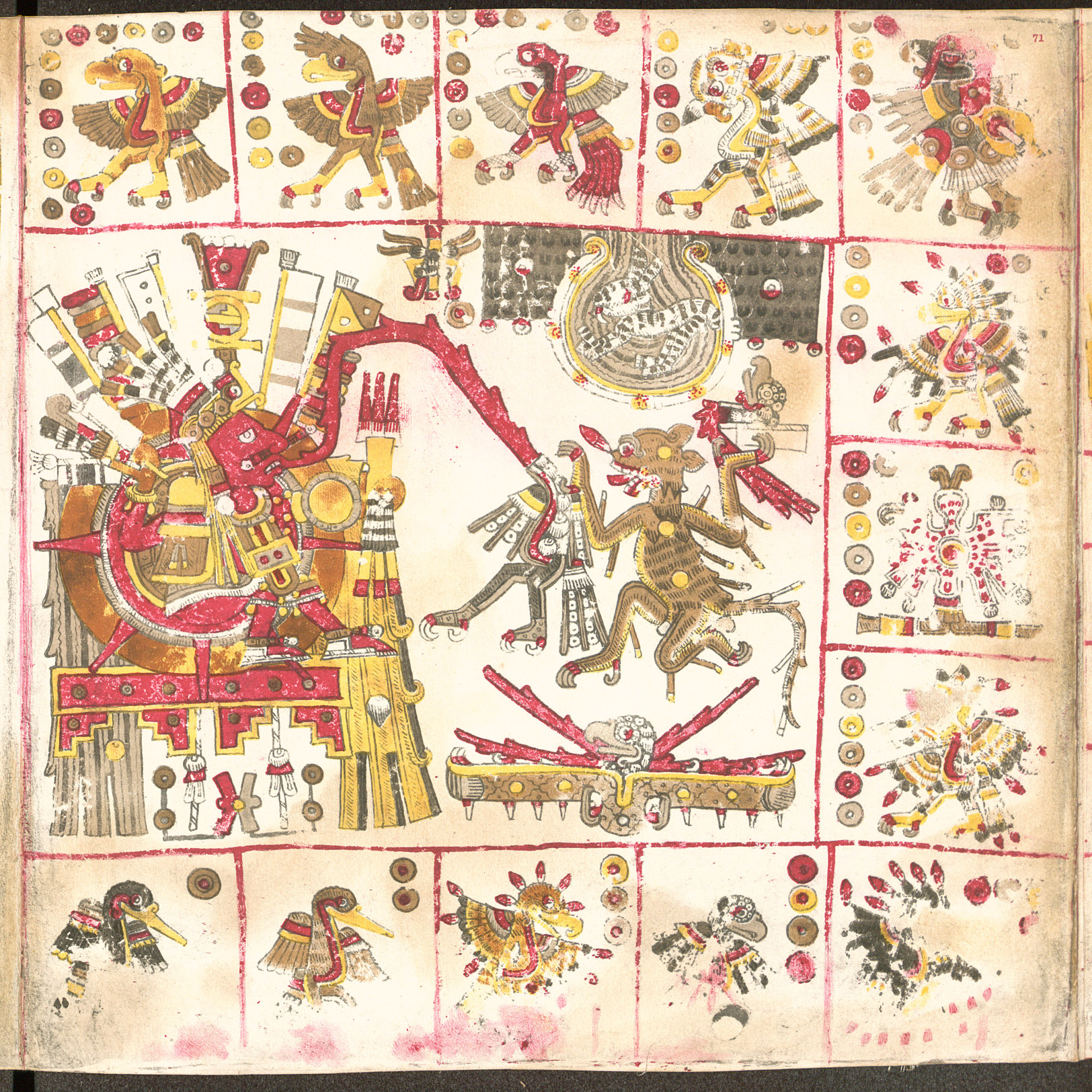
They don't even tell what language it is, but it doesn't look aztek either. Here they seem to use those discs as letters. And is it a cathalogue of birds?
They tell it is Page 71 of the Codex Borgia, depicting the sun god, Tonatiuh. and it tells to me that they only could recognize the central figure, and further faked the understanding, but something they claimed right:
Another way to argue that these circles are not just an ornament is the use of the one in the left bottom corner in the central part, and it being the only one with double external circle, and being in the similar colour (in my opinion, telling that these shades are one color) tells that it isn't arbitrary, especially since by design it wouldn't belong where it is in the central panel. Those polandballs confuse my certainty, but I still believe those are letters (too little combinations for being something else, but too few combinations for being alphabet either. Is it musical notation? It is more likely to be a musical notation than a writing system of some phonetically poor language. And because all donuts in the lower half have red centre, and all donuts on the upper part have white centre, I consider them to be the same donuts. Or, if it is music, does centre depict some other musical instrument? And in the central panel, doesn't that double donut, followed by polandballs and indonesiaballs tell that when that donut appears, white becomes black? red? It is some fantasy science, but science nevertheless.
and here's a page from some other book, where the same donut shapes are used together with some more hieroglyphic signs. So is it a song with words? My guess is it is, but then I can only guess.
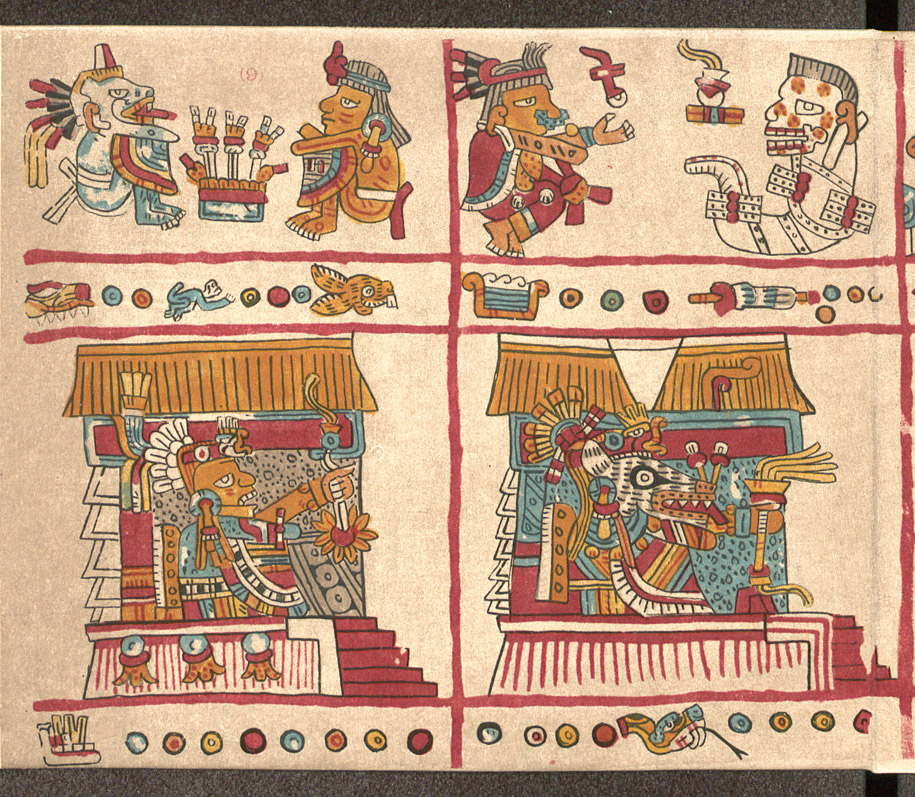
These pages are neither mayan, nor aztek, maybe someday we know whose they are and maybe someday we can read them. They are not decyphered at all. They are read as children who cannot read can read comics
I'm still to make sense about it, I think I will decypher this thing, or at least will contribute to its decyphering.
But I'm ere to return to aztek, because their drawings remind me some other writing system:
Nsibidi is an ancient system of graphic communication indigenous to the Ejagham peoples of southeastern Nigeria and southwestern Cameroon in the Cross River region. It is also used by neighboring Ibibio, Efik and Igbo peoples. Aesthetically compelling and encoded, nsibidi does not correspond to any one spoken language.
but then I realized that I mistook this picture
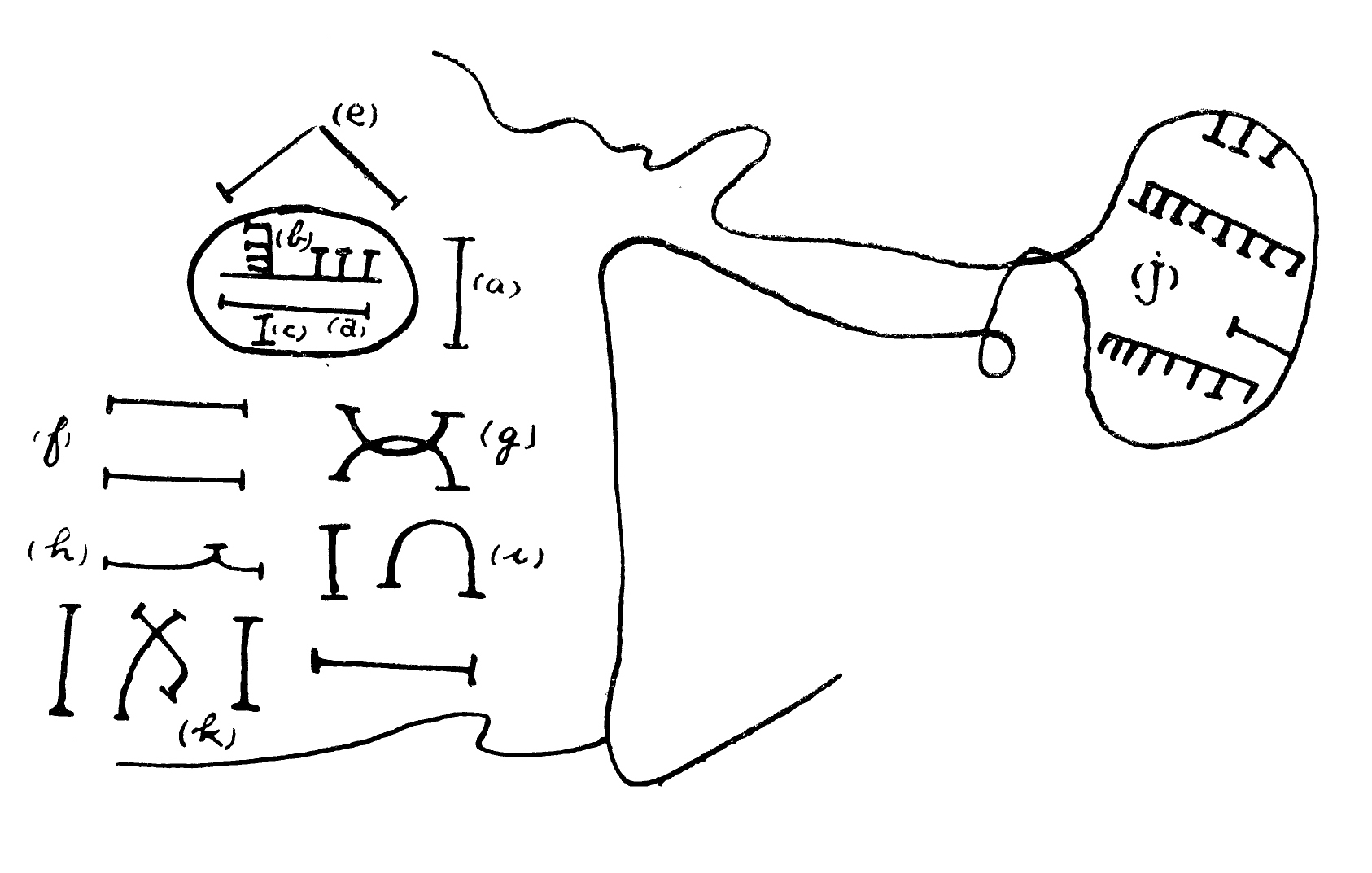
for this indi-geo-an letter:

thinking that those lines were more like they're in that aztek book,
but before I realized it, I went on:
They say that africans cannot sail, but what if the nations who could sail left for America, because Africa became too dangerous for them? What if americans brought nsibidi to africa? is bidi in nsibidi of bd of abcd? of abd? then nsi would stand for vowels. Do they have concept of vowels in the Ejagham language? Notice, how ejagham has the same ending as ogham. Now I can rhyme the two. I have to collect linguistic rhymes to write a poem of this thing. To present this thing in the form of a poem too. You've worked on this for so long, you could make it rhyme. It is true because it rhymes may have some non-ironic meaning too. But then how true? Percieved as truer than it would be perceived otherwise, repetitia matria lectiones or something like this.
From the abstract presentation of Ogham
To pictographic nsibidi of Ejagham.. but pictographic doesn't rhythm with the abstract, I only recently learnt that rhythm matters, Gluhov himself tought me that songs need rhythmic poetry, and then Egor Trubnikov spoke about it somewhere in the comments to his poems. And so I learn and so I become better. Before this I think I did it by intuition, they way I used logic. Logic seems to be ingraned on the genetic level, I don't remember being taught it in the young age, but I was taught to read early, so that could help me develop my brain.

we have 20 unique pictures in the very central ring of the composition. And I remember that mayan numeral system or the calendar has 20 in its basis. And these are neighbouring nations, and nations tend to share numeral systems more than they tend to share writing systems (thus they learn to count before they learn to read, first of all because it is easier, second because it doesn't even require writing)
It looks like all the aztek culture is in this composition. And I see that a man is in the centre, and the figures to its right and left, are probably not skulls, but his hands.
And I notice plenty of circles, similar to the ones present in the pages above, and this thing probably was painted in the past. But could it be this clear if it was? if it was burried in the mud and the paint was organic, why not. So were that unidentified mesoamerican books aztek as well?
20 is also the number of letters in the kiddi alfabet, and thus it is probably their alphabet, and probably also numeral, and probably taken from their constellations, it is quite a rabbithole I have to travel. a whole branch of humanity was digging it for many many years.
16 was enough for what they call younger futhark, and thus it turns clumsy 4×5 of kiddi alfabet to much nicer looking 4×4 with final T
But it is not that simple to arrange ᚠᚢᚦ(ᚬ/ᚭ)ᚱᚴ ᚼ(ᚾ/ᚿ)ᛁ(ᛅ/ᛆ)ᛋ (ᛏ/ᛐ)(ᛒ/ᛓ)ᛘᛚᛦ into..
(ᛅ/ᛆ)(ᛒ/ᛓ)ᚴᚦ
ᚼᚠ
ᛁᛘ(ᚾ/ᚿ)ᛚ
(ᚬ/ᚭ)ᚢᚱᛦᛋ (ᛏ/ᛐ)
(ᛅ/ᛆ) (ᛒ/ᛓ) ᚴ ᚦ (notice that ᛓ doubles ᚴ, and ᛒ doubles ᚦ, returning the idea of g~д (and ד cursive ~ 3)
ᚼ ᚢ ᛦ ᛋ
ᛁ ᛘ (ᚾ/ᚿ) ᛚ
(ᚬ/ᚭ) ᚠ ᚱ (ᛏ/ᛐ)
it is purely hypothetic, but only now can I see how ᛘ and ᛦ share the central position reflecting each-other, and I placed ᛦ there only because it could be ᛣ and thus not too far from being G, either way, k-coloumn
Ukrainian доба (сутки, 24 hours) is as if consisting of day and night, where night is ba, because labial is female and yin, and thus dark, and because kombanwa is good night in japanese.
Коромысло может быть основой лука.. и ярма (а также может быть оружием типа шеста, можно в русском-народном фэнтези обыграть этот момент)
bu as night:
поздно quiet rano samoe time? Time ~ Tott? время и смерть делят больше половины букв, и эти буквы мера ~ рема
isn't rema strictly linguistic term? Происходит от др.-греч. ῥῆμα «слова, речь; глагол».
Here's something meaningful about the rotations, time, cardinal directions:
I wonder if гаш and ганж cognates
I looked up mayan codex to see if they have those donut shapes, and I could only find this one:
.jpg)
which makes me wonder if it is not symbolizing their neighbours azteks
(but then a day later I found on that very page donuts not only on the lower snake frame, but also twice(!) on the upper guys and some hieroglyohs had donuts, so probably this is a common shape, standing for who knows what.
I double checked for aztek codex, and though I found a donut shape in the fourth image I came across,

most of codices don't contain this shape, which makes me wonder if the book I identified as aztek is aztek, since it is not recognized as such by the specialist, so what am I, amateur, is doing here?
but then I see it a lot, but in the next one as decorations:
but then what on earth am I doing? What difference do aztek writings make? good morning, and it's time to smoke some weed to clear my mind to something more important than this random babble
but the last piece to show that unlike mayan, aztek writings use those donuts oft:en (is опт oft? пост.?)

I'm high and in this image I can see the recepy starting in the top right corner: it may depict maté-like drink and the tree it is made of, and the red bottom could depict its being hot. And then feet show the direction of the comicstrip, so in the next one the blue with bubbles may be a hieroglyph, such as "пил, пил, а этот даже два глотка сделал"
на следующем слайде чел с мечом (они не знали металла, вставляли острые камушки в деревянный меч, но они знали метал The Aztec were exceptionally skilled workers in metal, especially copper and gold, although silver was also occasionally worked. It is generally believed that the technology of metalworking, or metallurgy, did not originate in Mexico, but was probably introduced from Central or South America. но камень всё равно острее (я не выдумываю, реально такие мечи, macuahuitl, handwood)) и щитом чтоли? Сначала подумал что это тоже иероглиф вроде открытого входа в типи, типа "открой" или "открылось" и я лишь гадаю, не зная иероглифов, но нога рядом с ним показывает что это отдельный слайд, а не одновремено с предыдущим, затем.. чел с мечом стоит возле одной из женщин, сидящих в предыдущем слайде, что может быть указано тремя полосками, только раскрашивал чтоли тот кто не понимал? вроде меняется окрас полосок? и поскольку простолюдины у индейцев читать не умели (секретное знание, оттого и прогресс у них от европейского отстал?) профессиональные раскрасчики раскрашивая написанный текст (раскрасчики рассказчики) кодировали его дополнительными деталями, не имеющими значения: посмотри на три картинки выше, там нераскрашенный текст, и бублики без цвета определённо имеют определённое значение. Если это так, это должно отразиться в ацтекском языке. отцекском
so the child is born, afte they drank something when the woman was pregnant, and does it depict how many wood it is needed to burn the child as a human sacrifice? Were the kings with packs of wood standing in line to keep the fire on to burn the child all through as if to send him to heaven or why is my fantasy such wild and vicious? What else could it be? What does the child have to do with anything? I am definitely influenced by the catholic smear campaign, so let's leave it to aztek peoppll to decypher. I should write to them asking about the syllables making new words, but this is later explained, I returned here to finish the thought as I sometimes do.
on the next one the lines between boxes show that it is a text, what those pictures mean? They're the 20 days of their calendar: look how 1 to 13 sequence in those balls grow, even though they made a mistake in the bottom left box. And it became obvious that those donuts are numerals (they still could be musical notes, but let's look at them as at numerals from now on) and the images in those boxes are 4 in number, is it their week? so 13 day-calendar, 4 day-calendar, 20 day-calendar? Or is it the story showing the days spent buy the heroes to do whatever the images on the right show? but then 20 is a special number to them 2 13
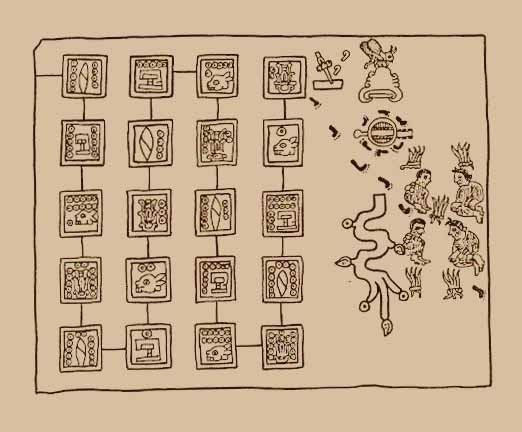
and the following image tells me that the panels in the centre could be simple rebuses with beasts and objects standing for their first syllables, giving thus the other text: thus people would not need to learn the hieroglyphics, they'd know the names from speech and could read it without studying (only such phonetic hieroglyphics would be not understood by the neighbours, unlike chinese is)
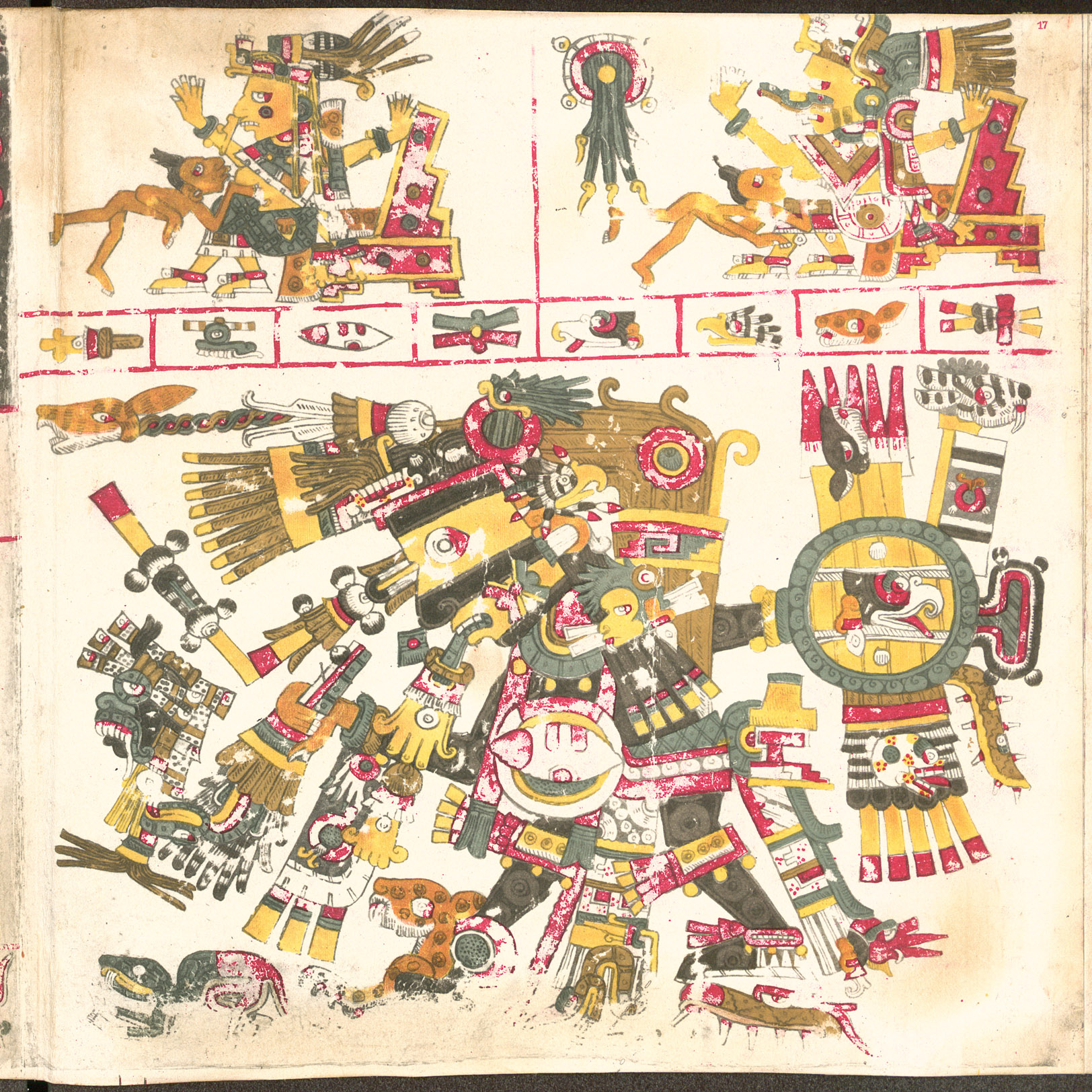
and then all the insane ornament of the main panels are words encoded such way.
Do the upper panels show a concubine sucking on tits of the queen and on dick of the king, and the lower panel is the author giving a speech encoded into the ornament?
oh and I'm probably correct, but they know that:
The Aztec or Nahuatl script is a pre-Columbian writing system that combines ideographic writing with Nahuatl specific phonetic logograms and syllabic signs[1] which was used in central Mexico by the Nahua people.
so who's faggot now?
The Aztec writing system derives from writing systems used in Central Mexico, such as Zapotec script. Mixtec writing is also thought to descend from Zapotec. The first Oaxacan inscriptions are thought to encode Zapotec, partially because of numerical suffixes characteristic of the Zapotec languages.[2]
and I didn't have a clue:
The Zapotec script is the writing system of the Zapotec culture and represents one of the earliest writing systems in Mesoamerica.[1] Rising in the late Pre-Classic era after the decline of the Olmec civilization, the Zapotecs of present-day Oaxaca built an empire around Monte Albán. One characteristic of Monte Albán is the large number of carved stone monuments one encounters throughout the plaza. There and at other sites, archaeologists have found extended text in a glyphic script.
Some signs can be recognized as calendar information but the script as such remains undeciphered (if not undecipherable).[2] Read in columns from top to bottom, its execution is somewhat cruder than that of the later Maya script and this has led epigraphers to believe that the script was also less phonetic than the largely syllabic Maya.
don't won't.. is pst term 'asn't? is hasn't~wasn't the way don't~won't? doesn't.
looking up aztek and having come some difficulties, I found that it's aztec and redundance of velars made sence of differenciating the same words by spelling, but hardly they had google when they created alphabets, they probably had their own reasons for being able to use this redundance.
A B G D (abgd/эвжз)
I M N L
O P K T (опкт/уфхс)
ABD а батя, abe-dad
IMΛ имел
OПТ опыт
AMT is truth, now let's check other lines
א ב ד
י מ ל
ע פ ת
י מ ל
ע פ ת
אמת ~ truth
איע (a name of god! like literally! but then all vowels, Ἰαὼ)
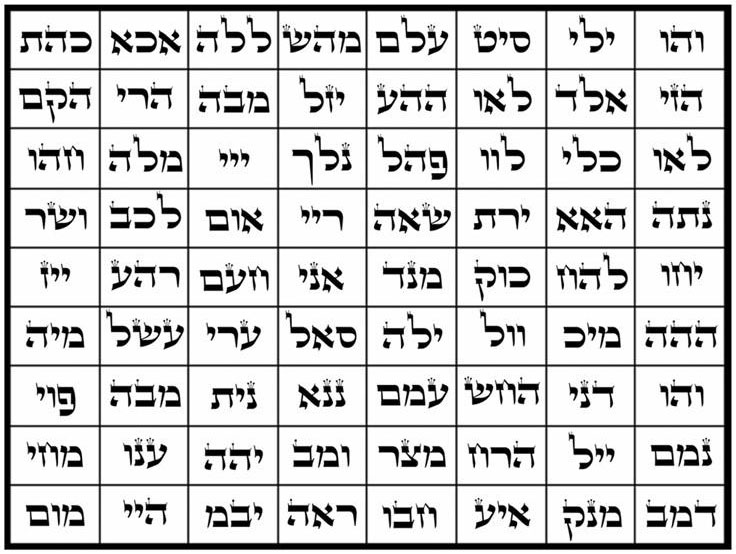
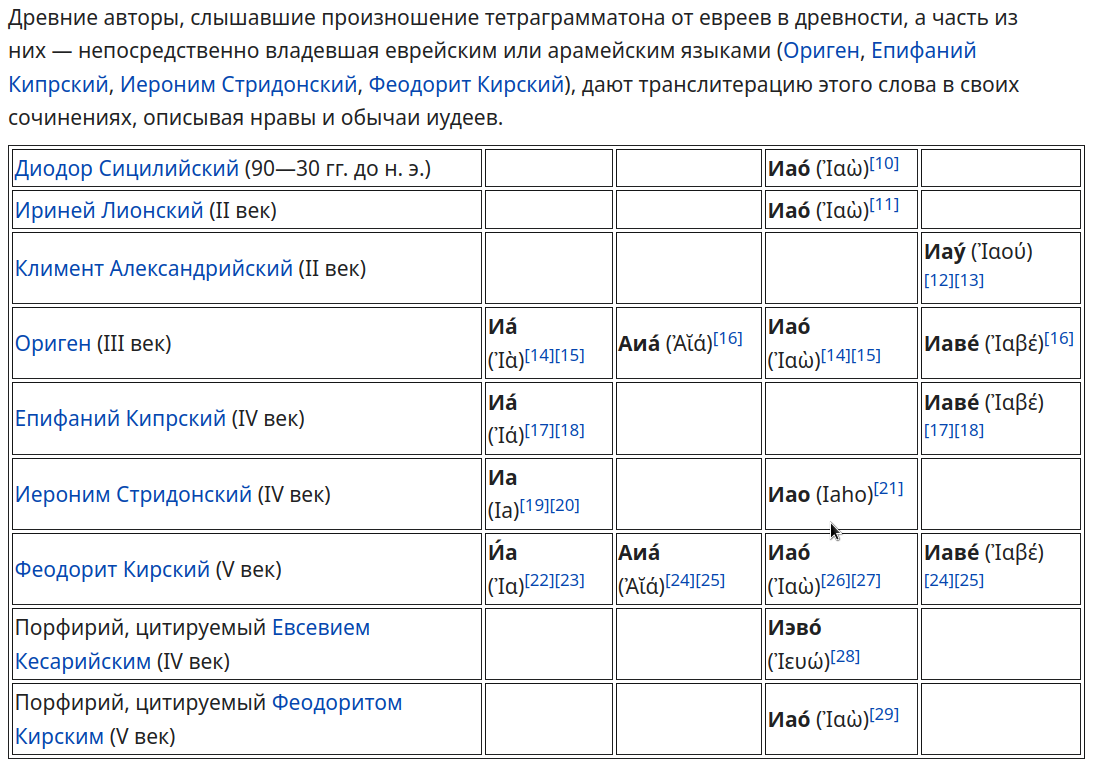
אָבֵד ~ lost, [авед (словно неведомый, unknown, which god is, or is it how the word came to be?)]
ימל и похоже что нет такого слова! (except acronym of יגדל מלכותך לעד (May your kingdom be increased forever))
במפ и похоже что нет такого слова (кроме как бмп и б(in)мп(map) and בגד מגן פחמי (carbon protective garment))
דלת ~ door, the name of letter ד
עפת you flew:
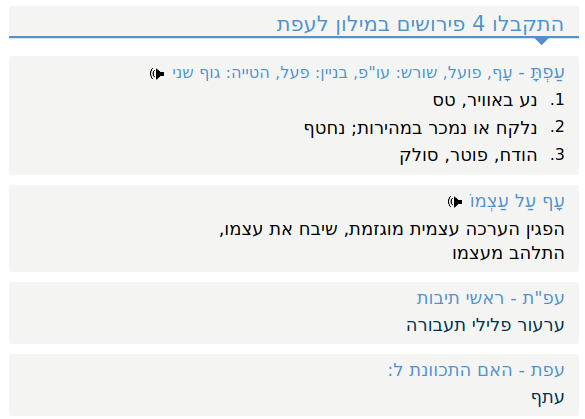
1. נע באוויר, טס (Move in the air, fly)איע (a name of god! like literally! but then all vowels, Ἰαὼ)


אָבֵד ~ lost, [авед (словно неведомый, unknown, which god is, or is it how the word came to be?)]
ימל и похоже что нет такого слова! (except acronym of יגדל מלכותך לעד (May your kingdom be increased forever))
במפ и похоже что нет такого слова (кроме как бмп и б(in)мп(map) and בגד מגן פחמי (carbon protective garment))
דלת ~ door, the name of letter ד
עפת you flew:

2. נלקח או נמכר במהירות; נחטף (taken or sold quickly; kidnapped)
3. הודח, פוטר, סולק (Dismissed, fired, eliminated)
Did I just build a crossword? The cross of christians is not in that crossword. Such a jewish beauty, main words come from א as rays from sun, and dalet is vertical and you flew in sleep, I suppose, if it is the lowest line. And one or two other words I didn't notice. Is there a chance to other diagonal to mean something either way? דמע or עמד?
דֶמַע (noun) tear, wine, oil, juice
עמד ~ stood
To my surprise both those variants are hebrew words, but then do they matter? not very much, just random words.
But back to the names of god thing. Let's combine the two tables and find only vowel hebrew names:
והו
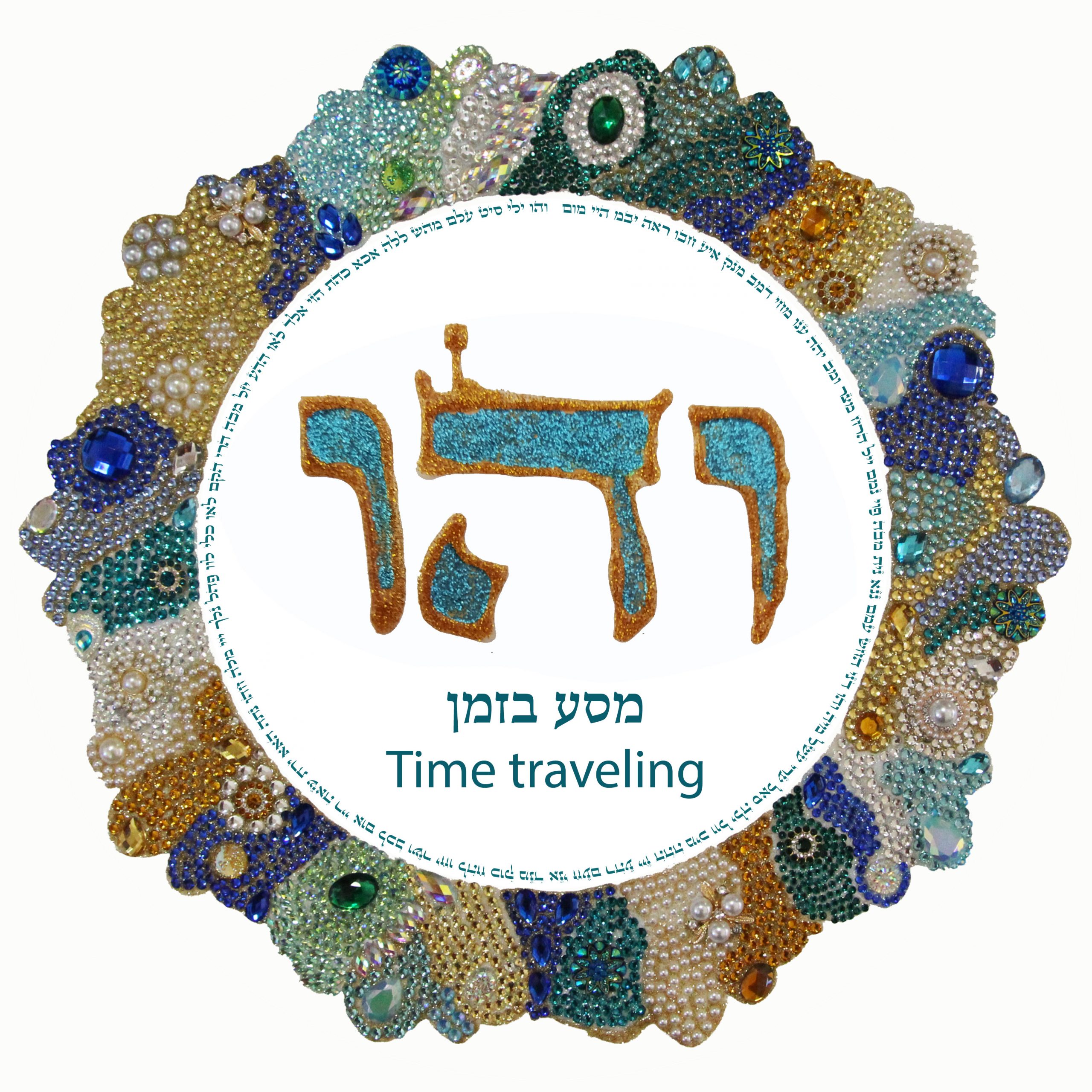
ההע
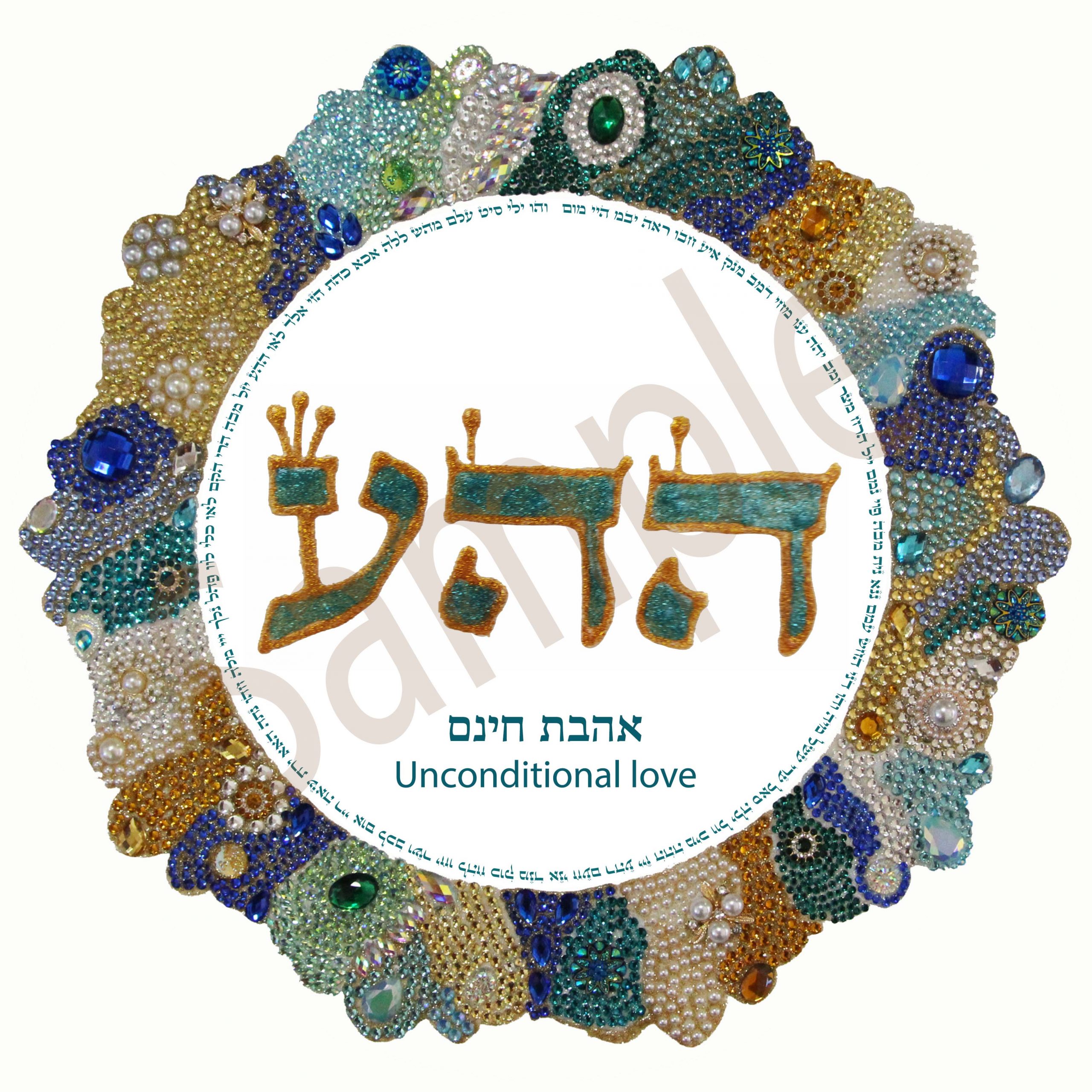
ייי
האא
הההfor whatever reason they
repeat והו
beginning with it (from
the right) the 1st and 7th lines
יהה
the one which I found in
that 33 alphabet, איע
and the one I found this thing with
היי (which I didn't even find on cabbalists
site, which you can find by looking up these trigrammatons)and the one I found this thing with
is it because it is european Hij?
And indeed all the vowel names of gods consist of three letters. But then only 8 of the 72 are tetragrammatons (and no יהוה amongst them! like what? why?) which is 1/9, which is 11.(1)%
ABC
IMN
OPT
aeiou
b t
c s
d R (dexter, right)
e q
f p
g o (globus and planet?)
h n
i m (I am)
j l
k
or
aeiou
b t
c s
d R
f q
g p
h n
j m
k l
but thus the symmetry is worse, but I would surely find similarity between Ф and q, as in ᚹ and ᛩ
Г and П? Г and Ⱂ and I immediately see P in that Ⱂ, as if Ⱂ is common ground between P and П
(I was looking for П with one short leg, but found that one and also ף and even 冂 (перевёрнутая коробка, пустынные земли (п of пусто (o is open? opening? 口 [kuchiJA, kouCH (as if c the כ, which is also mouth)])))) are those bracketed texts makura kotoba (но makuraJA = подушка, а не свёрток (包 tsutsumi (tsutsumu 包む заворачивать (包 is bao[páo] in chinese, сумка (заворачивать is 裹 [kuó])))))
包ま [tsutsuma] обёртка [also 包装 (hōsō)] (обёрточная бумага [also 包装紙 (hōsōshi)])
But j doesn't belong its place, for it is i, and vowels are separated in this presentation, but mostly I want to show how similar are K and Ⰿ.. and unicode is the mess, or it only contains one form of glagolyca, I need to work on offering them another set of glagolic unicode block, as orkhon and yenisei ones are different, eastern glagolica, the one russians know much better should be present in unicode as well:

and O loke В: Ⱁ
followed by Ⱂ like Г
and Ⱃ like Б with that sudden something much more than serif
Ⱄ similar to that Ⰲ
Ⱅ getting that ̆ and looking thus like Ⰶ and thus I for the first time can see how Ⰶ is a form of Ⱅ
And doubleness of Ⱆ tells of the other phase, with its own (Ⱄ and Ⰲ)like Ⱇ, Ⰳlike Ⱈ, and once again I can see their similarity, which promises me abugida of that, and a friend of mine noticed that ethiopean reminds glagolitic)
and Ⱉ is another Ⱁ, separating those bubbles being Ⱁ-mega,
and followed by "hypothetic", as wiki tells, Ⱊ the П, and thus the cycle goes on with its own c the ч etc
But wishing to place Ⰶ above Ⱅ, I'm lost in the depth of this thing
ⰀⰁⰂⰃⰄⰅⰆ
ⰇⰈⰉⰊⰋⰌⰍⰎⰏⰐ
ⰑⰒⰓⰔⰕ
ⰖⰗⰘ
ⰙⰚⰛⰜⰝⰞⰟⰠⰡⰢⰣⰤⰥⰦⰧⰨⰩⰪⰫⰬⰭⰮ
Ⰶ being a form of Ⱅ reminds me of ž being a form of z, and thus z and t meet not only because they have dash across them, but because z often doesn't, is t basically l? it approves of kiddi alfavit, and it reminds me of the similarity between ᛚ and ᛐ, as if dash in latin simply tells that it's the same but different, as ᛚ and ᛐ are.
Have been talking to a bangladeshi muslim yesterday, and he spoke in very correct and elloquent english, but his reasonings reminded me a monkey wearing glasses and pretending to be smart: he used terms from european culture and he didn't understand them the way europeans understand them, or rather he understood them in his own unique and different way, he used phrases as moral logic, as if it was a branch of logic (he then googled if there's such thing, and he used moral reasoning, which returned to me when I did, and the other one was contradicting himself and eluding when you showed it to him, by trickery and arrogance, not reason. The other thing was.. I seem to erased memory, not thought. Well забываются вещи бывает, но не так же быстро, но это была не память, а память о мысле, я вспомню о нём снова и допишу.
писать стыдно русскому: писа́ть (to write) ~ (to piss) пи́сать
писа́ть ~ пища́ть (пером)
aбвгд
еёжз
ийклм
нопрст
уфхцчшщ
ъыьэюя
aбгд
евжз
имнл
опкт
уфхс
aбвгд
еожз ё как ö immedeiately reminds ו
ииклмн
ноплст nasal o reminds ã and comparing oпΛст я вижу абVсд (is 宀 what matters? is it 冂? 冖?)
уфхстсс щ как когната с в пищать~писа́ть (писа́л ~ припусти́л)
' i i е y а י и i е u a
иеоуа вижу в последней строке я. Если ммануил но то и еиИегова
By accepting the abugidaic 4×5 system as the basis, I rebuilt the modern alphabert of the letters available from the previous set. And it gave me understanding of what was the use of old letters in the newer phonetics.
(припустил и обоссался и побежал, видимо припустил в значении побежал от "зассал" (испугался))
So, what changed? Whoever made this (rather common too) russian alphabet, they did it for different reasons, and some reasons we know in recorded history, thus I must build old imperial russian alphabet not this modern commie shit. Shit or no shit, it gave me the 4×5 20, so it is the best they did, some reformer was before them, jumped onto their train, and thus maybe legitimized theri rule as well. Revolutionary change is multi-faceted. Revolution happening by scientific inventions and discoveries is much better than conquest disguised as revolution, when the population is nothing to the perpetrators.
But I want to entertain these two points in time, abugida and modern, to see what it was, to only then compare it to old-russian alphabet, which I know only a little, and will do my best to keep them out of my mind, to compare better, to see if I am speaking business.
aбгд
евжз
имнл
опкт
уфхс
aбвгд
еожз
ииклмн
ноплст
уфхстсс
ו ו ו е u a (because ъыь remind 666 so much) ..but what if ю is io?
ו ו ו e io a (both? эюя (eua) is the name of god? and I see ЕВА in eua the eva, ею~её, ея)
я as аз? as Ω the ω? and cursive я may look like ω
and the shape of Ω reminds me of..
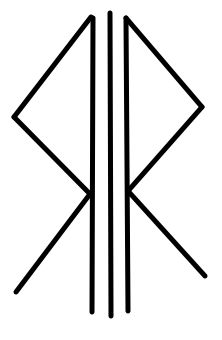
Roma Renovata Resurgit (thus the middle simbol is ᚱ in the orthogonal plane)
Which is not shown to you by this image I had to draw having not saved it when I was shown it few days ago:
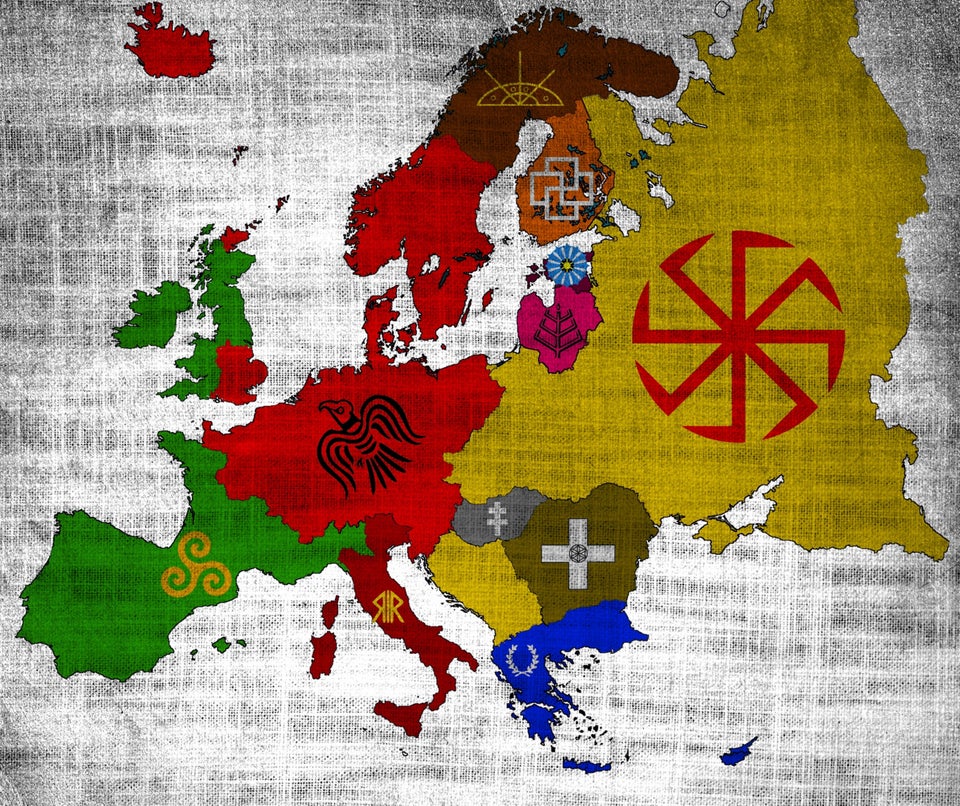
and before I found the page in my browser history I thought it was Romanum Imperium Romanum
and I asked him of the saami simbol, and was told that it's something about the moon, Beaivi and Mano, Sun and Moon, and was given this:
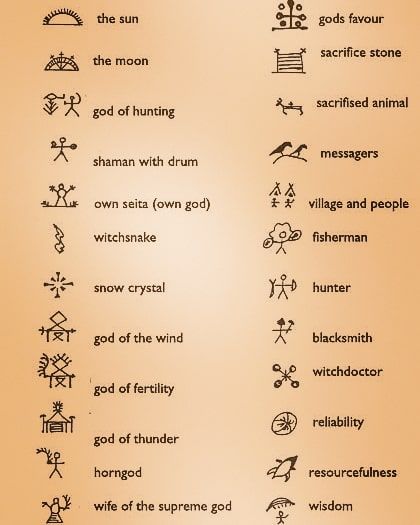
beauty is the sun? man is a moon, shining in its light.
Saami is probably finnish, and thus considered to be not related, but then the branches of language families is a pseudoscientific philology and those languages have some basic level of cognates, and I was thinking that they must be the innermost, the most ancient plane of language, but then I can see that how will I distinguish the recent and relatively recent borrowings from the ancient words?
But let us leave this for now, let's look further into that ЯIR:
Il simbolo del tradizionalismo romano-italico odierno, che originò come logo dell'associazione italiana "Movimento Tradizionale Romano". Le tre R, di cui una vista di fronte, sono le iniziali di Roma Renovata Resurgit.
The symbol of today's Roman-Italic traditionalism, which originated as the logo of the Italian association "Movimento Tradizionale Romano". The three Rs, one of which seen from the front, are the initials of Roma Renovata Resurgit.
La via romana agli dèi, altrimenti detta tradizione romano-italica, tradizionalismo romano-italico o gentilità romano-italica, è la continuazione e riproposizione moderna e contemporanea della religione romana e italica attraverso pratiche tratte o adattate dalla documentazione storica dell'antica Roma. A volte è qualificata, per molti suoi seguaci impropriamente, come neopaganesimo romano-italico.
È praticata in Italia in forma sia individuale che comunitaria, seppur non pubblica, da alcune centinaia di persone, raccolte in diverse associazioni. Gruppi minori esistono anche in altri paesi europei e in Nord America.
The Roman way to the gods, otherwise called Roman-Italic tradition, Roman-Italic traditionalism or Roman-Italic kindness, is the modern and contemporary continuation and re-proposal of Roman and Italic religion through practices taken or adapted from the historical documentation of ancient Rome. It is sometimes described, incorrectly for many of its followers, as Roman-Italic neo-paganism.
It is practiced in Italy in both an individual and community form, albeit not publicly, by several hundred people, gathered in various associations. Minor groups also exist in other European countries and in North America.
and that gentilità is kindness in the was of one of the kind, one of the gens, and gensness is also translated as вежливость, but no such word really. Gentiles are of gens, роды, чтящие род, а не твоего бога, не потому ли что это культ дидов?

They say, language influences thinking, and russians do have some fucked-up words, who knows, maybe they're part of the problem which makes their world fucked up.
They say, неделя used to stand for sunday, but then they counted weeks by sundays, so the word shifted its meaning into meaning the whole week, and now their language tells them to do nothing, very demotivating, and it shows. But is it a true etymology? What iſ if неделя has some other meaning, even if it is не дело, it was derived from showing the period of time, and telling that what he tells is not the business they're doing during that time. A week is a good period to make a business transaction, to have a party when the money are earned. It's still demotivating in its sound, but the etymology is a little more positive, and we can verify or falsify this hypothesis by looking at the neighbouring languages.
Is week ~ werk? or weak? weak ~ неделаю, but dutch is more motivating week~werk, but then week is both week and weak in dutch. Easy? easy. take it easy so far it went nowhere.
The other weird word is another н-word: наверное (probably) which sounds as it means "for sure", but for sure is наверняка, and it confuses russians who stard unravelling their lexics and give up at such подводные камни. But fthat word makes better sense if you see вера inside of it, so it's на верное, на веру (верное is also sure, so the confusion is natural and ubiquitous [юби́кўитэс]) and then english "I believe" has this ambiguous [амби́гьюэс] meaning of both maybe and certainly. (it was born today in the bathtub and thus is being present in cardboard in ge'ez folder)
Comparing russian EЁЖЗ to greek ΕϜΖΗΘ, I cannot help but wonder: is ZH Ж? is Θ З?
But seriously, is Θ З? it would explain why из is of and for is за. But in greek neither of nor for has θ.
ЭЮЯ is E IO(u) A
and it is notabkle that ъыь stand on the left side and эюя at the right foundation of the alphabet
ъыь эюя (ann july august? (then ъыь are декабръ, январы, февраль (but then plenty of other months end with ь: апрель, июнь июль опять же, сентябрь октябрь ноябрь, and that's more than half, wiht may as a condidate.. But let's look at british variant january february may july, september october dovember december: y and r chew off the equal thirds, leaving only march, april, june august behind, and dividing them between the two would be marty&juny and aprir&augusr (but you understand it is just a guess, which maybe return or maybe not, it returns when it's met elsewhere, and then who knows if that was built by a will of a person seeing something and then enforcing it (but isn't it how the story goes, how the culture grows)))))
эюя is nowhere neare june july august, эля юля яся was where that july grow from, so it went from something random, and it went randomly like a dividing particle, randomly.
эюя brought еигова instead of иегова (as atlphabet's eiouaeiouaeiou brought me a year ago during writing the booky (boo key (scary key (as something scary would be wopen with))))
(the paragraph above is how it would have to be done, maybe the final brackets should be all greyer, but it's too time consuming and rather useless, to be honest, to be made by a program and can be done later any time.
aбв гд
её жз
ийк лмн
опр ст
уфх цчшщ
ъыь эюя
абе господи deus
ежи ёси жи ези.. ежи изи (е ж и з (eghθ (εζηθ)))
атец брат враг господин друг её (жена, земля (земья, знамя, семья))
не враги ли внедрили в после б? не они ли придумали что надо врагов держать ближе чем друзей? I keep my enemy even closer than my enemy can shave, həhəhə
непотимз неэффектимвность
непотизм неэффективне impotent1
nepotismo impotento
but nepot is better than despot, because it's half the trouble when he cannot do anything, it's much worse when he can deliver death, that's a real and horrible trouble.
A E I O U
B F M P V
C H K Q X
D G L R S
air ~ agni
вода ~ vvasser (νερό[nero] ύδωρ[izor] ποτίζω[потизо́р]) vodaCZ wodaPO WasserGE waterDU
Wasser [vása ~ washer]
The verb wash is prior to noun wasser? мой и вода те же самые глагол и существительные? существительное очевидно да
видно ~ видимо (скорее всего (т.е. почти наверняка, но малая вероятность что может быть нарисовано))
Let's try it with just three vowels:
A I U audi
BMW◔◕🬈
CNX chinx
DLZ dollaz
𑨀𑨀𑨁𑨂𑨃𑨄𑨅𑨆𑨇𑨈𑨉𑨊𑨋𑨌𑨍𑨎𑨏𑨐𑨑𑨒𑨓𑨔𑨕𑨖𑨗𑨘𑨙𑨚𑨛𑨜𑨝𑨞𑨟𑨠𑨡𑨢𑨣𑨤𑨥𑨦𑨧𑨨𑨩𑨪𑨫𑨬𑨭𑨮𑨯𑨰𑨱𑨲𑨳𑨴𑨵𑨶𑨷𑨸𑨹𑨺𑨻𑨼𑨽𑨾𑨿𑩀𑩁𑩂𑩃𑩄𑩅𑩆𑩇
Zanabazar's square script is a horizontal Mongolian square script (Mongolian: Хэвтээ Дөрвөлжин бичиг, Khevtee Dörvöljin bichig or Mongolian: Хэвтээ Дөрвөлжин Үсэг, Khevtee Dörvöljin Üseg),[1] an abugida developed by the monk and scholar Zanabazar to write Mongolian. It can also be used to write Tibetan and Sanskrit.[2][3]
It was re-discovered in 1801 and the script's applications during the period of its use are not known. It was also largely based on the Tibetan alphabet, read left to right, and employed vowel diacritics above and below the consonant letters.[1]
and this is the mess I saw in unicode, is it just me or you can see it too?

it is duployan shorthand (try and select the top of that pattern if you have it shown as in the picture (because seamonkey draws it in a regular line))
and some of you can be puzzled further in the text, so here I am to show the shapes I can show with it, followed by how зыбки те формы, бо распадаются будучи помещёнными в другое окружение:
 how it looked
for me, and for some others..
how it looked
for me, and for some others.. 
and other variants on my own computer:
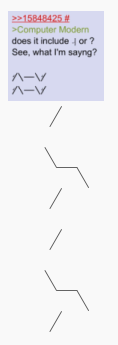

𛰀𛰁𛰂𛰃𛰄𛰅𛰆𛰇𛰈𛰉𛰊𛰋𛰌𛰍𛰎𛰏𛰐𛰑𛰒𛰓𛰔𛰕𛰖𛰗𛰘𛰙𛰚𛰛𛰜𛰝𛰞𛰟𛰠𛰡𛰢𛰣𛰤𛰥𛰦𛰧𛰨𛰩𛰪𛰫𛰬𛰭𛰮𛰯𛰰𛰱𛰲𛰳𛰴𛰵𛰶𛰷𛰸𛰹𛰺𛰻𛰼𛰽𛰾𛰿𛱀𛱁𛱂𛱃𛱄𛱅𛱆𛱇𛱈𛱉𛱊𛱋𛱌𛱍𛱎𛱏𛱐𛱑𛱒𛱓𛱔𛱕𛱖𛱗𛱘𛱙𛱚𛱛𛱜𛱝𛱞𛱟𛱠𛱡𛱢𛱣𛱤𛱥𛱦𛱧𛱨𛱩𛱪



𛰀𛰁𛰂𛰃𛰄𛰅𛰆𛰇𛰈𛰉𛰊𛰋𛰌𛰍𛰎𛰏𛰐𛰑𛰒𛰓𛰔𛰕𛰖𛰗𛰘𛰙𛰚𛰛𛰜𛰝𛰞𛰟𛰠𛰡𛰢𛰣𛰤𛰥𛰦𛰧𛰨𛰩𛰪𛰫𛰬𛰭𛰮𛰯𛰰𛰱𛰲𛰳𛰴𛰵𛰶𛰷𛰸𛰹𛰺𛰻𛰼𛰽𛰾𛰿𛱀𛱁𛱂𛱃𛱄𛱅𛱆𛱇𛱈𛱉𛱊𛱋𛱌𛱍𛱎𛱏𛱐𛱑𛱒𛱓𛱔𛱕𛱖𛱗𛱘𛱙𛱚𛱛𛱜𛱝𛱞𛱟𛱠𛱡𛱢𛱣𛱤𛱥𛱦𛱧𛱨𛱩𛱪 𛰀𛰁𛰂𛰃𛰄𛰅𛰆𛰇𛰈𛰉𛰊𛰋𛰌𛰍𛰎𛰏𛰐𛰑𛰒𛰓𛰔𛰕𛰖𛰗𛰘𛰙𛰚𛰛𛰜𛰝𛰞𛰟𛰠𛰡𛰢𛰣𛰤𛰥𛰦𛰧𛰨𛰩𛰪𛰫𛰬𛰭𛰮𛰯𛰰𛰱𛰲𛰳𛰴𛰵𛰶𛰷𛰸𛰹𛰺𛰻𛰼𛰽𛰾𛰿𛱀𛱁𛱂𛱃𛱄𛱅𛱆𛱇𛱈𛱉𛱊𛱋𛱌𛱍𛱎𛱏𛱐𛱑𛱒𛱓𛱔𛱕𛱖𛱗𛱘𛱙𛱚𛱛𛱜𛱝𛱞𛱟𛱠𛱡𛱢𛱣𛱤𛱥𛱦𛱧𛱨𛱩𛱪 𛰀𛰁𛰂𛰃𛰄𛰅𛰆𛰇𛰈𛰉𛰊𛰋𛰌𛰍𛰎𛰏𛰐𛰑𛰒𛰓𛰔𛰕𛰖𛰗𛰘𛰙𛰚𛰛𛰜𛰝𛰞𛰟𛰠𛰡𛰢𛰣𛰤𛰥𛰦𛰧𛰨𛰩𛰪𛰫𛰬𛰭𛰮𛰯𛰰𛰱𛰲𛰳𛰴𛰵𛰶𛰷𛰸𛰹𛰺𛰻𛰼𛰽𛰾𛰿𛱀𛱁𛱂𛱃𛱄𛱅𛱆𛱇𛱈𛱉𛱊𛱋𛱌𛱍𛱎𛱏𛱐𛱑𛱒𛱓𛱔𛱕𛱖𛱗𛱘𛱙𛱚𛱛𛱜𛱝𛱞𛱟𛱠𛱡𛱢𛱣𛱤𛱥𛱦𛱧𛱨𛱩𛱪 𛰀𛰁𛰂𛰃𛰄𛰅𛰆𛰇𛰈𛰉𛰊𛰋𛰌𛰍𛰎𛰏𛰐𛰑𛰒𛰓𛰔𛰕𛰖𛰗𛰘𛰙𛰚𛰛𛰜𛰝𛰞𛰟𛰠𛰡𛰢𛰣𛰤𛰥𛰦𛰧𛰨𛰩𛰪𛰫𛰬𛰭𛰮𛰯𛰰𛰱𛰲𛰳𛰴𛰵𛰶𛰷𛰸𛰹𛰺𛰻𛰼𛰽𛰾𛰿𛱀𛱁𛱂𛱃𛱄𛱅𛱆𛱇𛱈𛱉𛱊𛱋𛱌𛱍𛱎𛱏𛱐𛱑𛱒𛱓𛱔𛱕𛱖𛱗𛱘𛱙𛱚𛱛𛱜𛱝𛱞𛱟𛱠𛱡𛱢𛱣𛱤𛱥𛱦𛱧𛱨𛱩𛱪 𛰀𛰁𛰂𛰃𛰄𛰅𛰆𛰇𛰈𛰉𛰊𛰋𛰌𛰍𛰎𛰏𛰐𛰑𛰒𛰓𛰔𛰕𛰖𛰗𛰘𛰙𛰚𛰛𛰜𛰝𛰞𛰟𛰠𛰡𛰢𛰣𛰤𛰥𛰦𛰧𛰨𛰩𛰪𛰫𛰬𛰭𛰮𛰯𛰰𛰱𛰲𛰳𛰴𛰵𛰶𛰷𛰸𛰹𛰺𛰻𛰼𛰽𛰾𛰿𛱀𛱁𛱂𛱃𛱄𛱅𛱆𛱇𛱈𛱉𛱊𛱋𛱌𛱍𛱎𛱏𛱐𛱑𛱒𛱓𛱔𛱕𛱖𛱗𛱘𛱙𛱚𛱛𛱜𛱝𛱞𛱟𛱠𛱡𛱢𛱣𛱤𛱥𛱦𛱧𛱨𛱩𛱪 𛰀𛰁𛰂𛰃𛰄𛰅𛰆𛰇𛰈𛰉𛰊𛰋𛰌𛰍𛰎𛰏𛰐𛰑𛰒𛰓𛰔𛰕𛰖𛰗𛰘𛰙𛰚𛰛𛰜𛰝𛰞𛰟𛰠𛰡𛰢𛰣𛰤𛰥𛰦𛰧𛰨𛰩𛰪𛰫𛰬𛰭𛰮𛰯𛰰𛰱𛰲𛰳𛰴𛰵𛰶𛰷𛰸𛰹𛰺𛰻𛰼𛰽𛰾𛰿𛱀𛱁𛱂𛱃𛱄𛱅𛱆𛱇𛱈𛱉𛱊𛱋𛱌𛱍𛱎𛱏𛱐𛱑𛱒𛱓𛱔𛱕𛱖𛱗𛱘𛱙𛱚𛱛𛱜𛱝𛱞𛱟𛱠𛱡𛱢𛱣𛱤𛱥𛱦𛱧𛱨𛱩𛱪
1BC0D 1BC0E 1BC0F
(ctrl u and those sequences repeatedly build this pattern)
𛰍𛰎𛰏𛰍𛰎𛰏𛰍𛰎𛰏𛰍𛰎𛰏𛰍𛰎𛰏
1BC0D 1BC0E 1BC0F and enter, repeated multiple times, gives this pattern:
𛰍𛰎𛰏
𛰍𛰎𛰏
𛰍𛰎𛰏
and I play with this pattern..
𛰎𛰍𛰎𛰏
𛰎𛰍𛰎𛰏
𛰎𛰍𛰎𛰏
𛰎𛰍𛰎𛰏
𛰎𛰍𛰎𛰏
and I try to go deeper that that.
𛰏𛰎𛰍𛰎𛰏
𛰏𛰎𛰍𛰎𛰏
𛰏𛰎𛰍𛰎𛰏
𛰏𛰎𛰍𛰎𛰏
𛰏𛰎𛰍𛰎𛰏
and yes, only I don't think I can do it without thos two initial strokes
𛰏𛰎𛰍𛰎𛰏
𛰏𛰎𛰍𛰎𛰏
𛰏𛰎𛰍𛰎𛰏
𛰏𛰎𛰍𛰎𛰏
𛰏𛰎𛰍
ctrl shift u and these 1BC0F 1BC0E 1BC0D 1BC0E 1BC0F with enter after these five and repeat
or just copy-paste the figure below.
𛰏𛰎𛰍𛰎𛰏
I think now
𛰏𛰎𛰍𛰎𛰏
𛰏𛰎𛰍𛰎𛰏 is my favourite unicode thing, only I don't know what chemical it is
𛰏𛰎𛰍𛰎𛰏
𛰏𛰎𛰍 is ethylbenzene

and maybe also styrene

or can it be all in hydrogen and without those double links, the ring without the benzene ring in it?
and yes, such figure exists and it is name cyclohexane

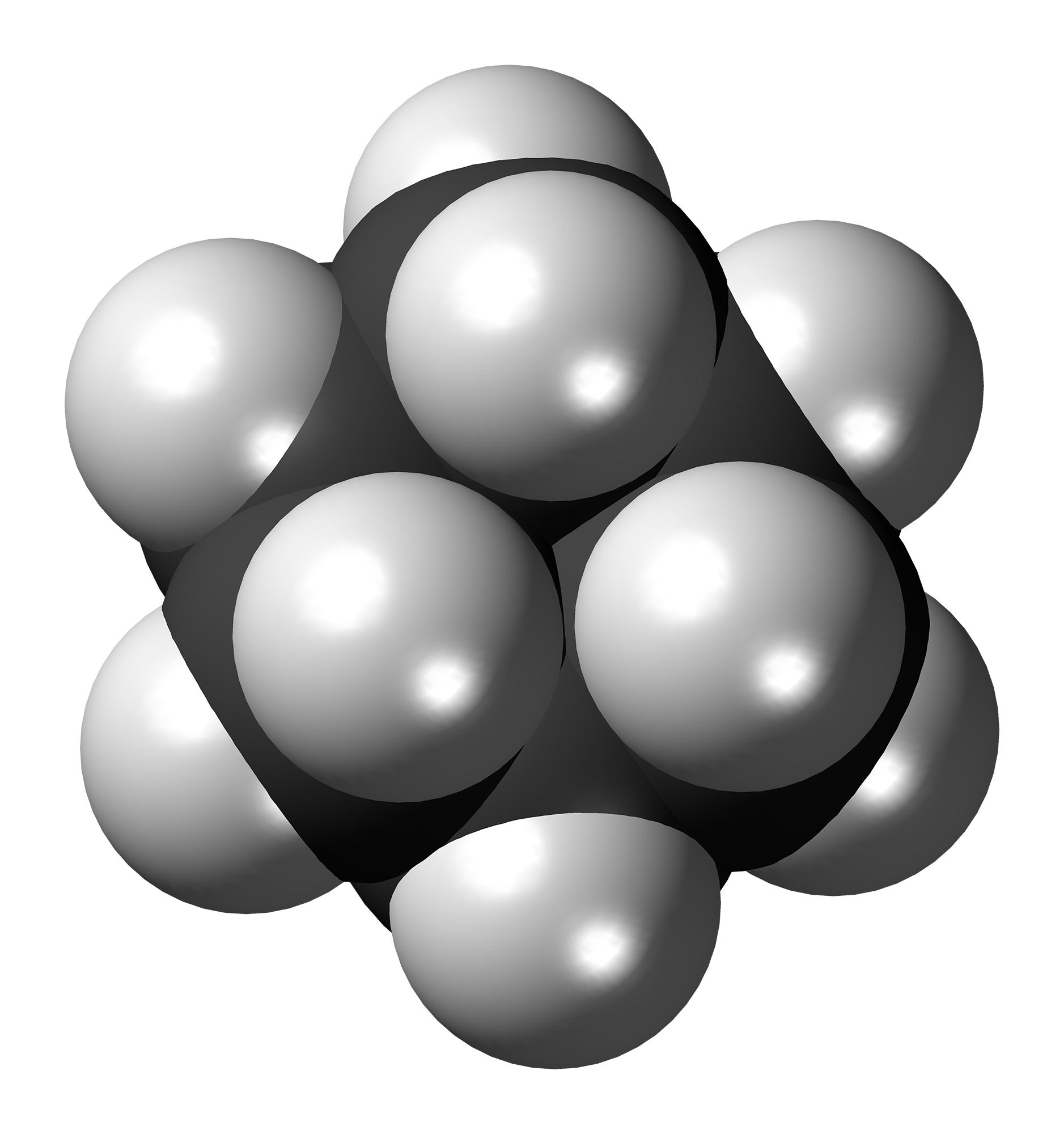
and now I have to find it with tails
and I tried, but so far didn't find it, I also begin this path and how great it is that the interest is coming from such unexpected ways
and check this out!:

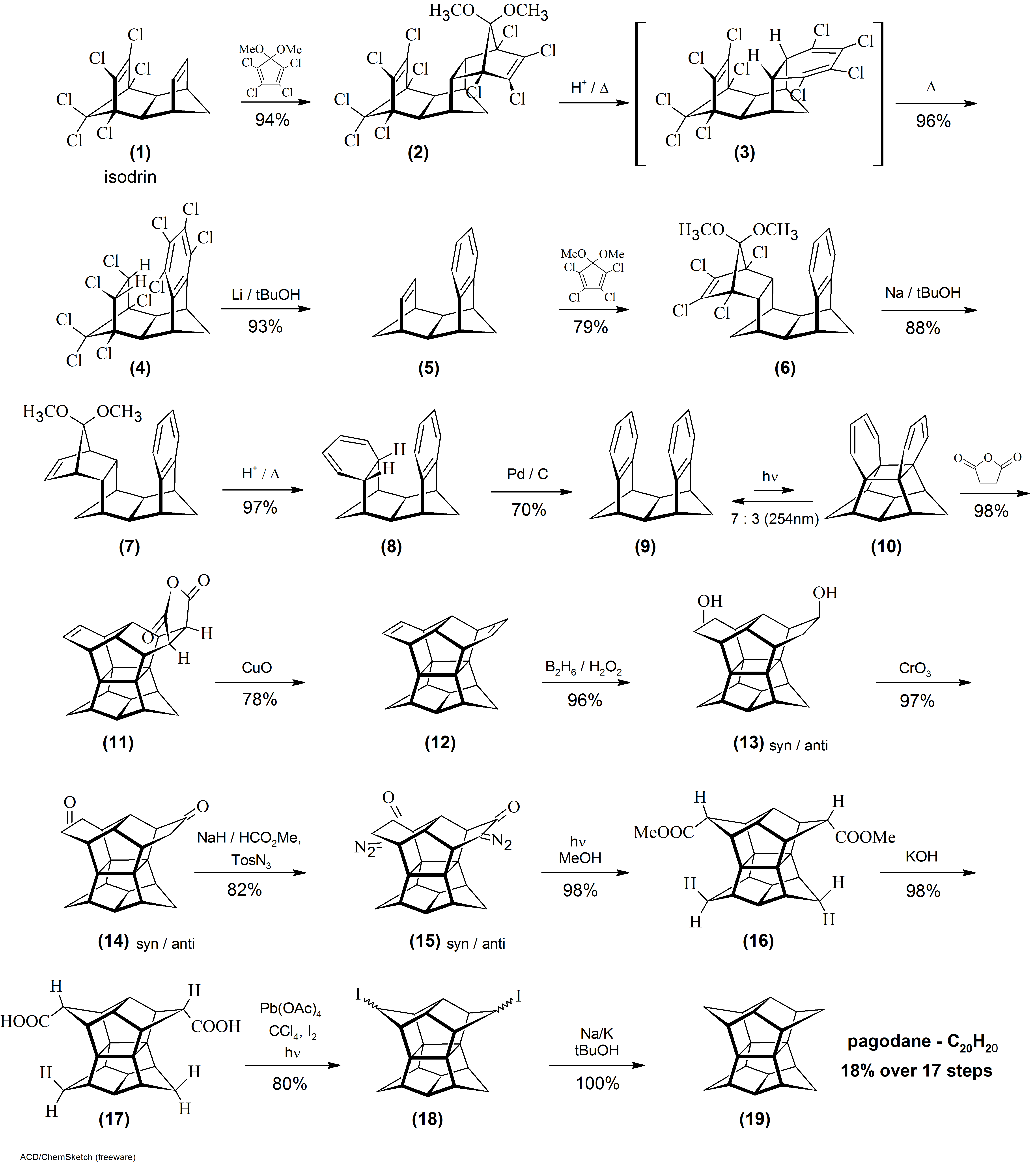
Which holds a promise that structures similar to rhombic dodecahedra are possible, and that they could be the basis of the synthesis of diamonds. But then I get the reality check:
A diamond is not considered as a molecule because each carbon atom is covalently bonded with four other carbon atoms. This is what makes diamond a network solid. Since it's a whole network of covalently bonded atoms(carbons), diamond is not considered to be one molecule.
I wish I knew what covalent is (yest, that's an irony)
well, anyway, I dig deeper and look up dodecahedron molecule, and it exists, but wrong dodecahedron:

but as for the right dodecahedron,
The rhombic dodecahedron also appears in the unit cells of diamond and diamondoids. In these cases, four vertices (alternate threefold ones) are absent, but the chemical bonds lie on the remaining edges.
fro whatever reason, rhombic dodecahedron chemical returned this formula
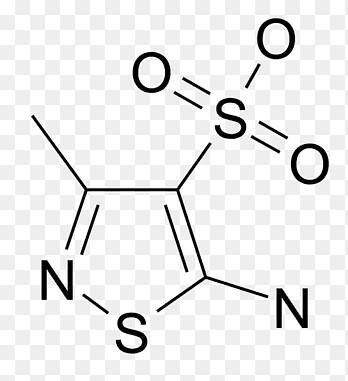
with capture of Regular dodecahedron Rhombic dodecahedron Circumscribed sphere Platonic solid, 2acrylamido2methylpropane Sulfonic Acid, angle, white png and it is neither. what is it? Chemspider comes to rescue and tells me that it is 5-Amino-3-methyl-1,2-thiazole-4-sulfonic acid
and
 is 1,4-Diethylcyclohexane
is 1,4-Diethylcyclohexanenot the ti that it tells me much, but chemspider is a real find.
but then again 1,4-Diethylcyclohexane is rather comprehensible: cyclohexane is the central structure, diethyl is two ethanes, 1 and 4 are the points those ethyls are attached at. If you're confused about ethyl being ethane, here what wiki tells about ethane: Related compounds may be formed by replacing a hydrogen atom with another functional group; the ethane moiety is called an ethyl group.
And thinking of methane, I dig deeper, and look what is methyl group:
In organic chemistry, a methyl group is an alkyl derived from methane, containing one carbon atom bonded to three hydrogen atoms, having chemical formula CH 3 (whereas normal methane has the formula CH 4). In formulas, the group is often abbreviated as Me.
and it makes me want to dig into wtf alkyl is,
In organic chemistry, an alkyl group is an alkane missing one hydrogen. The term alkyl is intentionally unspecific to include many possible substitutions.
And alkane happens to be the collective term for methane, ethane, propane, butane, pentane, hexane, etc.
At first I was like what's the difference between methane and 2,2-dimethylpropane, so clueless, but then huh, I see, finally I can read those formulas, nice, and long overdue, tbh (imagine two methyl groups attached to propane at its position second from any end. So simple, and I was not taught it in the schools.
Russian proverb about smart ones learning on mistakes of the iothers and fools learning on mistakes of themselves is fucking russians up, because it's so contradictory and actually not true, it just sounds good, and now I'm not sure about that as well: it tells that smarts learn from fools, when in reality smarts learn from everything and everybody, and even like that they still inevitably make mistakes, so don't they learn on them? When they happened to be fools, they learn from them. Эта поговорка говорит, что мы делаем ошибки когда дураки, и смотрих на других и не делаем когда умны. Но никто из русских этого не разумеет, не размовляет.. doeis мова have the same м ум дас?
one is hm?
das~does?
So that proverb, is it part of russian language, or is it a part of something larger, like the culture? Russian language is the basis of russian culture: culture is russian when it is in russian. When we're singing in tatar, it doesn't matter that the state is russian, the song is still tatar.
So is language a part of the culture. Yes, basis is the part of the structure. And what if it is like a plate the power tool is standing on? protecting it from sand underneath, is it a part of the machine or not? It depends, it depends on those who use it, because the objects understood as machine or not in the heads of the people around them (I include some the beasts, able to distinguish стано́к и ста́нок, into the people category of people)
I joked (but didn't joke (jock is jack or joke? or are they both? if jack plays as jocker in some game (as jacks (пажи (паши?)) serve both king and queen))) that I realized that I should sing with i and not u, because u is грусть, скука, скукожилса
and i is веселье, happiness is the worm gun (not warm gun, worm-gun? though it is also warm (wow! worm is warm, in the ground you can feel it not only because it moves (stone falling through your fingers also move, but I.. and not only being wet, some warms are probably not. )))
паж говорил что он паша, мол иностранные партнёры его
moh-ham-mad is all derogatory in european. moh is mos in moscow. mos cow and moh ham mad are some common deragorative deragatorative dentermentive and moscow does support the terrorists, and both oppose the West, as they call the human civiila civillization (as the opposite of Mosque Moscow is) so Grory to Ukraїne, and it is interesting how ї is unique ukrainian.. but it's only unique in russian font, in transliteration it is also seen in french, italian, dutch, catalan and english, but I never saw it in french, italian, dutch or english and I'm not sure I ever saw catalan.
Ї, ї (условное название — И десятери́чное с тремо́й; в Юникоде называется йи; произношение — [йи]) — буква расширенной кириллицы, 13-я буква украинского и русинского алфавитов. Обозначает йотированный гласный звук [ji], встречается в начале слов, после гласных и апострофа.
Ï, ï (I с диерезисом/I с умлаутом) — буква расширенной латиницы.
Встречается во французском, итальянском, нидерландском, каталанском и (в виде исключений) английском и казахском языках.
В французском, итальянском, нидерландском, каталанском и английском написание Ï означает, что буква I читается сама по себе, не образуя диграфа или дифтонга с соседними буквами, например, англ. naïve, фр. naïf, итал. naïf — наивный, простой — не образует дифтонга с «а».
В романизации казахского языка, используемой информационным агентством Казинформ, соответствует букве И в кириллице.
But then I looked it up and saw that they're all borrowed:
aïoli archaïc
beïng Béjaïa BoisCaïman Bouïra
caïc caïque caïquejee caïquejees caïques Caïssa Cap-Haïtien chemonaïve cocaïne coïncidence coïncidences coïncidentally
daïs daïses deïst deïsts doïng drugnaïve drug-naïve
egoïsm egoïstic elaïdate elaïdates elaïdicacid elaïdin elaïdins Eloïse
faïence faïences
goïng Graïba
Haïti
ïambic immunologicallynaïve -ïng intuïtion
Judaïsm Judaïsms
Kyïv KyïvanRus KyïvRus
laïcité langued'oïl
Montjuïc
naïf naïfly naïfness naïfs naïve naïvely naïveness naïver naïverealism naïverealist naïverealists naïves naïvest naïvete naïveté naïvetés naïvety Naziïsm newzaïre newzaïres
Oïllanguage Oïllanguages oleïcacid OuledNaïl
paranoïa
raï Reghaïa reïmmerse
Saïd Saïda Saïs Saïtic semi-naïf semi-naïve seminaïve skiïng
Taïwan Taïwanese Thaïland treatment-naïve
uropoïesis
weïrd
Zaïre zaïre zaïres
and I think they're some stylistic variations never seen by me because never used: weïrd is definitely the example saying that naive is normal and naïf is a whim.
This will go to TV.html or the weird proximity of T and U~V (which probably relates to BC.hmlt
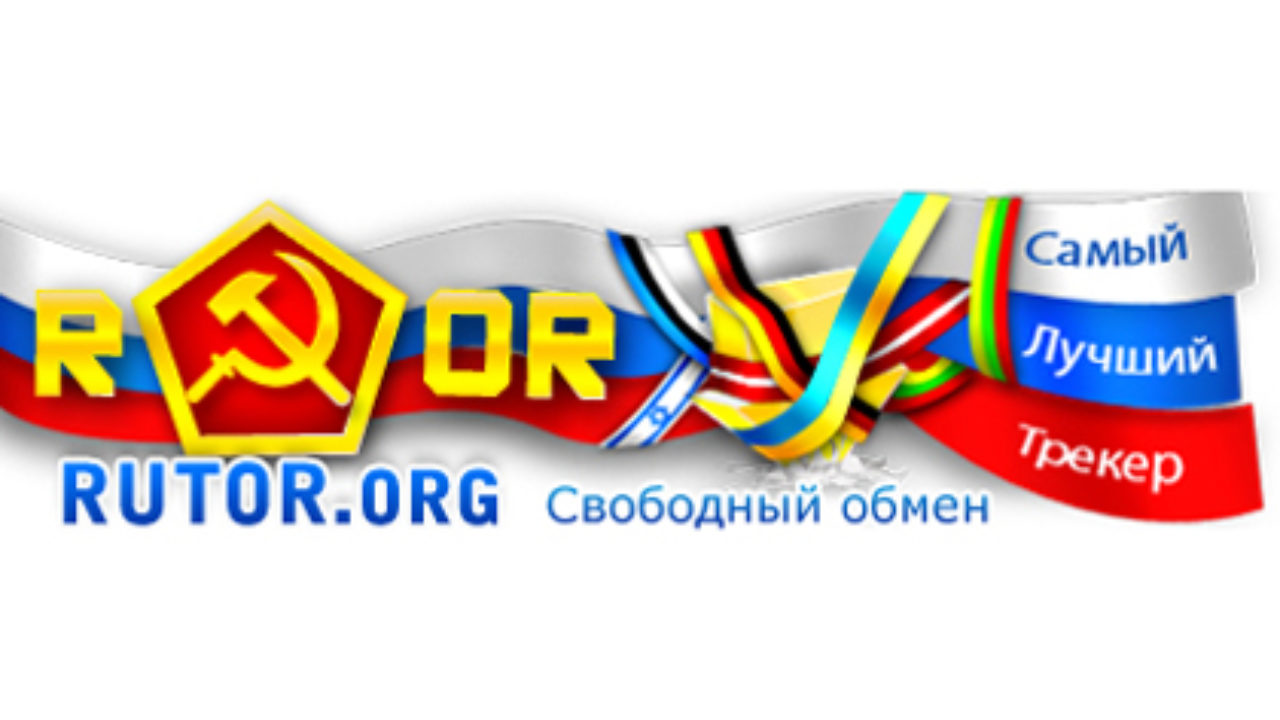
Though I rather hate those symbols, all of them, even though I like it that ukraine is trump. Russia is big, so what, Ukraine Victoria.
U vowel and labial, both soft and female. T is literally твердо. 𓏏. firm fiber food in this case, unless it is hill of anything firm and not just hill of bread. loaf. булка~хлеб (б л к~х (wow washkevich would be impressed! or lukashevich? yes, lukashevich. and who was vashkevich? the russian arabist etymologizing russian and arabic via eachother, and I'd rather get his database)) meanwhile washkevisch reiterates lukashevich's charomutie's method of reading satanically in reverse: А общее – русское слово СЛМ (солома). Если его читать латиницей и наоборот, получится в аккурат МLC. Греки перевели, получилось галактика. γάλα is milk, very interesting. галя-маля (кала хорошая: καλή, Είναι καλή. She's good. But for whatever reason if you ask them (gt) she or he, you only get αυτός and αυτή (os is like roman us, i is like roman a)
he's good είναι κάλος, so it's the same he/she, any, они. είναι is is. It is translated tranditionally like this, but could it be cognates of russian они? and brittish -ing suffix.
είμαι is am (I am) but is and are seem to be the same (probably years from now when I know greek I will laugh at these lines, or will be annoyed, you also can feel anything you feel like)
Суета и маята эвфемизмы хуеты (потому эти слова и называют матерными, что много слов от них произошло. худой? худо? хулиган? херувим? звезданулся
деть (от еть) дети d'e-ti (еть эвфемизхм слова 'l;ебать)
I wonder if cat saying мяу actually say "мясу" being unable to pronounce linguals (as chimps are unable too) they pronounce what they can (it is very confusing that pronounce, but bro pronunciation)
бабу бы
да дуди
Because I cannot see other such meaningful abugidaic sentences, let's exp[lore the possibility of five-letter alphabet of Aбуди and to my surprise I got A B D, which could be A B G the A B C, if C and D was the same letter, if only B and D were the wto two.
A
B I
D U
(a(ã(эм..)))
BE
DO
So english is the magestic angelic language? I guess many are such, but this one preserved this very element of the culture, if I worked with chinese, I would find what their culture preserved (of all our common culture)
IMNL of JK line, and the combination of two, where JK erased IMNL,
I was asking if my book is christian or antichristian, because it definitely exists in the same literary universe, it is speaking of the same components christian literature discuss, even 666 would be not known as such if not the christian book of apocalypsis. Am I at their side or at the opposite side? My initial intent is to be off all sides, opposing each of them.

The L of LABORATORY looks like V uniting the two, and thus linking the L of LГ duality to TV paradox, by ł[w] goes the other link, natural misinterpretation of a symbol.
This n shows how far that glyph may deviate without losing the readability, as such it is even weirder than ν, which we would get if the other two strokes shared the space, and thus it is linking ו and ן
Both v and n are fricative
BБ the b as the opposite to В the v
ханство хамство
Дева=Мария буквально девушка-мать, но девушка или девственница? Ведь если девственница, то не культ ли усыновления это? Не играла ли она старшую сестру спасённого перворожденного принца? Но это достойно лишь фэнтези, но не ист ои истории.
अग्निः [огней [agnéi]] fire in sanskrit; in hindi it's огни[agni] अग्नि and а̄г: आग
pentatism of
A
B I
D U
makes me think of pentagram drawn over
A
B I
D U
looking for DIBUɅ, but why is this satanism here? Because the first name I would expect around a pentagram would be that one, but what is it, if not fantasyism.
A
U E
O I with one of them is B (U is B, then I is T)
A
B E
O T
Aloha, /B/, EOT
to show randomness
and arbitrariness
A BE TO is bustrophedon if we do it like that, but it's all so arbitrary, No not arbitrary, this is a natural way to write the five letters, so why not try and see it. Abe and от от отец (от (его) яиц (is that ц of яиц and г of его are the same c? and before I even written it down, so fast that thought was, I saw egg right next to его)
A
V E
O T
veto?
обет [абет]
I read that ужин is cognate of южен
(мол положение солнца обозначало время трапезыы)
(и помятуя, что они вставали часов на пять а то и шесть раньше, очень вероятно)
(но естественно нельзя исключать и ложности этимологии, как своих так и этой)
(but take me for a poet writing about writing, and you shall feel free to enjoy the ideas)
(as they grow, even before they're crystallized into clear facts, by the fauna of the growth)
(мол положение солнца обозначало время трапезыы)
(и помятуя, что они вставали часов на пять а то и шесть раньше, очень вероятно)
(но естественно нельзя исключать и ложности этимологии, как своих так и этой)
(but take me for a poet writing about writing, and you shall feel free to enjoy the ideas)
(as they grow, even before they're crystallized into clear facts, by the fauna of the growth)
A
V I
Т О
Vita O (витаю)
эй U
В Ы
Т У
A
V I
Т О fukkenkhell, avito!
was it by accident or by
design?
tvoi (твой, твои) vita, tov, otvett, а то, tovai, veto,
obet (obeschanie)
Меньше букв позволяли создать меньше отдельных слов, а потому культура была беднее.
commonly ~ currently

Четырехчастные центральносимметричные символы на центральноевропейской керамике V тыс. до н.э. – праобразы будущих «Шлемов Ужаса»
I can see how these shapes could be used as protective tools: as scarecrows they could be used, looking as raised paw to catch teh bird. This hypothesis can be tested by using such shapes standing in the fields, to see if birds prefer to eat fruit away from these shapes. These shapes may be especially scary, if some mechanism moves those branches so that the thing seem to be alive, bonus points for those paws being able to catch the birds, but that is probably too much to ask, and too big a stretch.
In this video the ukrainian guy pronounces Λ which to russian ear sounds as V, which relates to ł[w]
выздоравливай ~ выздоровей
восстанавливай ~ восстанови
поливай ~ пои! полей, но пои!
умасливай ~ умасли? умасти?
наливай ~ на и? налей
набивай ~ набей (значит ене ливай, а ивай есть корень второй?)(
назревай ~ назрей
ноздреватый ~ ноздревой ~ ноздрей
ев есть второй корень или суффикс или что это? лив ив в?
ли ~ ив? лив? были слоги сложными, и не оттого ли одна морфема может разные формы принимать? Г~V? give? Λ~V? live? love? T~V tov? in the context of ты~вы, 你好[ni hao]
Привіт [прыви́т] sounds as you tell it when you wind yourself by the hand of the person, когда под руку кого-нибудь берёшь.
你好 looks rather phonetic: ⺅of 你 is i, thus the other part is probably no, which 不 is, only it's pu, but couldn't hieroglyphs be invented not for chinese? Not for han chinese. For japanese? iie ~ не
好 is also hao in chinese, and relates to ha being japanese ma, and the other symbol is child, which is ko in japanese.
好 is good in chinese, but in japanese it is not hao, but yoshii or ko:, other japanese good is 良い [yoy]
This part, decyphering chinese hieroglyphs by other languages is the most insane part of this thing.
This image made me thinking about the sides of the world:
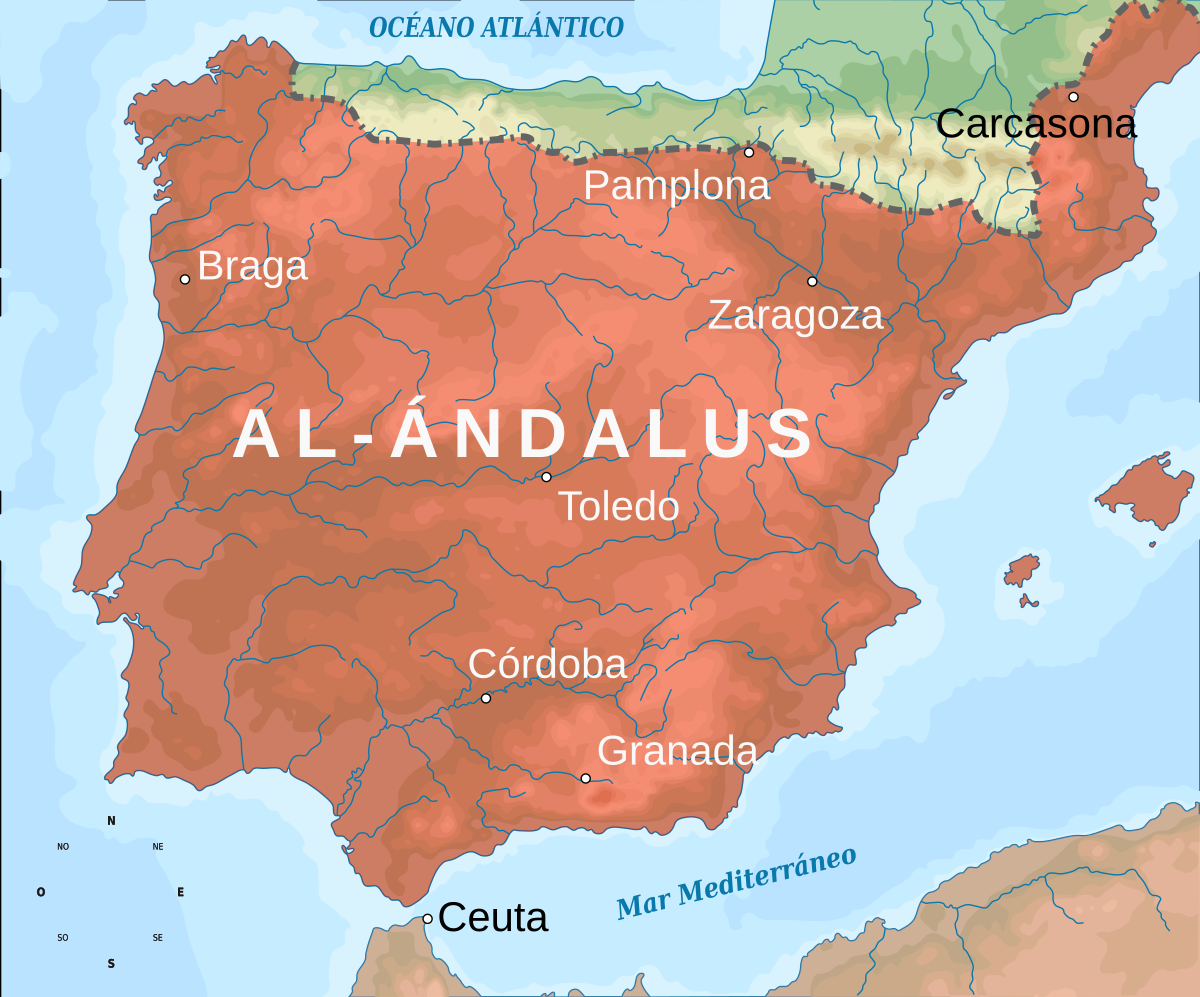
Like what if sun moved from East to West with Apogee ʌp there? then N and S are B and T, M and С:
north ~ мороз
sud ~ с юга? ~ сушь? (солнце сушит)
півНіч ~ півДень (N as in Night (might?) and g~D~S~С~G~g)
The cipher is believed to be an ancient cipher[5][6] and is said to have originated with the Hebrew rabbis.[7][8]
In 1531 Cornelius Agrippa described an early form of the Rosicrucian cipher, which he attributes to an existing Jewish Kabbalistic tradition.[12] This system, called "The Kabbalah of the Nine Chambers" by later authors, used the Hebrew alphabet rather than the Latin alphabet, and was used for religious symbolism rather than for any apparent cryptological purpose.[13]
9 chambers, and 18 letters if the dotted variants are present, but let's look which letters are dotted variants of which:
and to do so, we',lkl tyake the known 18-letter alphabet:
ᛆᛒᚦ
ᛂ(ᚽ)ᚠᚵᚼ(ᛡ)
ᛁᚴᛚᛘ(ᛉ)ᚿ
ᚮᚱᛦ(ᛣ)ᛋᛏᚢ
ᛆᛒᚦ
ᛂ(ᚽ)ᚠᚵ
ᚼ(ᛡ)ᛁᚴ
ᛚᛘ(ᛉ)ᚿ
ᚮᚱᛦ(ᛣ)
ᛋᛏᚢ
and two surprised surprises it gave me: first row appears to be a variant of fourth, unless the fourth is staveless variant of the first. And the second surprise was lmn as the beginning of that dotless block
But then similarities have to be pulled: o is not i, ᚠ is not ᚹ, and then dot would be in the second line
(let's explain how my mind sees: A is dashed Λ, B is staved M, ᚦ can be seen as dashed ᚿ. But should it be seen as such? Only going through all the set may approve or negate it:
ᚵ~ᛣ? not even graphically, unless ᛣ~ᛉ and rows go in stripes:
dotted
dotless
dotted
dotless
dotted
dotless
Thern ᚼ(ᛡ)ᛁᚴ would be the dotted form of ᛋᛏᚢ, but they are not, and thus the hypothesis is fallen flat.
The next time I approach it will probably be when I find the jewish literature speaking about that.
Let's try to play with two formulas I know even from the childhood: ёклмн и ёпрст:
because they have five letters yeach, I see them as words around pentagrams
(if they went pentagrammatically, I'll check later, but so far пентаграмма is literally пятибуквие)
Ї
N K
M L
Ö
Т П
S R
Seeing L & R one under the other is no surprise, considering the structure used in this formulas, but it tells me to arrange those stars as
М П
L N Ö R
К Ї T S
And to my surprise I see правый in that п, which corresponds to right and P~Р)
But M isn't Ϻ, which would make great sinister, but then П isn't D, so what is it? П and R being the same ᚱ? ё пр с т?. . or ё пр ст? йо пр ст?
ёк л мн?
пр правый, л левый?
мн moon, st sun (son-tse (son~солон))
I O
ΛΜ ΣΡ
I O
l Μ т r (т is russian т, it's difference with m is sometimes in vertican line above it..)
I O
l m т̅ r
and though r as l with a dot or comma next to it is a new and promising version, I do love L гr one, but let's play along with the difference of r from г, that o пр ст is dotted ΙΛΜ
iё lr ᛘT̅
And if l and r are left and right, M and Σ are middle and середина
I O are vowels of those formulaic lines, and together they give the legendary name IO
And another interesting moment about the formulas is that they contain K and R diverging their lines from being directly voiced and directly voiceless. Thus they're the black eye in the white fish and white eye in the black one. K in ILMN and R is in OPST (notice that as that fish these eyes are excentric (are they two sides of the same face?)) пусть & let me? let me in! пусти!
К is LMN? key is let me in? R is more bestial form of it, пусти is russian word, and those tartars are savage and thus primal. L is more polite form of R? Not rule, but let?
A B G D
E V J Z
I M N R ? and no, modern alphabets always have L in that line, R is around P which it probably is.
O P S T
a b g
e w z (w as lucky middle between v and m, z as both z and ž and RCH and N~Z in ŋ~g~ζ
o p t (ת is both s and t (without t it's θ) but g is both g and d, is t also k? if t and s are c, so is k)
O П Г grapically remind E F Г, also returning to г, and both П and F being not only second, but also triple. four~vowel? like literally? oh wow! labial triad? as three female entities? two of the lingual? Unless, as Pushъking said, they counted angles, so 1 is one angle.
O П Г? in the context of A U E it is wild
шишки ~ сиськи
семки ~ соски
abd
epq epoque?
is a ā? long d? da? daaa? a=ya? ja? yeah!
then is e o̱? is a ō?
is o ǝ? and a was taken high, and e low? it is how arabic they have, only instead of a they sign thus u
(yes, the opposite of modern european tradition)
abd
epq Mye guess is that first line is voiced and exhale, while this one is inhales and thus voiceless
(except e, we can give voiced vowel on the inhale, but inhaling consonant
is difficult to make voiced)
the other letters are
c f g h i j k l m n o r s t u v w x y z
c is г, f is гг
g is г, gh is f
..and all of a sudden that's it, unless i is j and j~g, k~g (both are c) and Λ~𐤂 and M~ΛΛ and N~Г (and in between the ΛM and after them at the same time) and o~ɔ~c, r~г, s~c~г, t~s? T~Г (ᛏ~ᛐ~ᛚ) and that is it
u~v~w~y (and then г[v] in russian and japanese) and x~z, both are cc
коту́шка (кот кота́ет (пёс пугает? pushes, толкает, лапами передними прыгает приветствуя))
is doг the opposite of [kot]qoᛐ?
собака ~ котка
шуба? копака! копака и котака
п as in пёс, т as in кот? тот? did knorozov tell sense when he told that his cats helped him decypher it?
пёс & puss (were these two words cognates? did it tell that both animals shit piss indoors, and thus to be kept outdoors?)
I opened this day's sessions with ning chambers, let's close this topic:

It caught my attention because it shares the alphabets into triads, as I used to do, only I had IJK and LMN in separated triads, but then didn't I combine OP and QR? I have to check my old notebooks.
Either way it is weird to assume that they didn't have pure undotted forms, unless C G L P U Y are they, and M~O, D~F, V~X which is not so, so no. This table seems to be further from the source than the one attributed "to an existing Jewish Kabbalistic tradition" especially that manages to have exactly 26 letters, and thus could be the determenative of the canon of latin alphabet.
but let's be real and entertain the idea of 18-letter alphabet.. it should end with T with O in the centre of the dotted square.
ABC KLM
DEF NOP
GHI RST
and let's entertain the idea of three dice..
ABC GHI NOP
DEF KLM RST
(and here is where I go to sleep, see ya tomorrow; even though, astronomically, today)
Good Morning Gentlemen
(the word gentlemen is antisemitic)
Applying my mind to different fields get different results, so now I applied to some non-genetic
Double slit experiment is retarded, because obviously sensors change the geometry of the slits, and in different geometry different patterns. I can only guess the origin of the interference pattern. My previous guess was thata the rectangular shape of the border of the slit may cause the pattern
and now I thought about the sensors, how it work on the energy of the electrons flying by (I doubt they could sensor single photons back then) and as that electron bounced off the edges of the slit, now it gave that bounce to the sensors and was left to go as a drop of water or matter vertically to the wall (imagine it being down, but then maybe light can be emitted down to the wall abd bit and not just floor)
Growing organs as animals, integrating into the body? Maybe even as some external leech.
Temperature is rotation of time so to say, if we freeze the object, the antropy of the world is not acting upon that. And it's just below zero celsius, not zero kelvins. And because there's no such thing as negative temperature in kelvins, there's no time travel backwards. We only know how to stop time for the object. At zero celvins there's no entropy on exactly different level, not just on biological (complex) systems, but also for every physical system on the lower level. But then wouldn't space radiation damage frozen tissue (after the process of freezing has damaged it) or would it give it energy to go?
abd bit appeared in the previous thing,
aбд
opq
aбд
opq
д ~ g, and q is different from g by the lack of that ̃ ~ ̮
tes͡t (ctrlshiftu 0361)
so is opq more basic than abd?
аВД
оПТ
(shape of the Д can vary from this prism to D's semicircle to Δ's triangle, but what matters it is one, unlike B, but then there are V, b, and thwere are cursive Д which may have three cells, similar to these ⰇⰈⰎⰘⰡⰦ and none of them, but Ⱑ is very egyptian, the most egyptian letters of even egyptian letters, and though glagolica has plenty of them: Ⱄ has lower part piramidal in some other fonts, and as such it is the opposite of Ⰻ.. ffs!)

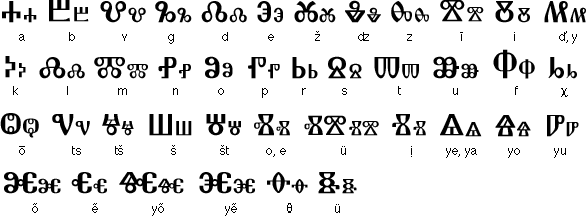
here, s reflects i like ᛌ reflects ᛧ, but ᛧ is R, not I, its parent shape is also z and x, but not i, are ᛌ and ᛧ
s and z? is that R of chinese kind, either way, I will remember algiz as z, which is weird, I doubt if it's true.

notice f combining shapes of f and ф and notice h next to it, reminding h and the f next to it. is it ſ the ʃ of h the aʃ? and s the Ⱄ is spectacular and doesn' treflect any i anymore. But then this chart is Cursive Glagolitic provided by Igor Kusin and who knows if it is authentif. It doesn't mean it isn't, the guy could make legit work of catalogizing glyphs of glagolitic manuscripts, but then he would provide many shapes. Either way, the other charts, provided to this work anonymously, are ionly more legit because they're popular. So popularity legitimizes (not only politicians, but scientists too)
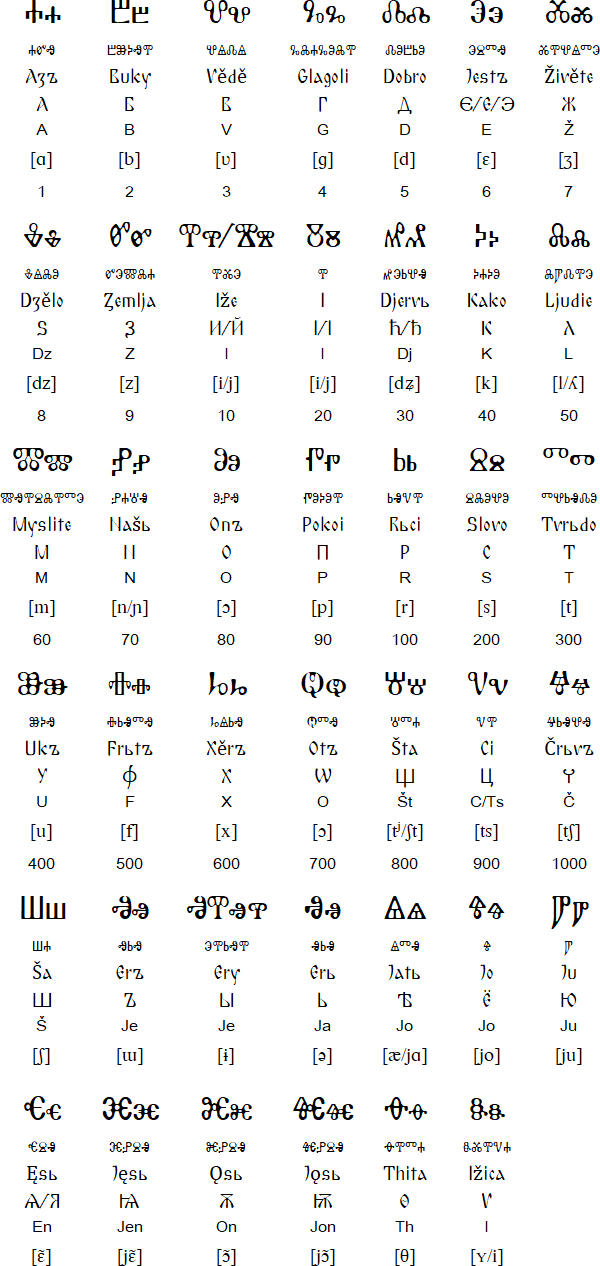
благо~глаго?
славо~слово?
My guess after watching the previous comparison of glagolitic and kyrillitic (not lythic, kyrillic, killer kiriller (kiri is to cut and kill in japanese, if it is english borrowing or authentic thing I can only guess, I think it's authentic, it's too ingraned even in writing: り the リ looking like the corner of their sword))
So my guess is kyrillic christianization was to substitute glagolitic with more pro-european script. Check the Jen and esepcially the left form of kyrillic En. They're the piramidal form of glagolitic Yatt the Ⱑ the Ѣ and though both have lower right bubble and both horizontal and vertical line, Ⱑ and Ѧ are considered to be different letters, but both are vowels, and the differentce is rather arbitrary for as I said symbols predate alphabet. And allowing local graphemes, christians built their own alphabet
ir in their is plural suffix similar to ir in aettir and lar~dar in tartar
Tartarian and Barbarian? were we communicating before greek and roman civilizations appeared in between? Were etruscans ancestors of the russians? It is a freaky guess, but I allow all the guesses, so I can choose from them the ones which play along with each other, because reality is all interconnected, while fantasy can be chaotic.
A B D
E F Г
I M Λ
O П Т
π τ
Thus could e be the alphabet of 12, alphabet forom pairs of double and single shape. Labials are double (two lips) and linguals are single (one tongue)
and when U line appeared, they already didn't keep this structure (and the other structures could appear when somebody heard that it had some structure, so having nobody to know this strucrute structure from)
EIOA ~ EIOwA ~ EIOÃ => ÃEIO of ABDEFCIMLOPT or ⰡBDEFCIMLOPT
Ⱑ appeared from EFГ taking vowel into this dance. is I 一 the 𓈖? is O Y? Y would make perfect 3
Ⱑ B D
E F Г
I M Λ
Y П Т

is? the ᛁ?
.png)
ᛵ is ᛁ~~! what were the chances!!! Yes, it supports this guess. EFГ, thank you very much.
Ⱑ B D
E F Г
ᛵ M Λ
Y П Т
if Ⱑ is top
E is middle
M Λ are doors
if they have сваи как Y, это будет подтверждено. А если нет? то неподтверждено. а может и опровергнуту, beatuy is in the eyes of beholder.
YПТ are columns, something standing before the actual entrance, which explains how design is shown, not the foundations for people do not see them, and enemies shouldn't know them, and architects shouldn't be limited in the technological developments. Design matters, other aspects are subordinated to function.
ⰡBD BoulDers (is R Ⱑ? ar[ʌ]) and the top?
EFГ ladder
ᛵMΛ entrances ᛵ could be cuts through
YПТ
ᛵMΛ being read from right to left may sound as eLeMeNT if lingual N and T are consonant shapes of vowel И and I, just as english "and" is "и" in russia, very similar languages, how could they not have cognates here? да is another one? Only if yes and and cognates, and they may be. Yes? И? can this one word sentence of continuation's imperative be translated one into the other? Probably no, And would be the translation, why would someone say yes if he didn't know the continuation.. So, no? So I don't know. Let's leave it for later, I think something bigger doesn't let me look at this one.
Дыба?
Гафе?
but I took such liberty with LMI, that why
Топи?
дыба и топи хорошо сочетаются, а остальные что за бред? И зачем такую жесть в такую прелесть? А зачем читать наоборот? Здесь самые прекрасные удовольствия, получающиеся если самые страшные неудовольства наоборот прочитать%:
ABD обед
EFГ (I think it's fucking)
IML имел это точно про факинг
YПТ опыт? опыт это тоже приколькоа прикольная фигня
(но покушать сголодухи всего вкусней (не дай боже так оголодать))
EFГ you fuck? (not you are)
IML имел (нега после секса?)
вот так секс разошёлся меж коханем and love
ABD (B is both B[b] and В[v], D is both D[d] and Ð[ð])
IML
YПТ (פ is both p and f, ת is both t and þ)
thus these three easily unfold into five, and start demanding more letters on the other axis. Thus nine became twenty something.
ⰡBD Ⱑ ~ Ѧ
EFГ
ᛵMΛ ᛵ ~ 𓈖 as I ~ 一? because this ᛵ is the weakest point of this thing so far. Even Y is better.
YПТ
Basicallyt it is my new favourite thing, and let's combine it with voiced/voiceless thing:
a b d or a b d
EWЗ
but other lines don't play this game, but let's play it without the graphic component
I M L
Y П Т they're basically how we had it in deski alfavit (the 4×5 one)
But I think 3×3 is better than this (this is not having UFS row, but why? Because T is the final letter, as it is known to be.
ⰡBD [a/e b/v d/z]
И MΛ [i/j m/w l/n]
O ПТ [o/u p/f t/s]
EVZ
JWN
UFS ?
ADAM EVU? EVE!
ADAM (closed and male syllable)
EVE, EVA ((but us A's in the other group, thus EVE) open female syllable)
Austria is eastern, Australia is southern, like the etymology of the words. Is it even true that Australia is of south and not east? Auster and Austrellus is south. But how did it happen? Is it because what is East for one nation South for the other? Technically, it is possible, and it is not unprecedented:
Ниже - две схемы названий сторон света: финская и эстонская.

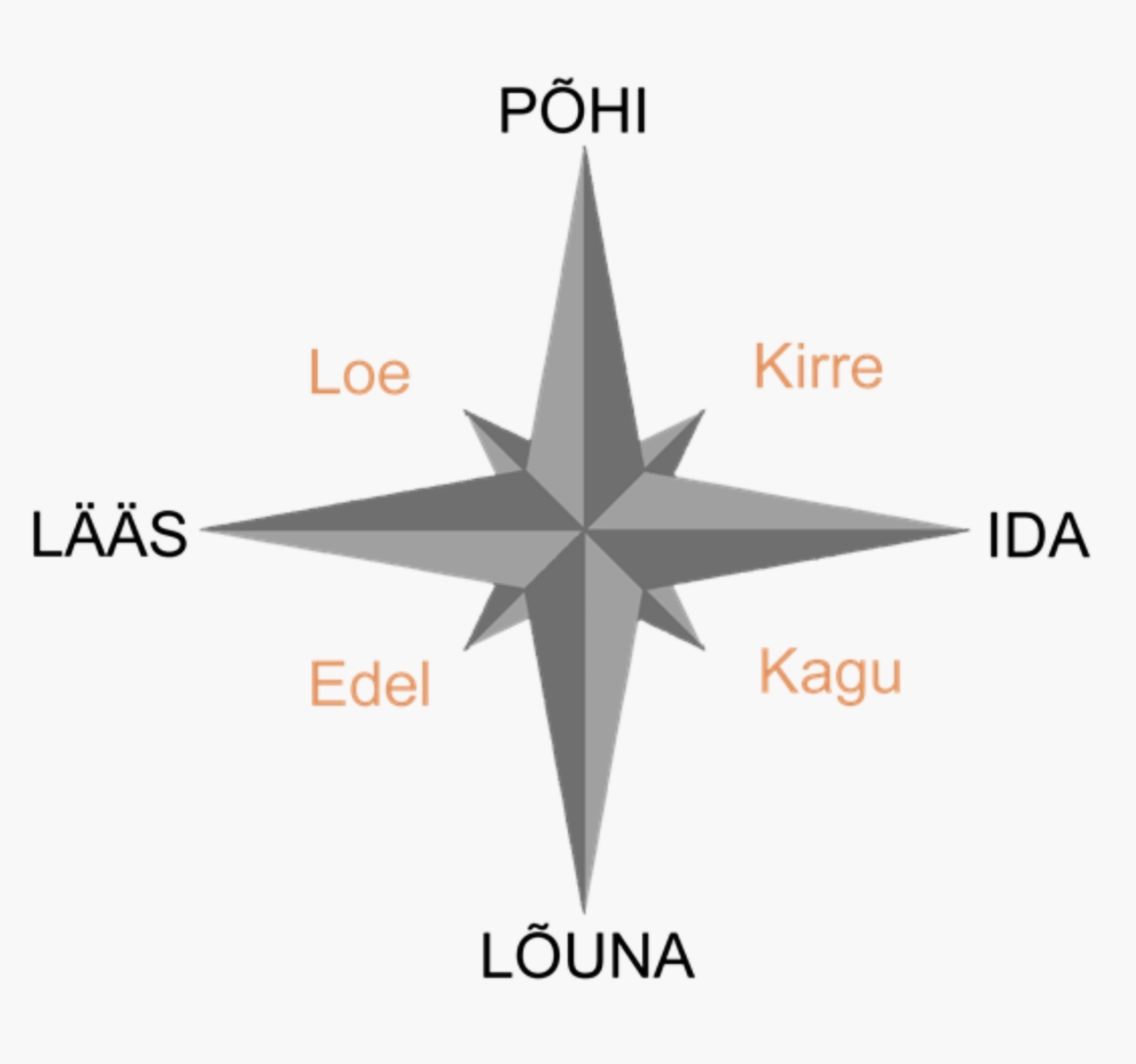
Казалось бы, языки очень близки. И слова похожи.
За одним исключением: юг и юго-запад "перепутаны".
Финское etelä соответствует эстонскому lõuna.
А эстонское edel = финскому lõunas.
(в комментах дана хорошая версия про соответствие сторон света названиям ветров)
там же сказано, что ужин от слова южен, оттуда подчерпнул
Триде́ви (санскр. त्रिदेवी, IAST: tridevī) — три богини) — термин в индуизме, объединяющий трёх богинь (женский «аналог» Тримурти — подобно дэвам тримурти эти дэви (богини) в разных текстах находятся в определённых соотношениях[источник не указан 2733 дня]), трёх супруг богов Тримурти:
Сарасвати — богиня мудрости, знания; супруга Брахмы
Лакшми — богиня изобилия, процветания, богатства, удачи и счастья; супруга Вишну
Парвати (или Дурга) — богиня времени, власти, духовного осознания; супруга Шивы.
В праздник Наваратри — «Девять ночей» — «Богиня почитается в трёх формах: в течение первых трёх ночей, почитают Дурга, Лакшми в четвёртую, пятую и шестую ночи, и, наконец, Сарасвати седьмую, восьмую и девятую ночи»[1].
В шактизме Тридеви считаются изначальными формами Махашакти — Махасарасвати, Махалакшми и Махакали — проявленными в мир и дарованными богам Тримурти как их шакти и супруги[2][3].
Night nights Nine nights for three deities reminds me nine muses which I divided into three domains, and it allows me to link those domains to tridevi to see if it works.
Шакти́зм (санскр. शाक्तं, IAST: Śāktaṃ в буквальном переводе — «доктрина силы» или «учение Богини») — направление индуизма, основанное на поклонении Шакти, или Деви, — Богине-матери в индуизме — как абсолютной и изначальной форме Бога. Последователи шактизма именуются шактами (санскр. शक्त, IAST: Śakta).
Наряду с вайшнавизмом, шиваизмом и смартизмом шактизм является одним из четырёх основных направлений в индуизме. Наиболее влиятелен он в таких штатах Индии, как: Западная Бенгалия, Орисса, Ассам, Трипура, Тамилнад, а также в Непале. По наиболее распространённой оценке его доля среди всех индуистов составляет около 3 %[1][2].
В целом шактизм выступает индуистской версией почитания богини в других религиях. При том, ни в какой другой религиозной традиции мира не присутствует доктрина, отличающаяся такой откровенно «женской» ориентацией[3]. Важное место в практике занимает обожествление самой женщины, поэтому (как считают шактисты) женоненавистники в принципе не способны практиковать в рамках данной сампрадайи[4].
Этапы развития шактизма отражают историю индуизма в целом: Индская цивилизация; ведизм; брахманизм и, собственно, индуизм. И хотя в Ведах присутствуют посвящённые богиням гимны, но они играют значительно меньшую роль в сравнении с патриархальными культами богов. Поэтому, ряд учёных, например, Рамчандра Нараян Дандекар, считает, что культ Шакти восходит к доарийскому культу Богини-Матери[5].
Шри́-я́нтра — наиболее знаменитая из всех тантрических янтр. Представляя собой мистическое устройство космоса, Шри Янтра образована взаимным пересечением треугольников в двух направлениях: четыре вершинами вверх, символизируя мужской принцип, и пять вершинами вниз, символизируя женский принцип. Эта янтра изобретена для того, чтобы дать образ полноты и целостности существования.
Построение рисунка вне центральной окружности варьируется от примера к примеру. Построение же рисунка внутри окружности приводит к необходимости или кропотливой подгонки или вычислений. Классическая литература не содержит описания внутренней конструкции, которая позволила бы свести её к единому геометрическому представлению. Встречающиеся в литературе описания допускают бесконечное количество форм, каждая из которых определяется теми или иными ограничениями[1][2]. Различными авторами высказывались доводы в пользу той или иной формы[2][3].
Для практического построения символа используются различные рецепты, а для зрительной компенсации получившихся неточностей линии искусственно уширяются. Методы приближённых вычислений позволяют с любой наперёд заданной точностью рассчитать параметры фигуры, соответствующей заранее наложенным условиям[1].
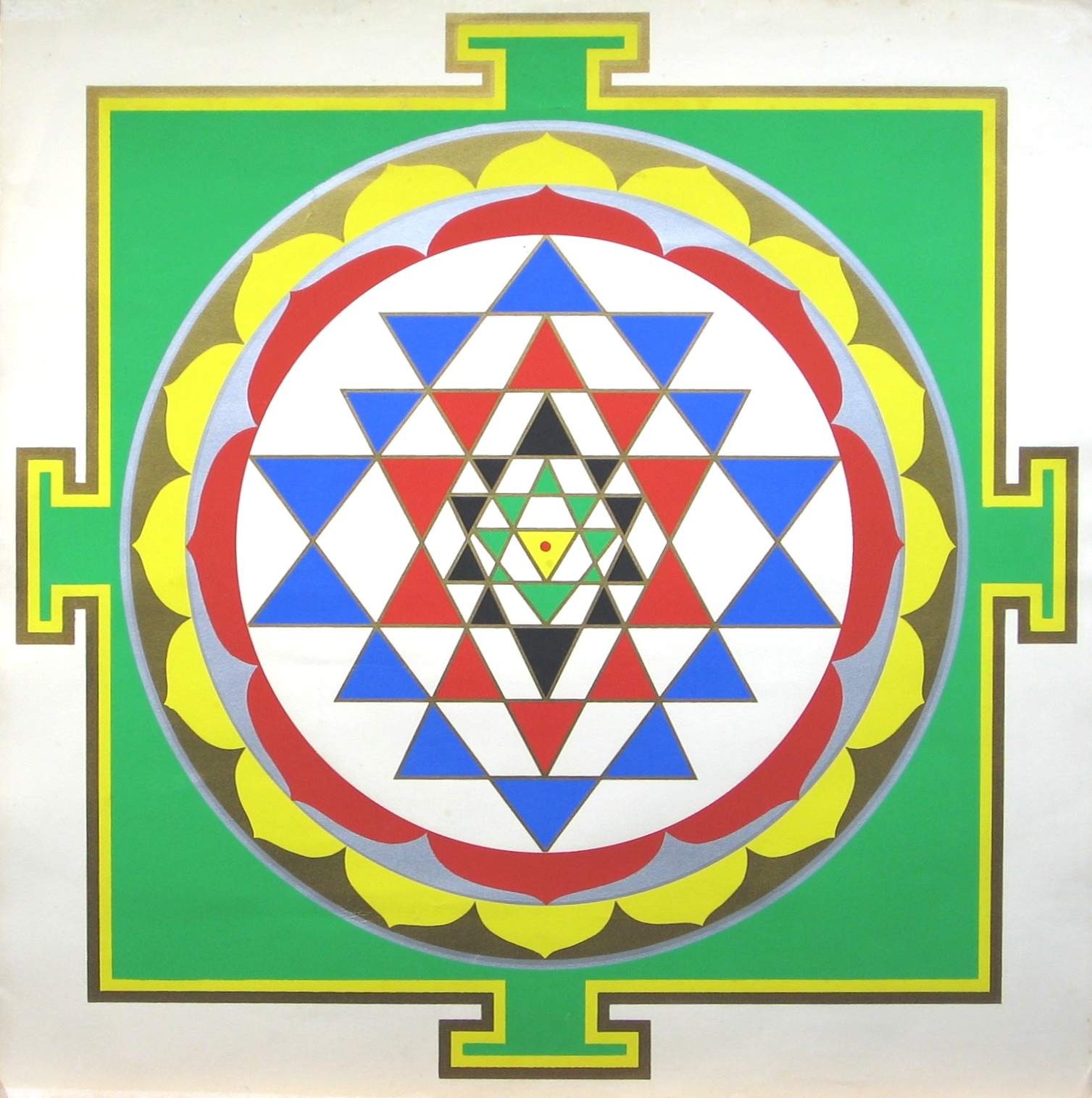
This one is called Sri_Yantra_Correct_Colors_Johari_1974
I suppose, that dot is on the forehead of a hindu.
And I can only guess what those triangles can symbolize. And because of the dot, I believe that the six outward triangles contain the world, while the inner three triangles symbolize the practicioner.
The inner shape is lotus, and thus probably symbolizes the pose of the practicioners. 8 inner lepes and 16outside lepels.
I suspect the black triangles to be our омрачённое сознание, но зелёный цветок внутри него может символизировать конуплий
In shri-yantra we have 9 triangles, which can be aligned with 9 nights of navaratri
The word Navaratri means "nine nights" in Sanskrit, nava meaning "nine" and ratri meaning "nights".[3]
Day 1 – Shailaputri
Pratipada, also known as the first day, is associated with the form Shailaputri ("Daughter of Mountain"), an incarnation of Parvati. It is in this form that Durga is worshipped as the daughter of Himavan (the Guardian God of Himalaya). She is depicted as riding the bull, Nandi, with a trishula in her right hand and lotus flower in her left. Shailaputri is considered to be the direct incarnation of Mahakali. The colour of the day is yellow, which depicts action and vigor.[30] She is also considered to be a reincarnation of Sati (Shiva's first wife, who then reincarnates as Parvati) and is also known as Hemavati.[31]
Day 2 – Brahmacharini
On Dwitiya (second day), Goddess Brahmacharini, another incarnation of Parvati, is worshipped. In this form, Parvati became Yogini, her unmarried self. Brahmacharini is worshipped for emancipation or moksha and endowment of peace and prosperity. Depicted as walking bare feet and holding a japamala (rosary) and a kamandala (pot) in her hands, she symbolizes bliss and calm. Green is the colour code of this day. The orange colour which depicts tranquility is sometimes used so that strong energy flows everywhere.[citation needed]
Day 3 – Chandraghanta
Tritiya (third day) commemorates the worship of Chandraghanta – the name derived from the fact that after marrying Shiva, Parvati adorned her forehead with the ardhachandra (lit. half-moon). She is the embodiment of beauty and is also symbolic of bravery. Grey is the colour of the third day, which is a vivacious colour and can cheer up everyone's mood.[citation needed]
Day 4 – Kushmanda
Goddess Kushmanda is worshipped on Chaturthi (fourth day). Believed to be the creative power of the universe, Kushmanda is associated with the endowment of vegetation on earth, and hence, the colour of the day is orange. She is depicted as having eight arms and sits on a tiger.[citation needed]
Day 5 – Skandamata
Skandamata, the goddess worshipped on Panchami (fifth day), is the mother of Skanda (or Kartikeya). The white colour is symbolic of the transforming strength of a mother when her child is confronted with danger. She is depicted riding a ferocious lion, having four arms, and holding her baby.[citation needed]
Day 6 – Katyayani
Born to sage Katyayna, she is an incarnation of Durga and is shown to exhibit courage which is symbolized by the colour red. Known as the warrior goddess, she is considered one of the most violent forms of Devi. In this avatar, Katyayani rides a lion and has four hands. She is a form of Parvati, Mahalakshmi, Mahasaraswati. She is celebrated on Shashti (sixth day). In eastern India, Maha Shashti is observed on this day and starting of shardiya Durga Puja.[citation needed]
Day 7 – Kaalaratri
Considered the most ferocious form of Goddess Durga, Kalaratri is revered on Saptami. It is believed that Parvati removed her pale skin to kill the demons Sumbha and Nisumbha. The colour of the day is royal blue. The Goddess appears in a red-coloured attire or tiger skin with a lot of rage in her fiery eyes, her skin turns dark. The red colour portrays prayer and assures the devotees that the Goddess will protect them from harm. She is celebrated on Saptami (seventh day). In eastern India, Maha Saptami is observed on this day and Bodhon of shardiya Durga Puja.[citation needed]
Day 8 – Mahagauri
Mahagauri symbolizes intelligence and peace. It is believed when Kaalaratri took a bath in the Ganga river, she gained a warmer complexion. The colour associated with this day is pink which depicts optimism. She is celebrated on Ashtami (eighth day). In eastern India, Maha Astami is observed on this day and starting with pushpanjali, kumari puja etc. It is a very important tithi and considered as the birthday of Mahishasura mardini rupa of Chandi.[citation needed]
Day 9 – Siddhidatri
On the last day of the festival also known as Navami (ninth day), people pray to Siddhidhatri. Sitting on a lotus, she is believed to possess and bestows all types of Siddhis. Here she has four hands. Also known as Mahalakshmi, The purple colour of the day portrays an admiration towards nature's beauty. Siddhidatri is Parvati, the wife of Lord Shiva. Siddhidhatri is also seen as the Ardhanarishvara form of Shiva and Shakti. It is believed that one side of Lord Shiva's body is that of Goddess Siddhidatri. Therefore, he is also known by the name of Ardhanarishwara. According to Vedic scriptures, Lord Shiva attained all the siddhis by worshipping this Goddess.[citation needed]
In most parts of India, tools and weapons are worshiped in a ritual called Ayudha Puja. Many businesses also grant a holiday to their employees on this day.[32][33]
So nine is just a number, so maybe not, but maybe yes. 9 triangles in 3 kinds of triangles (if we combine the inner triangles into their own group regardless of the direction, which is a weak point) in the same teaching, having 9 festivity days for 3 goddesses.
Kali is black (слово родственное русскому карий и японскому кирой курой (и в свете этой опечатки, красный и чёрный и грамматически похожи, и чёрный от крови, бурый~курый (t~v, b~h) словно от дыма окуренный, обжаренный, опалённый, опчерненный, опАлен)) и в шахматах взаимозаменяемые цвета. Червоно заолото, красное, черви не чёрная мастЬ, а красная.
о боже, индуизм это что-то: этим общим словом сметают воедино всё по географическому принципу, для всех тех учений в английском просто слова нет, только заимствования
Панчамакара (санскр. पञ्चमकर, IAST: pañca-makara — «Пять букв М»[1]) — тайный парный ритуал в тантрическом шиваизме и шактизме. Второе, менее известное и реже употребляемое, название — Панчататтва (санскр. पञ्चतत्त्व, IAST: pañca-tattva — Пять принципов). Основная его форма заключается в последовательном предложении во время пуджи иштадевате небольшого количества вина, мяса, рыбы, жареных зёрен (которые после окончания предложения съедаются) и ритуального соития. Обычно в качестве божества выступает партнёрша, которой выполняющий ритуал мужчина предлагает четыре первых элемента; пятым элементом — соитием — ритуал завершается. При этом партнёрша символизирует собой Шакти, а партнёр — Шиву, который поклоняется ей, что отражает одно из основных правил шактизма — Шива без Шакти является трупом:
Шива сказал:
О Богиня, без Шакти Я [был бы] всегда подобен трупу (шава). Когда Я соединён с Шакти, Я – Шива. … Я – Шива лишь благодаря единению с Шакти. Если успех (сиддхи) не достигается пребыванием с женщиной, тогда, о Всевышняя, [всё], что Я говорю – бесполезно… Следует оставить все святые места и, во что бы то ни стало, идти в общество женщины. [Ибо] сказано Мною: успех достигается лишь в обществе женщины и не иначе.
Гуптасадхана-тантра 5.10-17)[2]
В некоторых случаях ритуал проводят на свежем трупе (शव шава) молодого мужчины.[3]
(предполагаю, что на трупе убитого жениха этой женщины)
Panchamakara or Panchatattva, also known as the Five Ms, is the Tantric term for the five substances used in a Tantric practice. These are madya (alcohol), māṃsa (meat), matsya (fish), mudrā (grain), and maithuna (sexual intercourse). Taboo-breaking elements are only practiced literally by "left-hand path" tantrics (vāmācārins), whereas "right-hand path" tantrics (dakṣiṇācārins) oppose these.[1]
मद्य — madya — мадья (вино).
मांस — māṃsa — мамса (мясо).
मत्स्य — matsya — матсья (рыба).
मुद्रा — mudrā — мудра (жареные зёрна).
मैथुन — maithuna — майтхуна (ритуальное соитие).
The word mudra has more common meaning: A mudra (/muˈdrɑː/ ⓘ; Sanskrit: मुद्रा, IAST: mudrā, "seal", "mark", or "gesture"; Tibetan: ཕྱག་རྒྱ་, THL: chakgya) is a symbolic or ritual gesture or pose in Hinduism, Jainism and Buddhism.[1] While some mudras involve the entire body, most are performed with the hands and fingers.[2]
The Brahma Yamala, a tantric text, says there are three currents of tradition (dakshina, vama, and madhyama) characterized respectively by the predominance of each of the three gunas (sattva, rajas, and tamas). According to this text, dakshina is characterized by sattva, and is pure; madhyama, characterized by rajas, is mixed; and vama, characterized by tamas, is impure. The tantras of each class follow a particular line of spiritual practice.[3] Dakshinachara consists of traditional Hindu practices such as asceticism and meditation.
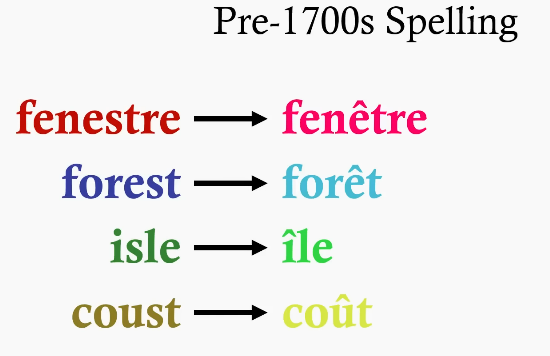
is forest бор+est? furthest? чаща, гуще, дичее, далечее
But then Austria meaning Southern instead of Eastern makes much more sense, considering the fact that it is a german territory, laying to the South of the actual Germany.
I cannot be a writer as long as I smoke (I wrote that booklet being sober, but all the material is acquired when high. I am not a writer, I am a researcher, who carries a log (this one) and occasionally edits overviews.

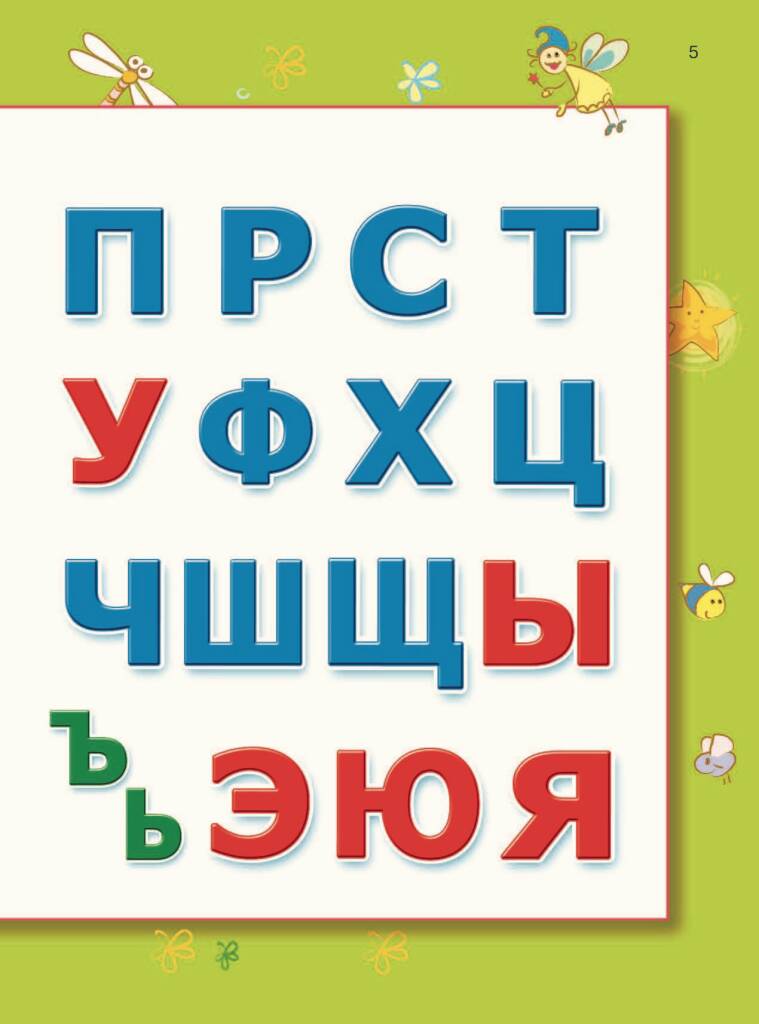
here, I looked up
the detski alfavit png
in yandex and they
found me this.
And I noticed how
interestingly vowels
are aranged along the
diagonal when you
look at it like this.
if ы(ъь)эюя is a vowel set, it's i?eua but it is so non-chromatic.
?i?e-Y-az
?i?e-ju-ja
why yo escaped this band of saints? vowels of past-yoted/uyoted-separation reform of the alphabet.
ieu is probably the initial set, U being final is how it went in the archaic period (in both latin and norsk)
and Å is final in dannish and norwegian alphabets (having ÆØÅ at the end, which honestly reminds russian ЭЮЯ)
swedes and finns put ÅÄÖ after Z
 .
.A bilingual sign in Nuuk showing the contrast between Danish and Kalaallisut. The sign translates to "parking forbidden for all vehicles".
I brought it here to wonder how dannish is comprehensible (not only to those who sees car in køretøjer, but also to those who sees plural suffix to каретой (english to is used as japanese use it)) while other is much less with only motor being understood, for kalaallisut is some eskimo-aleut:
Greenlandic (Greenlandic: kalaallisut [kalaːɬːisʉt]; Danish: grønlandsk [ˈkʁɶnˌlanˀsk]) is an Eskimo–Aleut language with about 57,000 speakers,[1] mostly Greenlandic Inuit in Greenland. It is closely related to the Inuit languages in Canada such as Inuktitut. It is the most widely spoken Eskimo–Aleut language. In June 2009, the government of Greenland, the Naalakkersuisut, made Greenlandic the sole official language of the autonomous territory, to strengthen it in the face of competition from the colonial language, Danish. The main variety is Kalaallisut, or West Greenlandic. The second variety is Tunumiit oraasiat, or East Greenlandic. The language of the Inughuit (Thule Inuit) of Greenland, Inuktun or Polar Eskimo, is a recent arrival and a dialect of Inuktitut.
Greenlandic is written with the Latin script. The alphabet consists of 18 letters:
A E F G I J K L M N O P Q R S T U V
⟨b, c, d, h, w, x, y, z, æ, ø, å⟩ are used to spell loanwords, especially from Danish and English.[98][99] Greenlandic uses "..." and »...« as quotation marks.
AEFGIJKLMNOPQRSTUV reminds me of
east-raetic

but they don't have o. Lepontic? no F, Θ
so no, but something of this archaic savagery that aleut is, and that LMN are more basal than ABC
AEFG
IJKLMN
OPQRSTUV
very interesting! and yes, I really need to initiate the creation of pan-alphabetic index of skanned artefacts presenting abecederia. Of all of them? Including the modern ones? What would it take an ai to do it? Somebody else may find it useful for his own research of whatever kind.
Earlier I theorized that ᛵ is i, because it is called is, but in venetic and lepontic it is s, a letter is also has.
Look at east-raetic U, how it reminds ᚢ and etruscan 𐌡, so norsk runes are so ancient, they're more ancient than latin. И это во-вторых (in that booklet, yea)
An interested documentaruy I have watched the other day, speaking of how some artefacts are easily fake, which makes me think that new standards in
Empire, but imperial. was it MPR? closed (and thus male, yang, violent) syllables MP+R?
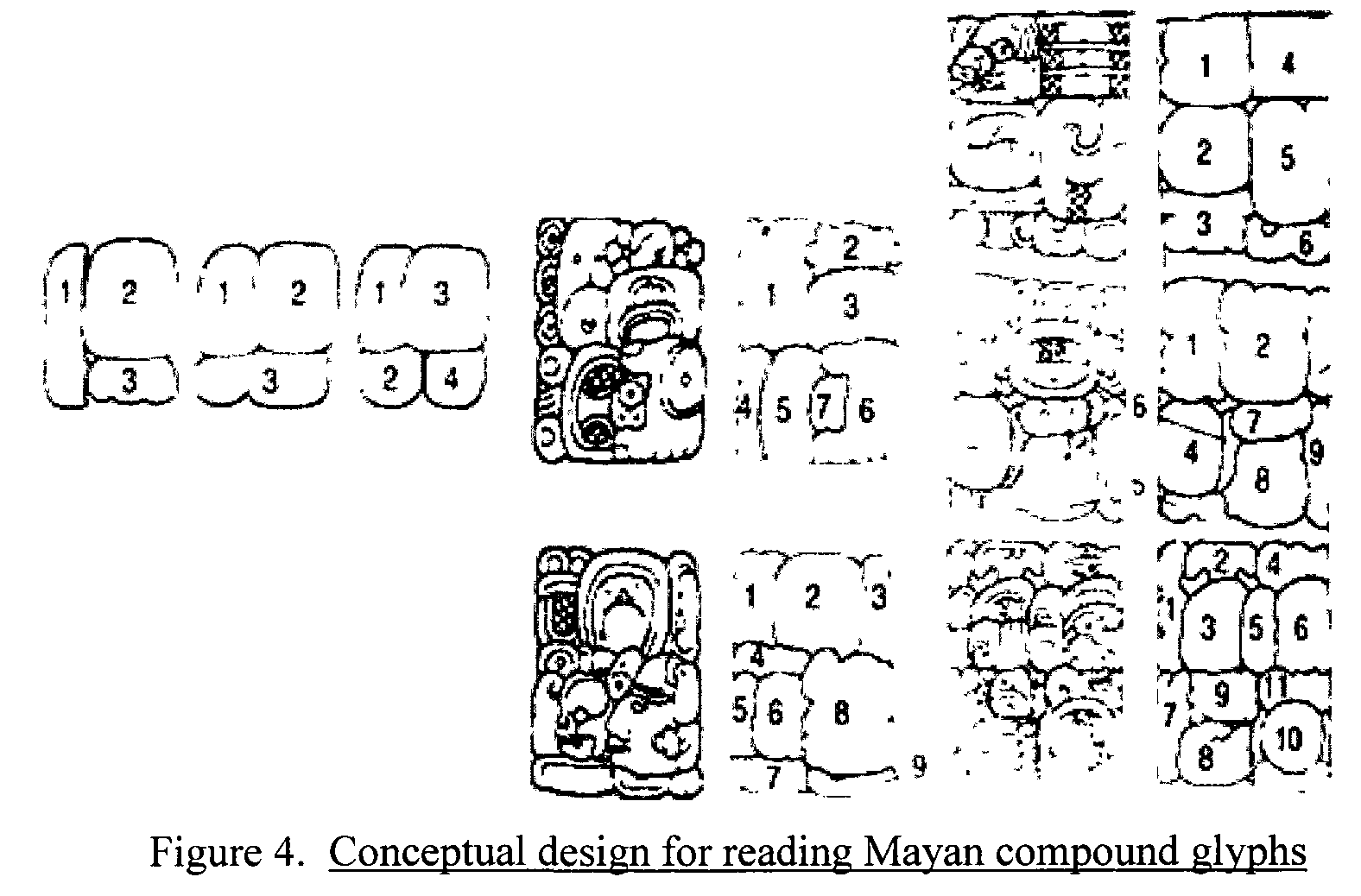
Emperor Fu-Hsi tried to bring all things in the heavens and the earth in the philosophy of the yang and yin.
(it is from the article righteously comparing mayan to chinese)
The book is very to the point (even though it tells "the Chinese never developed a fully functioning phonetic script of their own" ignoring the Bopomofo, which is told to be invented only in the early 20th century, but I am skeptical about it not having any iterations in the past, such as Nüshu, for example. At least there was the tradition of using some regular hieroglyphs as phonemes, and how ancient is the order of placing the labials first, hence the name, which resembles european tradition of placing labials right after vowels 80% of the times, the tradition well forgotten to the beginning of the 20th century, unless it is described in some unknown works of other cultures, so I suspect most of chinese philology to be not ever translated, or either way unknown to the european public)
and it tells (as Knorozov did, as many often tell, and as for blocks of texts like the one in this image it is probably true, but then other forms of aranging the text is shown in it too:

or does it indicate a forgery? Because they often say that's how it goes:

But then it is probably just one of several traditions, just one of many ways to arange text as we also have, and they have plenty of such examples:
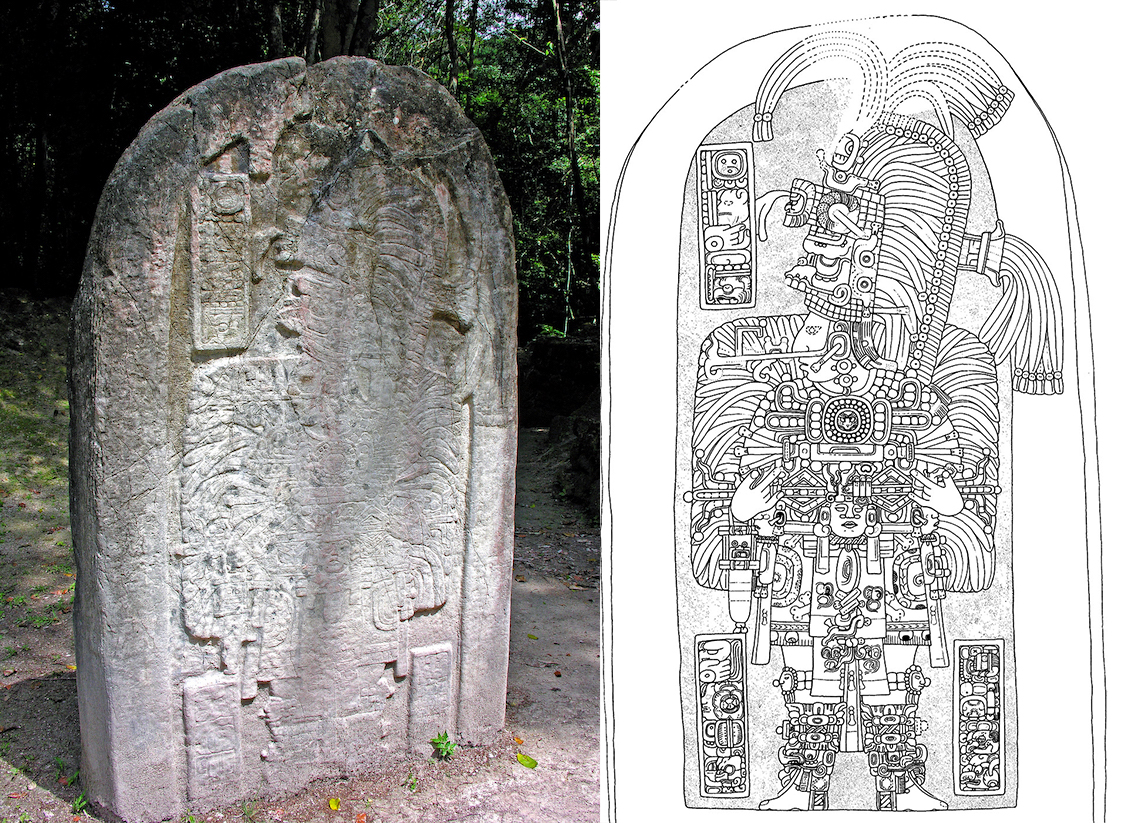
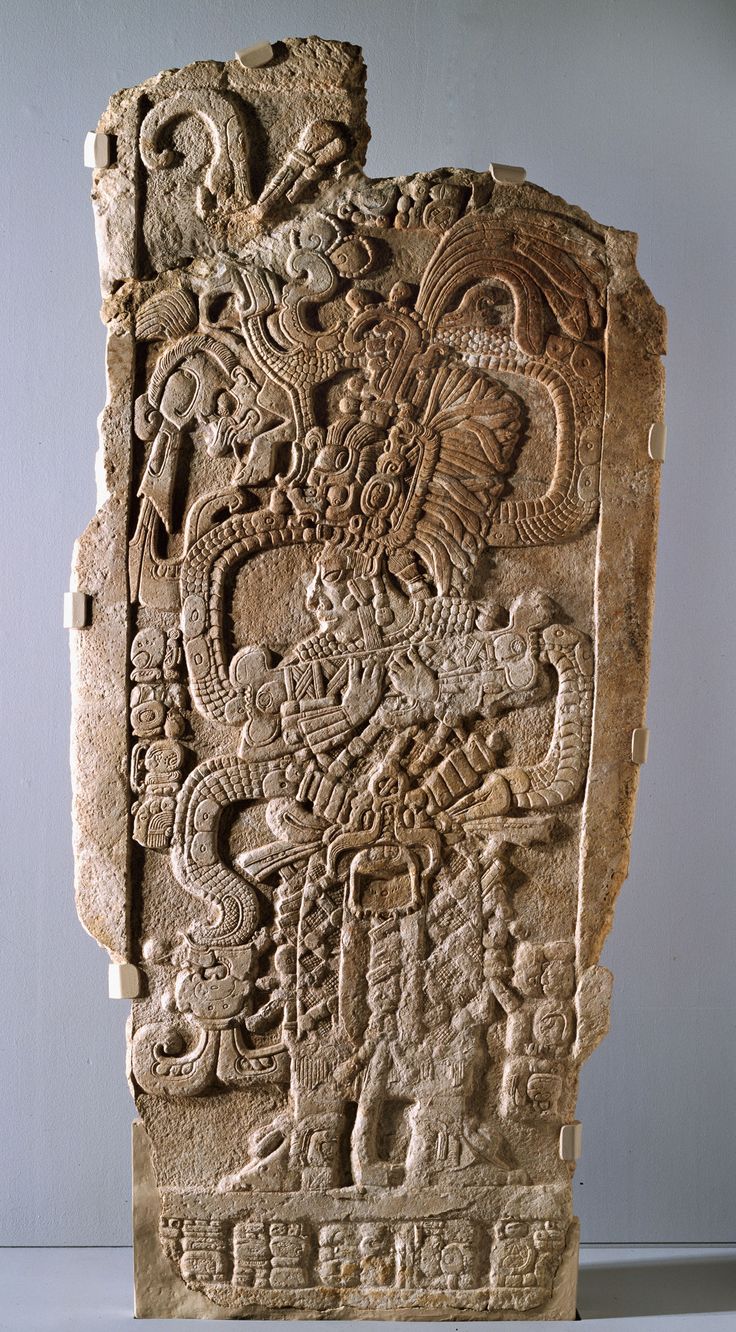


an interesting documentary I will probably return to, using some elements of it for an argument
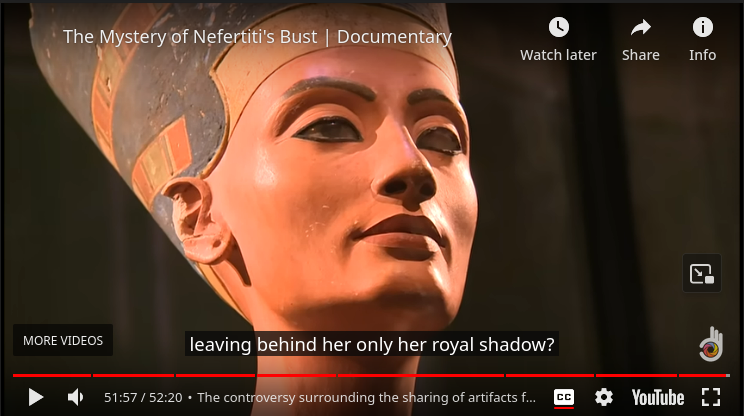
but then I wonder if it's true they cannot carbon-date plaster? It is supposed to contain some microorganisms, but maybe in quantities not sufficient to date it by modern equipment. But then if he found it after it was used, it would contain the microorganisms from the past. The same is true for the pigment. paint. (I wonder if paint a modernized, simplified, clarified, purified form of brutal ancient synonym pigment)
𓄤𓇋𓏏𓏭𓁐 I'm surprised it is the only place this word is used. People should totally return to using egyptian writing system.
IJKLMN
OPQRSTUV
very interesting! and yes, I really need to initiate the creation of pan-alphabetic index of skanned artefacts presenting abecederia. Of all of them? Including the modern ones? What would it take an ai to do it? Somebody else may find it useful for his own research of whatever kind.
Earlier I theorized that ᛵ is i, because it is called is, but in venetic and lepontic it is s, a letter is also has.
Look at east-raetic U, how it reminds ᚢ and etruscan 𐌡, so norsk runes are so ancient, they're more ancient than latin. И это во-вторых (in that booklet, yea)
An interested documentaruy I have watched the other day, speaking of how some artefacts are easily fake, which makes me think that new standards in
Empire, but imperial. was it MPR? closed (and thus male, yang, violent) syllables MP+R?

Emperor Fu-Hsi tried to bring all things in the heavens and the earth in the philosophy of the yang and yin.
(it is from the article righteously comparing mayan to chinese)
The book is very to the point (even though it tells "the Chinese never developed a fully functioning phonetic script of their own" ignoring the Bopomofo, which is told to be invented only in the early 20th century, but I am skeptical about it not having any iterations in the past, such as Nüshu, for example. At least there was the tradition of using some regular hieroglyphs as phonemes, and how ancient is the order of placing the labials first, hence the name, which resembles european tradition of placing labials right after vowels 80% of the times, the tradition well forgotten to the beginning of the 20th century, unless it is described in some unknown works of other cultures, so I suspect most of chinese philology to be not ever translated, or either way unknown to the european public)
and it tells (as Knorozov did, as many often tell, and as for blocks of texts like the one in this image it is probably true, but then other forms of aranging the text is shown in it too:

or does it indicate a forgery? Because they often say that's how it goes:

But then it is probably just one of several traditions, just one of many ways to arange text as we also have, and they have plenty of such examples:




an interesting documentary I will probably return to, using some elements of it for an argument

but then I wonder if it's true they cannot carbon-date plaster? It is supposed to contain some microorganisms, but maybe in quantities not sufficient to date it by modern equipment. But then if he found it after it was used, it would contain the microorganisms from the past. The same is true for the pigment. paint. (I wonder if paint a modernized, simplified, clarified, purified form of brutal ancient synonym pigment)
𓄤𓇋𓏏𓏭𓁐 I'm surprised it is the only place this word is used. People should totally return to using egyptian writing system.
ㄅㄆㄇㄈ [bo po mo fo] notice how po is dashed bo and mor and fo are rotated variants of one another.
Speaking of which, before it, Taiwanese kana existed, which just like bopomofo used that interesting, first known to me from egyptology, which indicates some local tradition:
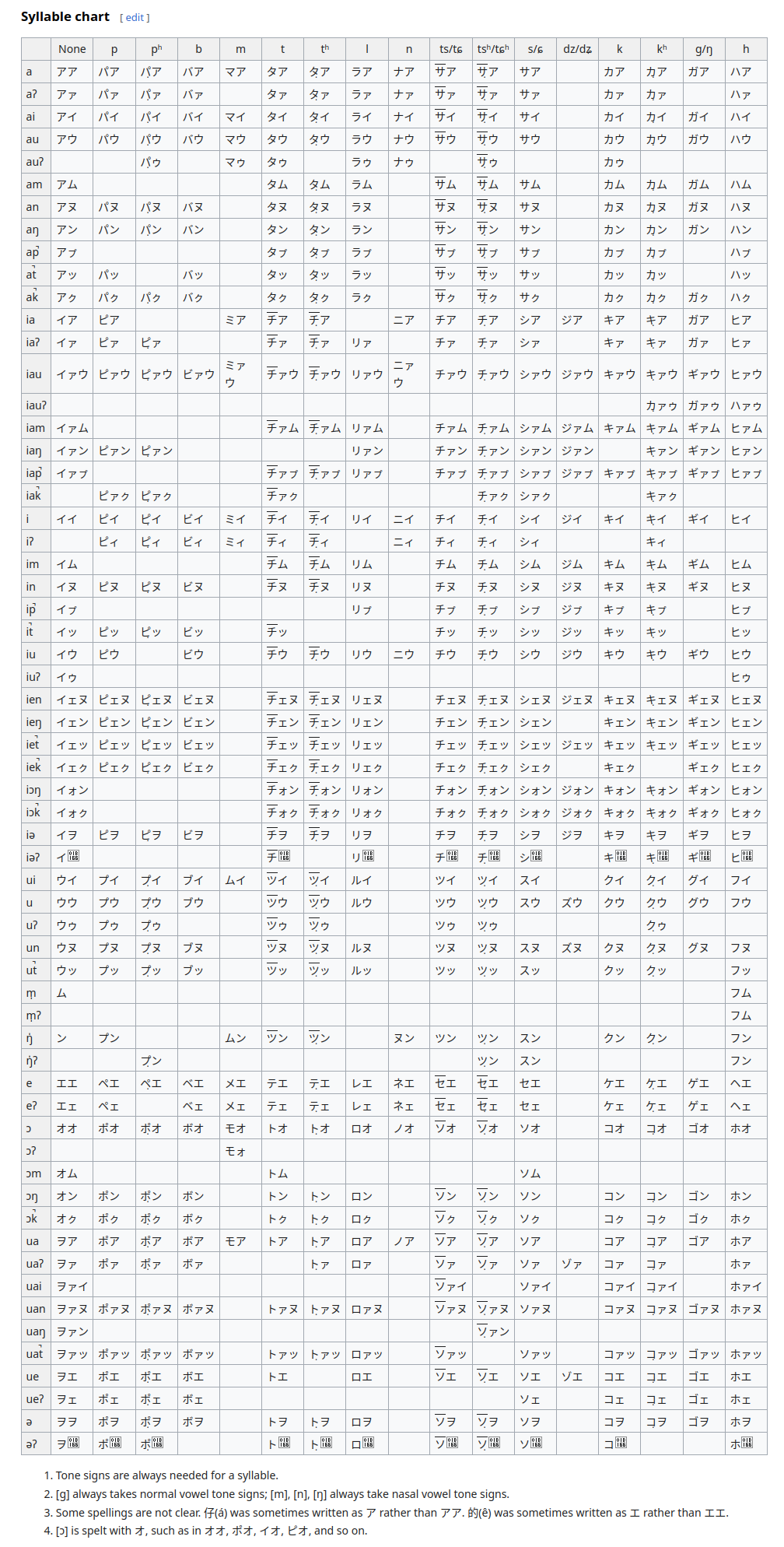
and the closed syllables (notice that in their chart also m and p are the first in their groups)
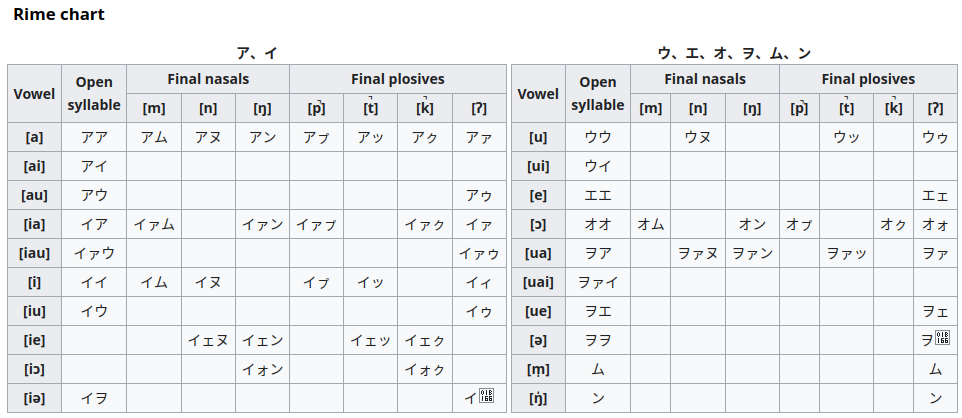
Taiwan lived under japanese rule for as long as russian lived under commies:
A page from the Japanese–Taiwanese Dictionary (日臺大辭典, Nittai daijiten) of 1907, by Ogawa Naoyoshi
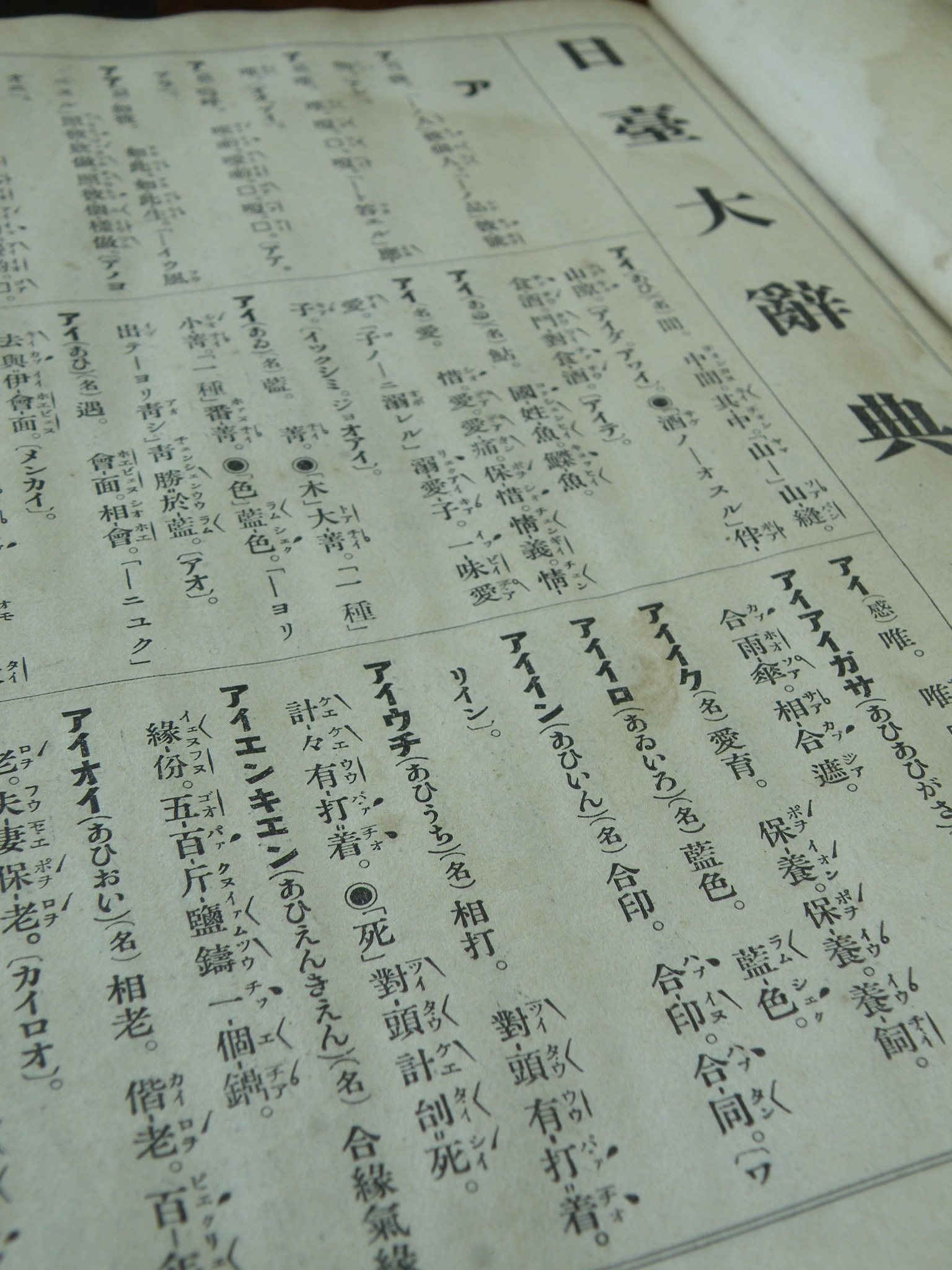
Am I of left hand too? And I remember how I was taught to write by right.
If write and right are cognates, so should be write and left in hebrew, but they're not. And it would be strange: people definitely used to work with both hands, and before central education people who wrote in one hand then'd use the most easy (usy) hand for them.
If europeans wrote in columns, they would write it starting from the bottom-left corner (as a left-handed friend of mine wrote) and if semites did, they would write in their own unique manner, because chinks start from right, but top corner.
But those hebrew words are שמאלה, שְׂמָאלִי, מוּשׁאָר for left, and notice that they all contain m & ш (and russian пиши also contains ш and п~м, and write has this silent w in it, as if it is a logogram, каля-маля: cursive слмл is каля-маля-like:
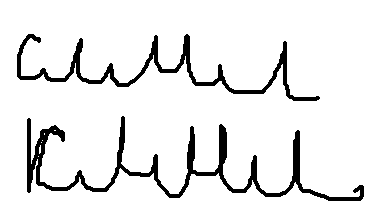 which could give birth to w and ш
forms,
which could give birth to w and ш
forms,for both w and ш are in what and [шо/што] чё/что
h is more important than w, because how starts with it, and hwat it used to be, soft qu it probably is.
opqt dictates that line to be
efhs? s as in russian? the glyphs was known, but they probably pronounced S as Z
if voiced and voiceless so easily transfer into one another, isn't abgd ~ opqt?
if g and д are g, isn't bd ~ pq?
And then I look deeper into it and
שְׂמָאלִי [cмали́] is left, just as שמאלה [smóla], שְׁמֹאל [шмоль]
מוּשׁאָר is left as in left behind
So all hebrew words for that left are samaaelic, and ending with l make me suspect that it is some english word read backwards with some deviation to make it obscurer: m turns into f, ш turns into т
(т has those side serif going down to the ground in cursive and some other fonts, so it is upside down ш)
But then it's just a guess, a game, raw meat.
And this guess immediately resonates right with kabala being abc in reverse. And it was noticed to be european eastern canon of k going first and heads the lingual chunk, after which go b with h heading the labial group, and then go some more lingual, but the queer ones, like l.
(but then this guess rings wrong when I look at yaminaHE ~ right (see few paragraphs below))
Is ᚥ [w] also F? ᚥ ~ ᚠ? It would make perfect sense considering how ᚮ may go upwards with those sticks strokes too. It would be convenient to know this reading runic text going in reverse boustrophedon, and then ᛆ and ᚿ meet in ã, explaining thus why prefix "a" is "un", which is "not"
is фoo the boo a stronger no?
Is ᚦ да? как рука подзывающая к себе, а не обращённая ладонью вперёд (словно зига это стоп)
И думая о ладонях, я вспоминаю как еврейский талисман выглядит перевёрнутой зигой, но хамса (так этот талисман называется) может работать в обе стороны, и совпадает с тем, как я видел, что рука понятая вверх пальцами означает нет, а ладонь пальцами вниз даёт или просит, в общем дай и да, что и д в да означает: сверху запястье. Тогда d внезапно становится антонимом а, which used to be q-like in the past!
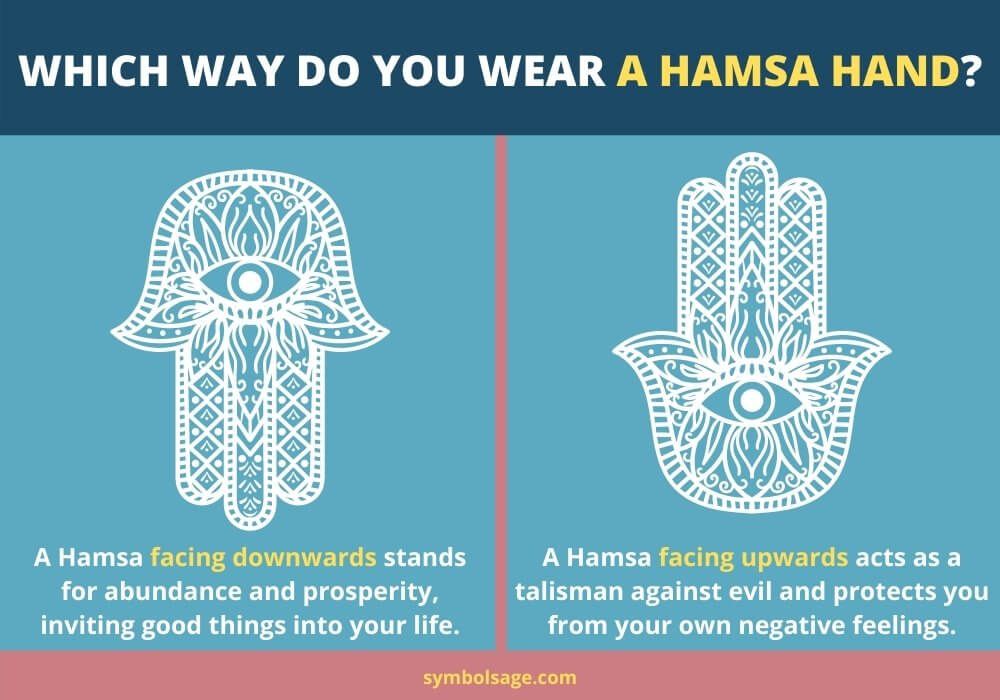
But then why would that right is ימין[ями́н] יָמִינָה[ями́на] (also it is interesting that "to right" has meaning of to fix, to correct, as the opposite of left as in "to leave")
So why ᚥ looks like that giving hamsa, when I just speculated that it is boo? I guess I speculated wrong. I don't erase anything, well, almost, because I demonstrate how I find or produce the diamonds, by guessing, by testing, by applying different approaches.
I helped Carlos Pallan with mayan unicode, and now we have a conversation:
Hello Dmitrij,
I am glad to hear that you found the thesis by Simpson useful.
You make a valid point about Bopomofo. The author should have mentioned it. Even though it was introduced at such a late stage, as you point out, there is no question that almost all of its characters derive or were abstracted from ancient Chinese ones (ㄅ from 包, ㄋ from 乃, and so on...).
About glottochronology, most historical linguists I know are very skeptical of it. My understanding is that it can gives us (at best) a relative sequencing of branching events (e.g. the "split" of Ch'olan into Eastern and Western branches, etc.), phonemic shifts and "innovations", but it would be mistaken to rely on it alone in trying to "date" these events in a timeline with absolute precision.
how exactly do we know that they "first begun to record the deeds of their people two thousand years ago"? Is it true for regular stones?
It's probably a bit more than that, I would say, at least 2,300 to 2,500 years (since early Maya writing testimonies begin to appear).
Even though we cannot date the stones per se, ceramic artifacts (e.g. via thermoluminescence), constructive phases, iconography, and often also organic materials (e.g. via radiocarbon or dendrochronology) can help us secure a date range, sometimes ± 50 years or less.
Attached is an excerpt from a feature in Science magazine about early writing at San Bartolo, Guatemala, on how it was possible to date the context containing this stone block (in this case, by association with organic materials, thus by radiocarbon tests).
Is there something like abecedary within corpus of mayan texts?
No, to my knowledge, no such "abecedary" or "alphabet" (for the case, a syllabary) has ever been found.
The closest thing to it would be a text that only contains syllabic sounds, without any "logographs" or "word-signs", which you can check out here: https://www.mayavase.com/com8885.html (mirror)
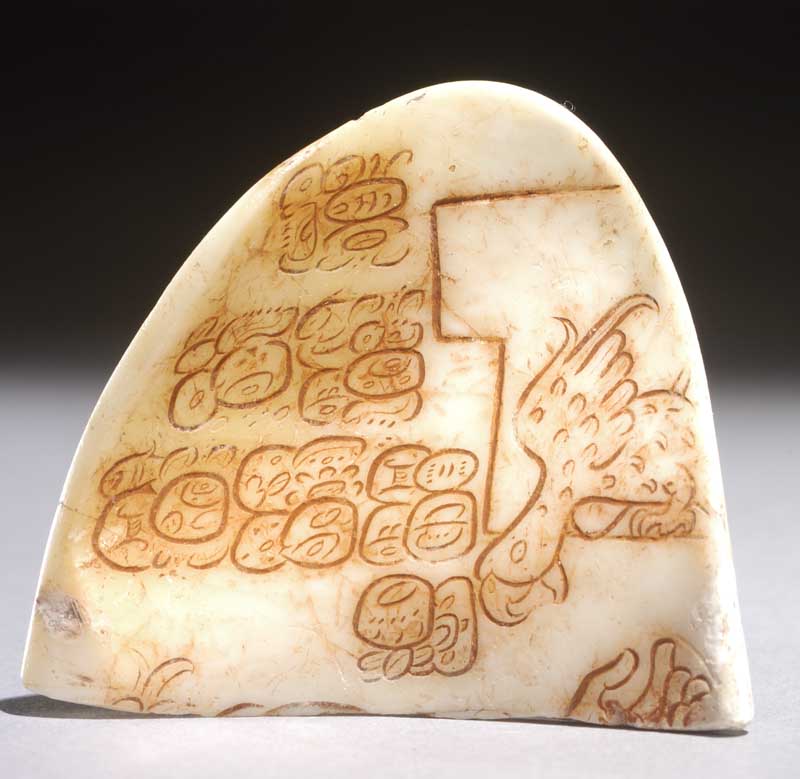
It is very spectacular because indeed it has few or no repeats, that I have to check, and I dig in:
From David Stuart
An important and gorgeous text, though murky in so many ways.
I can already see some very odd verbal forms, and perhaps some new lexical items.
One in the third block is me?-te for met, which is given as “crown” in proto-Ch’olan. Here’s a quick transcription:
a-wu?-le-li-ya
ti-ni-?-la
me?-te- a-a-la-ni
o(?)-po ya-[la]a-ji-ya
hu-b’i U-ju-chi
2po-lo tz’i(?)-i
b’a-ch’e-b’u
Generally I have a hard time with the whole thing,
but it seems that the owner of the shell (juch) may be named Popol Tz’i’,
and he carries that scribal B’aah Ch’ehb’ title.
Also, there’s a good possibility that there’s a 2nd person a- pronoun in the very first block,
and I like the presence of the possible wu syllable right afterwards, to give the transitional consonant,
possibly in something like: aw-(h)ul-el-iiy.
This could be a split-ergative form, but this is something we’ll all need to discuss and consider carefully.
It immediately strikes me that A opens the sequence, and it is followed by labial wu and then thomething not too far of d comes in two shapes, le and li, and after them goes ya, which is easily vowel, and then ti ni as something along ΖΗΘ (whether n is h or z, both work well) and the ? is probably yud, followed by la and me, as l and m follow i in european alphabets. And then te which is just between n and samekh. And then it repeats again with double vowel, and not la me, but la ne, maybe indicating another variant (as I said, lines are dialects, variants as opq× is just whisper of abgd. Shape of letters is hand gestures (people of the past didn't have much to study, so they bnaturally studied gestures of deaf, they naturally could communicate with hands)) and tgeb i then o p made me sure that it is the abecedary, even if technically it is syllabary (s~c~k l~d~t b ry is how it goes in eastern syllabaries: sdbry (and as such it has l at the left end and r at the right one))
Trying to identify the glyphs according to the transliteration I copypasted, I think I managed to see a (the one in the middle in both tables) and I can see how it tells a, only a is upside down in comparison:

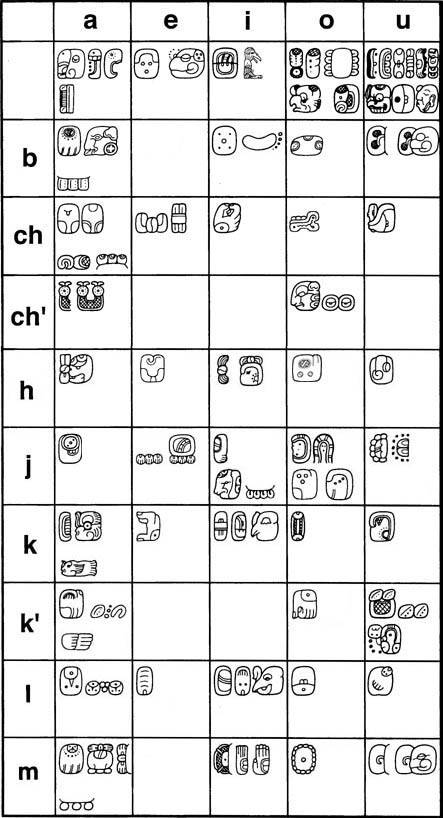

To my awe ya in the a-wu?-le-li-ya looks like её
Comparing tragic and magic (suffering as a prayer is magical ritual I think I mentioned, см типа рамаяна and )
Playing with mayan, I find an interestyng glyph:

it is about both kill, хам, א, ࿊

And so I played with that writing, and I think I figured out the most of it:
(scroll the page aside,
there is the attempt of figuring it out)
Now it doesn't look like the symbols are not repeating, either
way, I shared this attempt and the hypothesis with Carlos, asking
for help with the fourth word (the one in the bottom left corner)
we'll see what and if he responds to it (my guess is he will, he
seems to enjoy the discussion, and he probably is grateful for my
interest to his work, not many are such autists, lol)some suffixes are the same: ing ~ ion
olive ~ o live!
My name is D (people know this as Demon, Devil, Dracula)
I should name my books in single letters, so authobiography shouyld be I, and the other iteration of booklet may be A. unless A is some other book, and booklet is already viowel enough.. I think of my site, the site's name is the real name of the book. It is where it exists online. And the booklet itself is not vowel yet: abnd people know it as both the cover says abcd and АБГД and in previous iteration it had on it's корешок ΑΒΓΔ ევზთ ILMN עפצקרשת, and the title page names it ა ბ გ დ and I registered it as АБГД so it has three to five names if you look at it in whole, and two to three names if you look at it as an object. But then I didn't count aeiou.nu and aeiou.ru, so 7 names it has. One object. Very godly.
Autobiography should be written with every little shameful detail, as the map of memory, filled as I recall new details, as to how to treat an organism so it may grow into something like me. What I remember has built me. And I think it will turn into a tool, allowing to remember details I would never recall otherwise, or were them? If I mark my memories written, maybe they will not bother me anymore. I start this process tomorrow, working on that kind of text only when I'm sober. So they don't deviate as much. And now let's deviate as we love to do, especially when high. Hi.

Can this set be alphabwetic? Being separated into words and not very much beginning with vowels, it still starts with a and o every other line. And those two are two halves of the alphabet. and
vowels are a-ya-aa-o-ya-a-ya-U-i
(I marked ya grey because I don't know if it is not a j-syllable, but then I can see её in that ya, I took it as eё because of that position.
La repeats twice in its line, and not in others,
Po repeats twice in its line, and not in others.
её repeats in three out of four, and is it normal connecting letter or is it not abecyllabary but pangrams, pangrams repeat letters, and pangrams are not abecedarias, the order can be different. Even though hi, no, stuv would be nice as stuff or staff, for it's stuvw, but no, only hi (yes in japanese) and no.
I don't know about it, the way he sings it sounds like shit, why would something like that appeared in the first time, and why would it become so popular he calls it the first text of the european culture? And righteously he does. A poem about a war, seriously? but then the way he pronounces it around 9:00 is almost bearable. Reminds me of "walk like egyptian dance" when dancers probably waved their arms up and down, and artists could picture them in the positions of extremum, and readers misunderstood his drawing. Probably something like this is in the greek poetry.
But if this sequence of longs and shorts continue, it is definitely something noteworthy.
And it doesn't seem it does:
μῆνιν ἄειδε θεὰ Πηληϊάδεω Ἀχιλῆος
οὐλομένην, ἣ μυρί᾽ Ἀχαιοῖς ἄλγε᾽ ἔθηκε,
πολλὰς δ᾽ ἰφθίμους ψυχὰς Ἄϊδι προΐαψεν
ἡρώων, αὐτοὺς δὲ ἑλώρια τεῦχε κύνεσσιν
5οἰωνοῖσί τε πᾶσι, Διὸς δ᾽ ἐτελείετο βουλή,
ἐξ οὗ δὴ τὰ πρῶτα διαστήτην ἐρίσαντε
Ἀτρεΐδης τε ἄναξ ἀνδρῶν καὶ δῖος Ἀχιλλεύς.
τίς τ᾽ ἄρ σφωε θεῶν ἔριδι ξυνέηκε μάχεσθαι;
Λητοῦς καὶ Διὸς υἱός: ὃ γὰρ βασιλῆϊ χολωθεὶς
10νοῦσον ἀνὰ στρατὸν ὄρσε κακήν, ὀλέκοντο δὲ λαοί,
οὕνεκα τὸν Χρύσην ἠτίμασεν ἀρητῆρα
Ἀτρεΐδης: ὃ γὰρ ἦλθε θοὰς ἐπὶ νῆας Ἀχαιῶν
λυσόμενός τε θύγατρα φέρων τ᾽ ἀπερείσι᾽ ἄποινα,
στέμματ᾽ ἔχων ἐν χερσὶν ἑκηβόλου Ἀπόλλωνος
15χρυσέῳ ἀνὰ σκήπτρῳ, καὶ λίσσετο πάντας Ἀχαιούς,
Ἀτρεΐδα δὲ μάλιστα δύω, κοσμήτορε λαῶν:
Ἀτρεΐδαι τε καὶ ἄλλοι ἐϋκνήμιδες Ἀχαιοί,
ὑμῖν μὲν θεοὶ δοῖεν Ὀλύμπια δώματ᾽ ἔχοντες
ἐκπέρσαι Πριάμοιο πόλιν, εὖ δ᾽ οἴκαδ᾽ ἱκέσθαι:
20παῖδα δ᾽ ἐμοὶ λύσαιτε φίλην, τὰ δ᾽ ἄποινα δέχεσθαι,
ἁζόμενοι Διὸς υἱὸν ἑκηβόλον Ἀπόλλωνα.
ἔνθ᾽ ἄλλοι μὲν πάντες ἐπευφήμησαν Ἀχαιοὶ
αἰδεῖσθαί θ᾽ ἱερῆα καὶ ἀγλαὰ δέχθαι ἄποινα:
ἀλλ᾽ οὐκ Ἀτρεΐδῃ Ἀγαμέμνονι ἥνδανε θυμῷ,
25ἀλλὰ κακῶς ἀφίει, κρατερὸν δ᾽ ἐπὶ μῦθον ἔτελλε:
μή σε γέρον κοίλῃσιν ἐγὼ παρὰ νηυσὶ κιχείω
ἢ νῦν δηθύνοντ᾽ ἢ ὕστερον αὖτις ἰόντα,
μή νύ τοι οὐ χραίσμῃ σκῆπτρον καὶ στέμμα θεοῖο:
τὴν δ᾽ ἐγὼ οὐ λύσω: πρίν μιν καὶ γῆρας ἔπεισιν
30ἡμετέρῳ ἐνὶ οἴκῳ ἐν Ἄργεϊ τηλόθι πάτρης
ἱστὸν ἐποιχομένην καὶ ἐμὸν λέχος ἀντιόωσαν:
ἀλλ᾽ ἴθι μή μ᾽ ἐρέθιζε σαώτερος ὥς κε νέηαι.
but then maybe they do, dactylic hexameter is som irregular bunch:

But then here's the explanation:

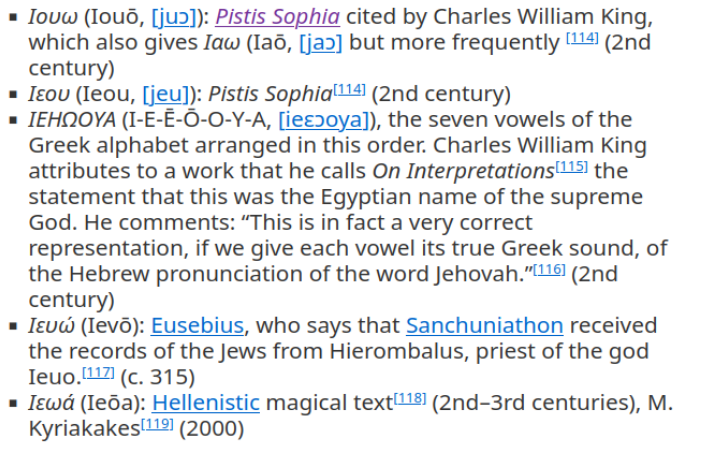
by checking frequencies I can see that they all agree on I, 4 out of 5 agree on E, that the third is U only 2 agrees, 2 tell it is o, but one of those follows it with a, so it agrees with ieuo that the direction is upwards. Actually IEUO ~ IEOA is the sequence I found: two sequences agree that the final is A, and one of them doesn't go as far as u at all, which may me want to look at that one, because archaic alphabets had only four lines with U not yet developed out of labial V (which the position of the vowel letter tells) but then two tell it is o, and one goes even as far as u, but that u is fishy:
jew
So should I trust it? Or is it this way? IEOU? it is chromatic.
All the other (4 out of 5) agree on that raise at the end. So IEUO or IEOA they're, and because the four archaic rows start with AEI and O, IEOA it is, also because it sounds as IEOwA
And this is when I figured it out to IEOA (because read the name of the other image above, it's ieuo)
The first case also give iao̅ (in agreement with dactylic hexameter) but here a is probably e, but then who knows, it could be greek name of god in some specific dialect.
brother is of broth (how could it be that I never knew that shorter word? because it is colloquial and archaic, maybe?)
I found this word in this magnificient video:


выкупить за копейкy y[u]
вырубить за рубли y[i]
u as uno (unu, одно (u and од~ед as transliteration of the same? and is the word))
i as inые (ini, any, many)
and as one? because if there was numeral, it would be understood without that comma of and:
12 cows 14 sheep 3 horses
a cow, a sheep and a horse ~ a cow, a sheep, a horse ~ cow and sheep and horse (but this is without numerals. That's right, it is in general the animals he keeps) ~ cow sheep horse sounds as a fantastic animal.
many ~ me and y (me and they? me and any? an y? plural one, ones, others?)
many ~ manы? men?
pondering on LiebeUral I though of how U is ух (ухнул в проастъ)
пропасть всем пастям пасть
Если ты живёшь внизу, то горы для тебя ᚢ.
Если ты живёшь на горе, то горы для тебя V (горЫ, две горы видишь. W: три горы, каждая гора видна в контексте)
ᚢ is of strange form, but then is it?

Nordkapp
Самая северная точка острова Медвежий в Арктической Норвегии, расположенная на северной оконечности острова. Мыс находится примерно в 230 км к югу от Серкаппа, Шпицберген, и в 415 км к северу от материковой Норвегии.

Preikestolen or Prekestolen (English: 'The Pulpit Rock', 'Pulpit', or 'Preacher's Chair') is a tourist attraction in the municipality of Strand in Rogaland county, Norway.
it seems that is how fjordir look
Libra Litera
Sun is gün in turkish and turkmen, which reminds of C being read as S in russian and G in old latin:
Gaius is an archaic Latin name and one of the earliest Roman praenomina. Before the introduction of the letter 'G' into the Latin alphabet, i.e. before the censorship of Appius Claudius Caecus in 312 BC,[7] the name was only written as Caius.
буква ~ booked?
если ва в буква то же что и в правдива, то правдивая история не только содержит правду, но и принадлежит правде (не содержит неправды (и по сути, по смыслу так!))
буква is of book
of becomes ва the way to becomes ть?
оf me ~ маева́ (моего́)
of you ~ твоего [тваева] Was г introduced as a form of в?
of him ~ [ева́] его
of the children детёва дитёва (обрати внимание та чередование е и и: дитё, но дети) разговорнео и неплавилнае, но вполне русское, ибо а какое же исчо
лева принадлежащее L? это наша левая рука с кистью внизу или поднята гверху? becausae r ~ г can be seen as the opposite of it only when the text is rotated 90 degrees forward.
And now I can understand why forward the clockwise is lucky: because if you're early you can wait and it (the late) will come to you. And if you're backwards, your clock is lagging, and you may come when it is over.
слова Levo & PRavo indicate PR as a claster. (russian R is Р)
is PR purr? pussy and рысь
but L is also ..𓃭, but it seems they retransliterated it as rw
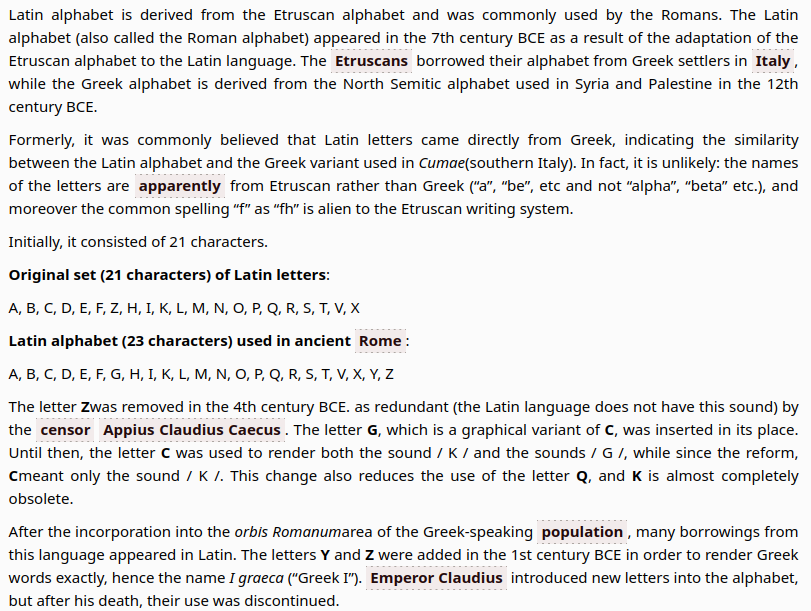

automatic subtitles misheard life as wife, and it is interesting, because in russian жена и жиза(жизнь) очень похожие слова, and "my life" is a normal standard compliment a man can give to his wife.
I sent my suspicion of that phonetic writing to be related to alphabet's sequence, now I hope he doesn't take me for insane (after all he did send me that writing as a special one, that if such sequence exists, that could be one of them, because, as he said, it is rare that no logograms are present in the mayan text)
Either way, if he doesn't responds in few days, I'll write to him that since I found arapacana, I am convinced that all the writing systems are related.
Meanwhile I tried to translate the mayan writing, and foun the first word in few ocassions:
458. Witness ZAP was at Rosalie Gicanda’s house in April 1994.1172 On 20 April, around
noon, many soldiers arrived at Gicanda’s house. 1173 Witness ZAP was with Gicanda in the
garden of her residence, which was located at the Ngoma commune office. 1174 Inside the
house there was a woman called Mukadi, who was sick, Jean Damascène Paris, Alphonse
Sayidiya, Marie and servants called Awuleliya, Callixte Kayigamba and Anastase.1175 Some
soldiers climbed over the fence because the gate was closed, and then opened the gate for
those still standing outside. 1176 The soldiers surrounded the compound, while others climbed
trees. 1177
So Awuleliya is a personal name, it is very interesting, but I don't know names starting with abc, unless bud is one, unless it's buddy. And thinking of buds I want to smoke some, but them I decided not to smoke, since yesterday weed placed me in a fine place of unusual productivity beyond this thing (I drilled, and glued, and translated, and probably did something else. So I hope that I accidentally tuned my preferences into the productive mode I'd rather keep on. And I will return to this thing, and it will probably be less deep, but more coherent. But then we'll see how well this cessation is in place.
But then here a guy tells that it has no logographs:
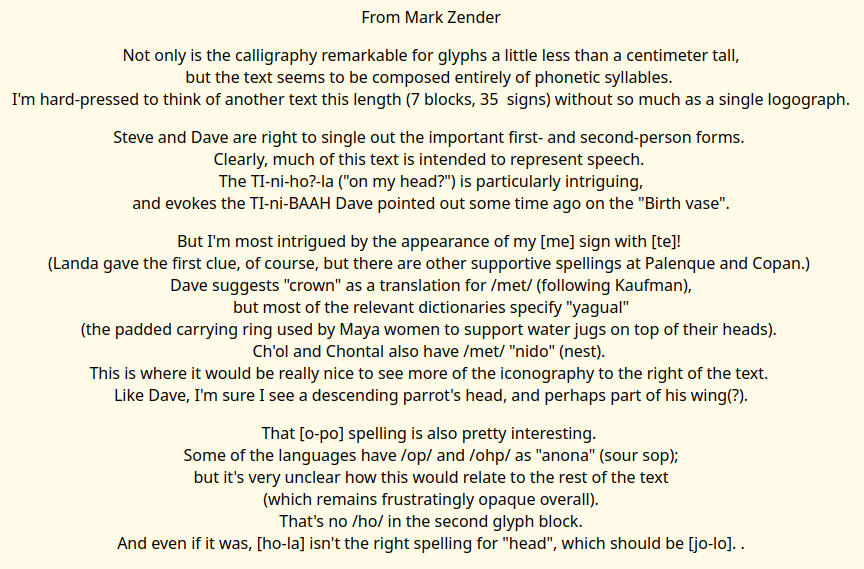
They are also puzzled about the meaning of the text, which may support my point of view.
And soon I figured out that Awuleliya is not mayan, but Rwandese name. So just a coincidence? What a weird coincidence indeed, but then they're bound to happen.
And then I tried yandex instead and it gave me a better result. Awuleliya means something in Xhosa:
“Ngoko ke, bendisoloko ndizama ukusebenzana neemvakalelo zam. Kwaye ikakhulu ndiziva ndingcatshiwe, kunye nokuba uthethe ubuxoki kum.” Ilizwi lakhe elibanjiweyo laphakama enomsindo: “Kwenzeka njani ukuba ungandazisi? Bendisazi ukuba awuleliya kholwa limandla – kodwa le!”
“So, I've always tried to work with my emotions. And mostly I feel betrayed, and that you lied to me.” His hoarse voice rose in anger: “How come you didn't inform me? I knew you weren't a strong believer - but this one!”
So I pressed more, and found that in Zulu awuleliya is "you do not listen" and in Xhosa too. At least if google translator is not disinforming me, but that translation looks almost too good to be true.
Ро́динаRU (motherland) is actually роди́наUA (family) so just another manipulation such as "братья и сёстры"
(high, hi again) and I forgot the thought I was going to tell. why these remarks? stope en, I'm on and off
I
oh yes, I told you И is い:
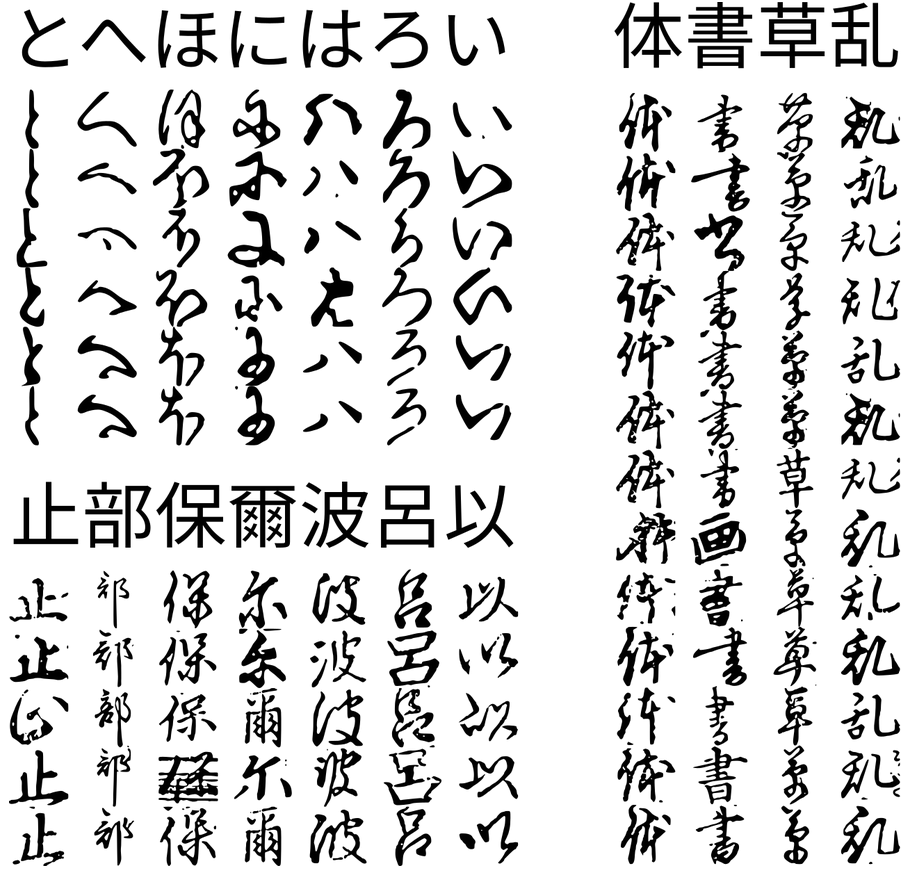
some symbols are straigh direct substituted with synonyms or what are some of those
detski olthoglaphi leveals (reveals by levelling, to level with a lever (lever is level the leveller (to separate the measuring tool and the raising tool)))
After writing in kiddi russian in latin alfa
W makes perfect sense as double V, and being such it proves that archaic V is not u, but v, maximus is modern reading, try reading it as maximvs and you get the actual latin translation. maximvm is максимовн? максимовм? максимвм? or did v turn u in the presence of m? magus is natvrally магус нот магвс us как вс? it makes no sense
(so does it or does not make sense? W being long v, after I wrote ч as tt, ш and щ as ss, ж as zz, often making them lingle single)
utero ~ uretro, let's use word womb from now on. especially because шар looks like wap
(and the moment from mr. oizo's flat beat can be used as if he promotes our thing)
claws close and glews (claws close (with s this time, are verbs with s the initial ones, the consistent with plural s? does is not one of those? oh, so probably.. no)())
(because c used to be read as g (but was it in the english period?)) tell that c is co, to, and l is lay, so glew is прикладывает ~ приклеивает (but is разведывает ~ развеивает? да! развеивает туман для командования, развеивает предположения, фантомные представления)
а если бы говорили наследывает? было бы наслеивает? наслаивает на своё имущество ещё имущество? но говорят наследует.. значит приследует прислеивает? приклеивает? удобный спос преследования человека приклеить к нему бумажку? как в фильме М можно
I sent two letters to Carlos Pallan:
№1:
Hi Carlos (because you changed Hi to Hello, made me think that "greetings" is too formal, like greetings, earthlings)
That saying of the parrot, transliterated by somebody as
a-wu?-le-li-ya
ti-ni-?-la
me?-te- a-a-la-ni
o(?)-po ya-[la]a-ji-ya
hu-b’i U-ju-chi
2po-lo tz’i(?)-i
b’a-ch’e-b’u
blew my mind by that it begins with A, followed by Wu labial as B, followed by le and li, which is not far from both Г and D, and then goes ya, which is not only not too far from e, but even looks like её (as they have it in russian) but then I notice that some glyphs repeat, which shouldn't be happening, if it is some short basal syllabary, but sequence of o and p makes me believe, but I don't know what I believe, the more rigorous part of me tells that I have some severe case of apophenia.
And I also failed to find one of the shapes in the tables (it's in the bottom left word, I used empty square instead of it (I attach my attempt))
Best regards and plenty of gratitude,
Dmitrij (I only learn the epistolar etiquette, I will learn to finish my letters less abruptly)

№2:
I changed rigid to rigorous in "the more rigorous part of me tells that I have some severe case of apophenia." but rigid was the right word, my rigorous part only informs me on the possibility of apophenia in every untested hypothesis.
And though this hypothesis is off-the-wall bold, since I discovered arapacana, I believe roots of alphabetic structure to be so deep that they can be in the basis even of hieroglyphic writing. It is weird that I noticed the first candidate to such writing in hieroglyphic texts neither in egyptian, nor in chinese, but in mayan script (I may well find it in those other two if I find specialists of your level in those fields, maybe you may be interested in working on this hypothesis with me, because it's more likely that you find those colleagues than I)
You may ask "I thought you said that the text shouldn't have repetitions?" but then magical alphabetic sequence abracadabra looks as if it bastardized ABaCaDaBra, where western sequence ABCD is merged with eastern sequence CDBA (the way syllabaries go in India and Japan, amongst others) and then this sequence has repeats but is still an alphabetic amulet, and alphabetic amulets is not my invention, I read about them. So technically this language of birds (language of vowels, language of gods) can represent some magical formula, since guys on that site have problem with understanding it, and I think the most repeaking symbol (the one I jokingly compared to её) is y the "and"? Because "and" can be used in abecedarias for rhythm: "..uvwxy&z" and other repeating glyphs repeat in the same lines, so those words could be variants of the same phonetic sequence (similar to european variants efgh, εζηθ, еёжз) and then around 16 glyphs, which is just enough to be used as an alphabet, and it could be showing how the bird doesn't understand what it is taught to repeat)
(I solved the episotlar anxiety by returning to starting and ending my messages abruptly, I hope you don't mind (and if I'm too weird (I also dropped my uni to keep on learning, so I cannot explore this project properly on my own) so please ignore this message, I will understand, and wish you all the best anyway, I really want to be able to integrate mayan unicode into my work))
Now you may see why I didn't succeed to make this thing known, working on it openly for a decade, well, probably that is how much it takes people to master the skill of persuation. I read it took Mendel two decades to rexplain what he found to the world.
continued in vol.31
...
